
Books And Travel
Jo Frances Penn
Unusual And Fascinating Places Plus The Deeper Side Of Travel
- 21 minutes 13 secondsThe Call To Pilgrimage, Resilience, And Embracing Challenge With J.F. Penn
Why is resilience such an important part of pilgrimage? How can embracing the challenge of the way help in daily life? Why do we need to heed the call to pilgrimage before it’s too late?
I’m Jo Frances Penn and in this episode, I share some clips from podcast interviews I’ve done around my new book, Pilgrimage: Lessons Learned from Solo Walking Three Ancient Ways. Thanks to Travel Writing World with Jeremy Bassetti, Into the Woods with Holly Worton, and Sacred Steps with Kevin Donahue, podcasts you will enjoy as listeners to this show.
As this goes out, Pilgrimage is available now in a special limited edition signed hardback, as well as a paperback, ebook, audiobook narrated by me, large print edition, and a workbook.
In this episode, I talk about:
- Which were the three ancient ways I walked and why they’re interesting even if you’re not religious
- What I learned along the way
- The three types of energy you need at the different stages
- How pilgrimage reminds us we are animals, and how it gives a much-needed perspective on life.
In this first clip from the Travel Writing World podcast with Jeremy Bassetti, I talk about the specific pilgrimages I walked and why they’re interesting, even if you’re not religious.
Jeremy Bassetti: The book is called Pilgrimage: Lessons Learned from Solo Walking Three Ancient Ways.
What were the three pilgrimage routes that you took during your walking adventures?
Jo Frances Penn: So, I did the Pilgrims’ Way first, which is from Southwark Cathedral in London to Canterbury Cathedral in the southeast of England. And that’s the route of The Canterbury Tales, which I’m sure people have heard of, medieval tales by Geoffrey Chaucer and it was about visiting the shrine of Thomas Becket who was martyred under Henry II.
And it was the pandemic and it was also the 850-year anniversary of the Becket martyrdom. So that kind of helped me decide to do that one. I couldn’t go and do the Camino during the pandemic because of course we couldn’t travel. And also, I’d highly recommend it as an easy route for a first multi-day solo.
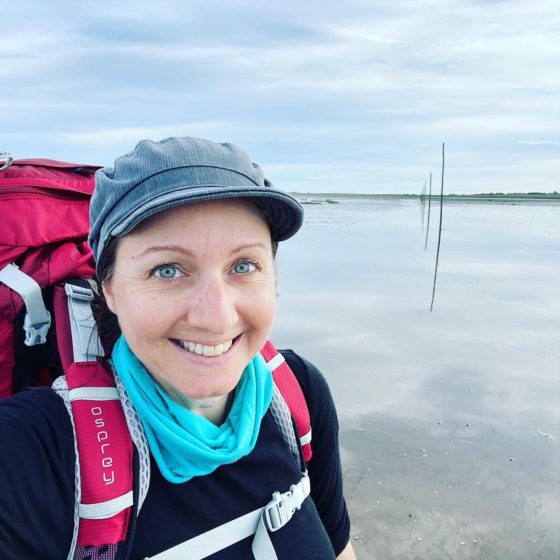 JFPenn on the sand crossing to Lindisfarne
JFPenn on the sand crossing to Lindisfarne
Then the second one was the St Cuthbert’s Way from Melrose in Scotland to Lindisfarne, Holy Island on the northeast coast of England. And St. Cuthbert was a medieval monk and a bishop. And, I wrote about Lindisfarne in my thriller Day of the Vikings, so I really wanted to do that and that was a spectacular route. I highly recommend the Cuthbert’s.
Then finally there was the Camino, a goal I’ve had for several decades, and I did the Camino de Santiago Portuguese Coastal route from Porto in Portugal, up to Santiago De Compostela. I feel like the Camino is quite mythical for many people and certainly for me.
And when I had COVID the year before, in 2021, and I was really sick and I realized that maybe one day I would not be able to walk — obviously at some point none of us will be able to walk, right, we will be dead! — and I thought, well, if I don’t do this now, maybe I’ll never do it. And I have said I wanted to do it for many years and now I’ve got to do it.
So I committed and I’m so glad I did that route finally, and it really enabled me to finish the book, but yes, those were the three.
Jeremy Bassetti: So I mean, these three pilgrimage routes that you mentioned here, that you went on, all have religious connotations, but you mentioned in the book that you are more secular-minded.
How have you come to understand the act of pilgrimage from this secular position or perspective?
Jo Frances Penn: Well, I am not a Christian, although I have a chapter in the book about my faith history. Many of us have this faith history by midlife, you know, an experience of finding God and losing him again or whatever that means to the individual.
But I’m certainly spiritual. I consider myself spiritual and I mean, you talk about genius loci, the spirit of the place. And I absolutely have had moments of connection with whatever we want to call it, the universe or God if you want, in different places. And certainly did on these routes too.
So while I am secular — as in I don’t adhere to a particular religion — I absolutely respect people of faith. I have a master’s degree in Theology, and pretty much all my fiction is based on religion and I love religious places.
What is wonderful about these pilgrimage routes, these ancient ways, is that people have walked these particular routes in Europe for a thousand years, and that’s what gives them a lot of resonance.
It also means they’re packed full of amazing churches and cathedrals and beautiful architecture. And I love architecture. I’m a super fan of architecture. So I guess the pilgrimage aspect is both the walking from here to here, the historical side of it, and the beautiful places along the way.
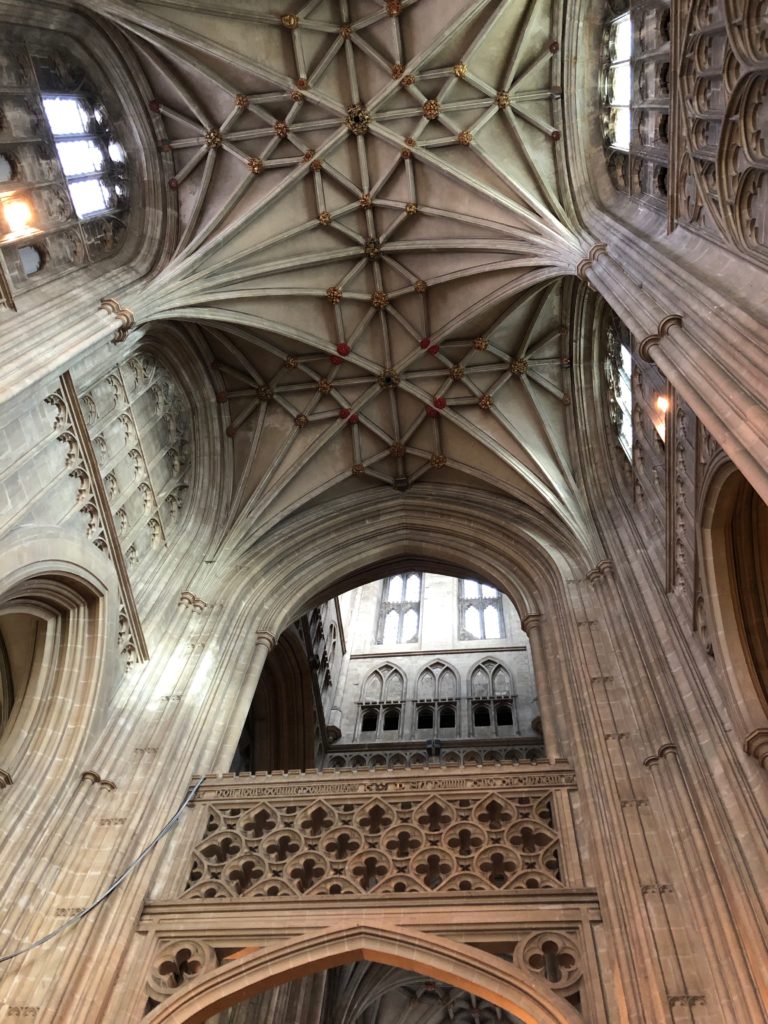 Canterbury Cathedral Ceiling Photo by JFPenn
Canterbury Cathedral Ceiling Photo by JFPenn
My discussion with Jeremy continues into why walking is healing and why pilgrimage in particular can heal deeper wounds of the soul, how the gifts of pilgrimage come with hindsight, why we travel, and how to figure out what kind of travel book to write.
You can listen to the rest of the episode on Travel Writing World on your favorite podcast app. Jeremy also has interviews with travel writers like Pico Iyer, Colin Thubron, and many more on his show, or check out his website TravelWritingWorld.com
In this next section, I’m interviewed by Holly Worton on her Into The Woods Podcast, which is fantastic for solo adventures, pushing your comfort zone in the outdoors and in life, and generally has lots of interviews with people about all kinds of travel.
In this clip, we talk about what I learned from pilgrimage including the aspect of memento mori, and then the three types of energy involved in a pilgrimage.
***
Holly Worton:
What did you learn from your pilgrimages? What did you get out of them?
Because I know you’d said that you walked them during very challenging times, which of course the entire world was going through
Jo Frances Penn: Yes, well, I think the biggest thing was resilience. And again, I mean, you talk about this with the solo adventures and or anything that pushes your comfort zone.
So, for example, I’ve done a lot of walking holidays with tour companies like Exodus, and I’m reasonably fit. So the walking aspect is one thing, but doing it alone is difficult. And in fact, you recommended the NNAS navigation course.
Holly: Yes, of course.
Jo: I went on one of those. Because I was like, ‘I don’t know how to read a map.’ Well, I did in Girl Guides, but you know, it’s been a long time. So I re-skilled.
And then it was facing up to the fears around being alone or getting lost, which I did — and getting sick. I didn’t get sick on the walks but of course, the fear of sickness while walking during the beginning of the pandemic, particularly when none of us had got it yet. We were very afraid, even though now we know there was hardly any round at that time, but it kind of emerged.
Walking in pain was a challenge. So on the Camino, I had pretty bad blisters the second week and you have to get up every morning and you’re like, ‘I really don’t want to walk on these feet,’ but I’m going to do it anyway.
So yes, I think this gift of structure, the boundaries, the resilience of learning new things. Just the escape from daily life is also really important and that perspective that we talked about. And then the other thing that I always think about a lot is the memento mori idea of, “remember, you will die,” but in a positive way, as in life is short, so make the most of it.
I think it’s much more obvious on pilgrimage routes because for example, if you go to Southwark Cathedral in London, at the start of the Pilgrim’s Way, that has been a church for a thousand years, and then you get to Canterbury and again, it’s been there since medieval times. You walk through these places and you realize how many other people have been here or the people who built those sculptures.
And what’s interesting at Southwark and Canterbury, and you rarely see such things, but there are these two cadaver tombs. That’s what they’re called. The tombs have a cadaver on. Normally if you see a medieval tomb or any kind of tomb, there’s maybe a knight lying on the top in full armor or a noble person with all their robes, and they look like a living human lying down on a bed or something.
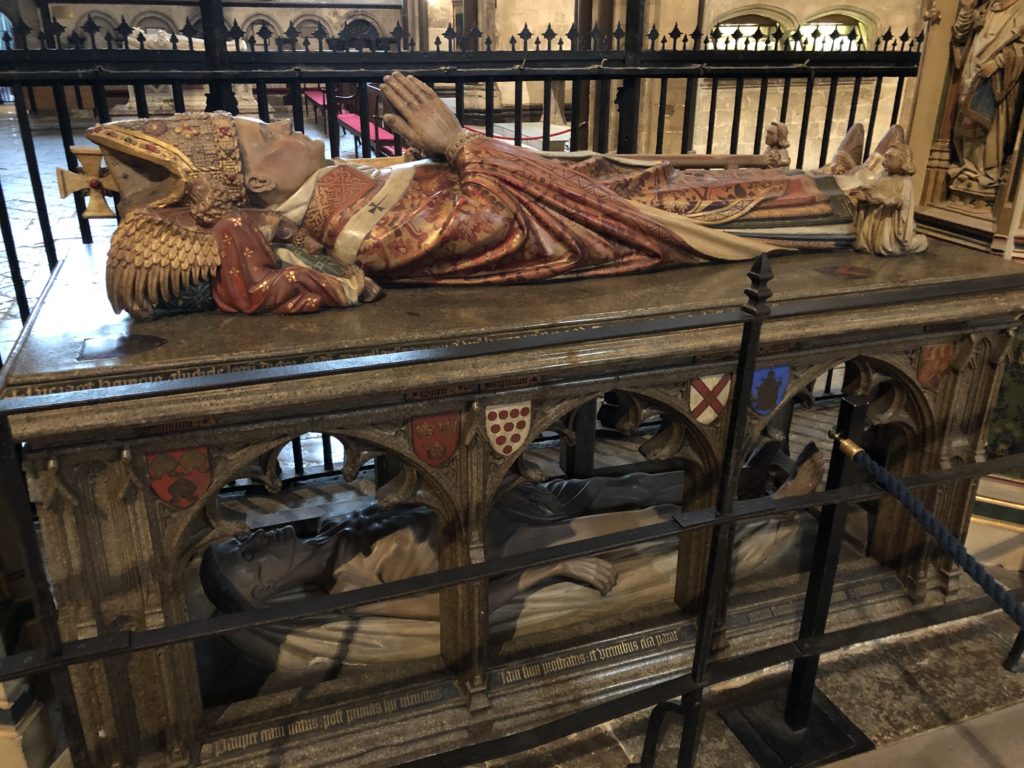 Cadaver monument of Henry Chichele, Archbishop of Canterbury (died 1443), Canterbury Cathedral. Photo by JFPenn
Cadaver monument of Henry Chichele, Archbishop of Canterbury (died 1443), Canterbury Cathedral. Photo by JFPenn
But both Southwark and Canterbury have these cadaver tombs where the figure on the top is a dead body. And this is very rare. In Canterbury it’s even more unusual because it’s like bunk beds. The Archbishop built this while he was alive, so he could look at it every time he preached.
On the bottom level is him as a cadaver naked except for a little shroud. Then on the bunk bed above is him dressed in his full archbishop’s finery. Obviously, it’s meant to teach you that it doesn’t matter what you are in life. One day you will just be this dead body and you will turn to dust.
And I find this invigorating and it helps me live every day better because I know I’m going to die. And it was weird on the Camino because it was the second or third day of my Camino when Queen Elizabeth II died.
And so I walked the route, and that whole week the TVs were full of her life. So often we look at ourselves in the mirror and we might see a picture of us as younger people and be like, oh, you know, I’m getting old, or whatever. But there are pictures of the Queen her entire life, and they were all on TV, so you could actually see this woman’s life from child to middle age to death.
And it was that memento mori idea again that we remember as we walk and to make the most of these things while we’re alive. Because one day I will not be able to walk the Camino or another pilgrimage. So do the things you want to do while you still can — but in a positive way!
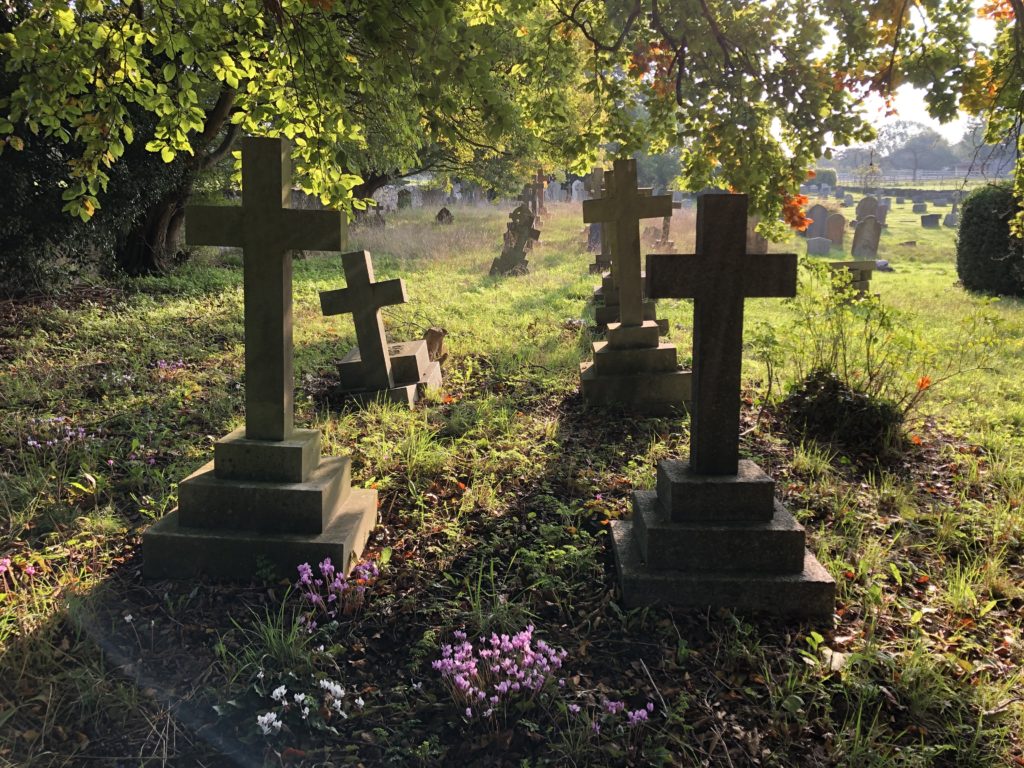 Graves in Boxley churchyard, Kent, England Photo by JFPenn
Graves in Boxley churchyard, Kent, England Photo by JFPenn
Holly Worton:
So in your book, you talk about the three stages of a pilgrimage, and I really like this perspective. So what are they?
Jo Frances Penn: The first one is starting energy, which is turning it from a dream into a goal.
So it took me like 20 years to actually book the Camino, 25 years or whatever. So it’s the organization, it’s booking time off, it’s training, it’s getting past those fears and obstacles. It’s figuring out all the practical stuff because you think, oh yes, I’ll just be walking and I’ll have my spiritual moments, but there’s a hell of a lot of practical stuff to actually get it going.
So starting energy is everything up to the night before and then pushing through energy is once you are actually on the route. It’s ‘I really want to give up because I’m in pain’ or I’m actually injured, or I’m really, really bored with wearing the same clothes and washing them every day and the same food, the same bread, you know, whatever.
Holly: It’s the other challenges along the way, like the Camino you mentioned being busy —
Jo: Yes, those last few days are busy and I was annoyed at other pilgrims, I was like, I am so annoyed that this pilgrim is playing music. Or I’m annoyed that there are literally a hundred pilgrims ahead of me. I can see them all on the path, and I do not like this.
And that was a challenge in itself because whereas the Cuthbert’s, for example, I was alone on a hill in a storm. And that’s a completely different challenge. But that pushing through energy is, “I am going to finish. I can do this, I will get through this. I just need to put one foot in front of the other and keep going.”
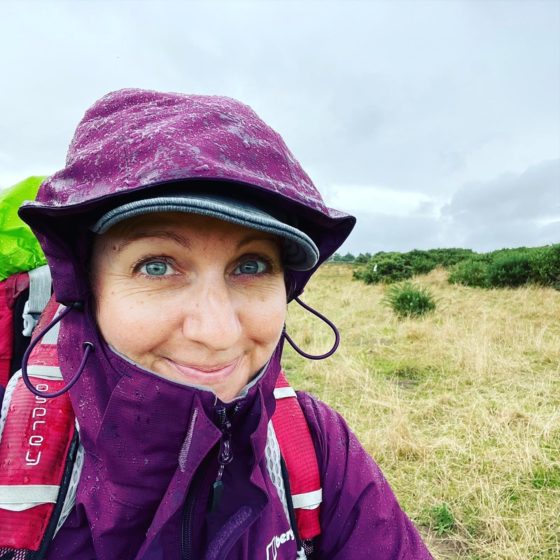 JFPenn in rain on the final full day of the St Cuthbert’s Way
JFPenn in rain on the final full day of the St Cuthbert’s Way
So that’s the pushing through energy that gets you to the end. And then the finishing energy is that return, and the reflection and learning the lessons. Maybe it’s printing the pictures that you did or taking your journal and turning it into something else, facing the questions that you thought of while you were on the walk.
Because when you get home, what happens is you put your clothes in the wash. That’s like one of the first things that you do. You get all the crap out of your backpack and you give your partner a cuddle and you cuddle your pets and then you log onto your email and you start all the backlog of stuff you need to catch up on and paying bills, and it’s very easy to just get back and get on with life.
But you need that finishing energy to review what happened because the gifts of pilgrimage take some time.
It’s so weird because I thought I would write three guidebooks like you have your guidebooks, your reflective books, and yet this book, it just wouldn’t come. I couldn’t figure it out.
And then when I finished my Camino, I finally understood what the pattern was and what I learned from all three routes. So the subtitle is Lessons Learned from Solo Walking Three Ancient Ways. And I almost feel like I couldn’t have learned those lessons without all three of them.
And I say in the book, if you don’t feel that there are any gifts from your pilgrimage, then perhaps you haven’t walked enough. Maybe you need to go on another pilgrimage. I thought I could change my life with a weekend walk but no, it took longer than I expected.
***
You can listen to the rest of the episode on the Into The Woods Podcast on your favorite podcast app — and Holly and I talk about why pilgrimage is different to other long-distance walks, some of the interesting historical and spiritual aspects, how we both remember reading Paulo Coelho’s Pilgrimage book back in the 90s, how we both enjoy the feeling of insignificance, why we have to revisit the memories of our trips or they fade away, and much more.
Holly’s show is one I personally listen to and I think you’ll enjoy the range of her interviews. She also has guidebooks to solo walking routes like The Ridgeway and more, and she has been on this podcast before in episode 42 about solo walking — In fact, my discussions with Holly about her adventures and her books helped inspire my own, so definitely check out her show.
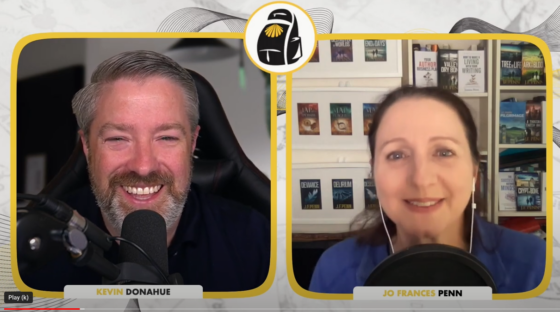 J.F. Penn with Kevin Donahue on Sacred Steps Podcast talking about pilgrimage
J.F. Penn with Kevin Donahue on Sacred Steps Podcast talking about pilgrimage
In this final clip, I talk to Kevin Donahue on the Sacred Steps Podcast which is all about pilgrimage, and Kevin has had some fantastic guests on to talk about lots of different routes, and he’s also been on this show in episode 86 talking about his pilgrimages. We almost met in person as we crossed the sands to Lindisfarne just days apart, but we never quite made it, so it was lovely to talk again. You can listen as a podcast or watch the interview on YouTube.
In this segment, we talk about how pilgrimage reminds us we are animals, and how it gives a much-needed perspective on life.
***
Kevin:
How has this series of walks and these journeys influenced or impacted your sense of spirituality?
Jo Frances Penn: There’s a book in the Bible that I really like, Ecclesiastes. It’s one of my favorite books in the Bible. And I have a Master’s in Theology even though I’m not a Christian anymore. But there’s a quote that I actually put into the book, “As for humans, God tests them so they might know they are animals.”
And I just love that quote because that to me is something I need to remember. My animal body is what walks a pilgrimage. And my spiritual mind and my intellectual mind are part of my physical body.
And I feel like so much sometimes, like you and I, we are not physically in the same space. We can see each other, but we’re connecting with our minds across this virtual space. And yet, pilgrimage is such a physical journey.
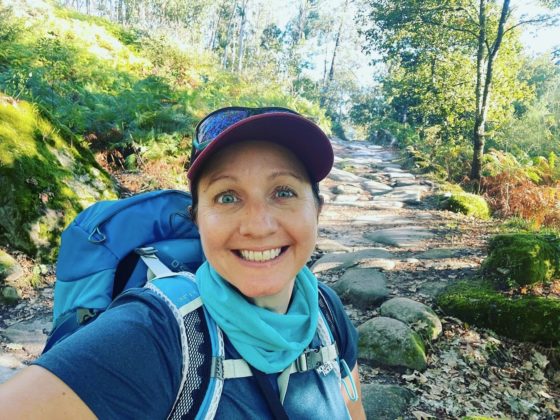 JFPenn on the Camino out of Arcade
JFPenn on the Camino out of Arcade
And also I was going through the female experience of midlife, hormonal changes, which have a very animal effect. You are just completely out of control. You are like, what the hell is happening to me? And I have no control over this.
And then like we mentioned, the tides and all these transient things and the idea of memento mori. So when I walked the Camino Portuguese, Queen Elizabeth II died in the UK and as I walked every day that week, her pictures were on all the TVs that you walked past in the cafes and stuff.
So they showed her whole life, the beautiful young woman who ascended the throne across the challenges of midlife to her old age, her husband dying, and her dying. And it was like, I’m not a queen, but I’m another woman. And I see this woman’s life and it will all end, and to me that is so important to remember for my spiritual side.
It’s a sense of being part of this wonderful world and this amazing universe, whether you believe God created it or not. The sense of being an animal walking across the face of the world and nothing else matters. Like that’s the thing. Nothing else matters.
Now, of course, everything matters. Your family matters. My husband matters. My cats matter, my work matters.
But when you are walking a pilgrimage and you have that simple life — and the gratitude. I am so grateful for this cold beer or this shade of this tree or the hot shower when I’m really sweaty and it’s gross and I just want a shower or the painkillers. I’m so grateful for the pharmaceutical industry, for my blister plasters and my painkillers, and my Albarino wine and like all those things.
It’s that perspective. That’s what it comes down to. Being able to hold onto that perspective when everything feels overwhelming and you’re just like, what is the point?
And then you realize this is the point. The point is being an animal in the world.
***
I hope you found those clips interesting, and you can listen to the complete episodes on the podcast feeds for Travel Writing World with Jeremy Bassetti, Into the Woods with Holly Worton, and Sacred Steps with Kevin Donahue.
Pilgrimage is available now in a special limited edition signed hardback, as well as a paperback, ebook, audiobook narrated by me, large print edition, and a workbook.
Happy travels until next time.
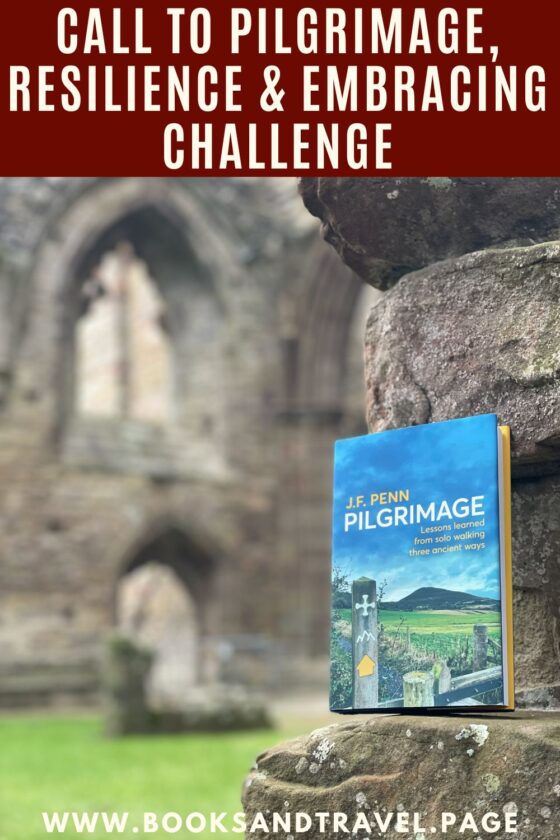 Pin on Pinterest
Pin on Pinterest
The post The Call To Pilgrimage, Resilience, And Embracing Challenge With J.F. Penn appeared first on Books And Travel.
27 January 2023, 12:10 am - 34 minutes 36 secondsPilgrimage: The Perspective Of History And Glimpses Of The Divine
How can walking in the path of history put life in perspective? How can you find a glimpse of the divine in unexpected places?
In this episode, I share two chapters from my book, Pilgrimage: Lessons Learned from Solo Walking Three Ancient Ways. You can buy the audiobook, as well as the special edition hardback, paperback and ebook, at www.JFPenn.com/pilgrimage
Walking in the path of history puts life in perspective
“Nothing ever is, everything is becoming… All things are passing and nothing abides.” —Heraclitus
On each of my three pilgrimages, I encountered places where I was aware of walking through history, where there was a sense of life being but a brief flash of light across the span of time. My passing on each route was momentary, but pilgrims have walked the same ways for hundreds of years and will continue to walk for generations to come.
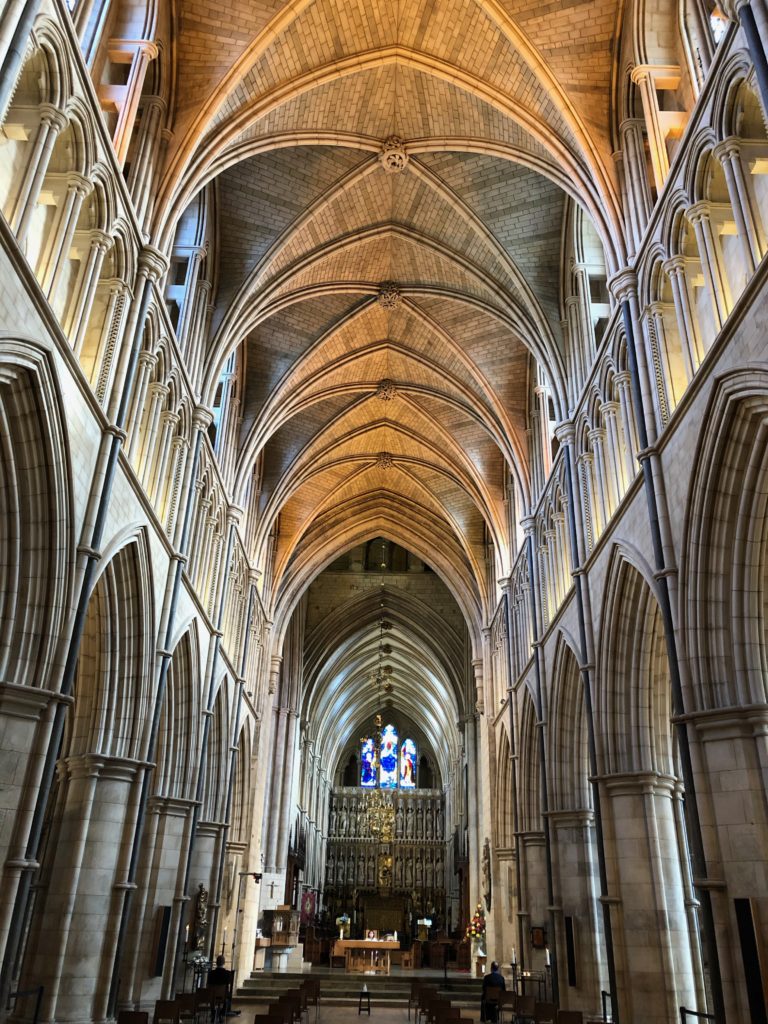 Southwark Cathedral Nave, London. Photo by JFPenn
Southwark Cathedral Nave, London. Photo by JFPenn
The three historic cathedrals are must-visit locations — Southwark Cathedral and Canterbury Cathedral on the Pilgrims’ Way, and the Cathedral of Santiago de Compostela at the end of the Camino. Each has their splendours, and it’s worth allowing extra time to visit them. In the same way, the ruined abbey of Lindisfarne and its associated church are insights into history — but these are all obvious highlights.
Here are some other places where I felt a historical perspective.
Mosaic mural on the Old Kent Road, London, England
The first day’s walk on the Pilgrims’ Way from Southwark Cathedral is through gritty, urban sprawl along a main road, dense with traffic. It might not look like much, but this is the Old Kent Road, originally built by the Romans, linking London to the coast near Dover, and later renamed Watling Street by the Anglo-Saxons.
At a busy corner with Peckham Park Road, under the overhanging porch of the Everlasting Arms Ministry, lies a gigantic thousand-square-foot mosaic mural. The History of Old Kent Road by Adam Kossowski has separate panels, each portraying an era of history. The foundation of the city by Romans in their togas surrounded by soldiers with military standards, then medieval London with Chaucer’s pilgrims heading for Canterbury and a quote from the poem. King Henry V rides in triumph along the road after the battle of Agincourt, followed by the rebellion of Jack Cade against the government. King Charles II reclaims the throne in the next panel, and then modern London emerges with its British ‘bobby’ policeman, Pearly Kings and Queens with their mother-of-pearl button suits, and the factories of the city with modern cars driving along.
The mural encapsulates two thousand years of history and yet most pass by without realising that the stones they drive over or walk along have witnessed such historical events.
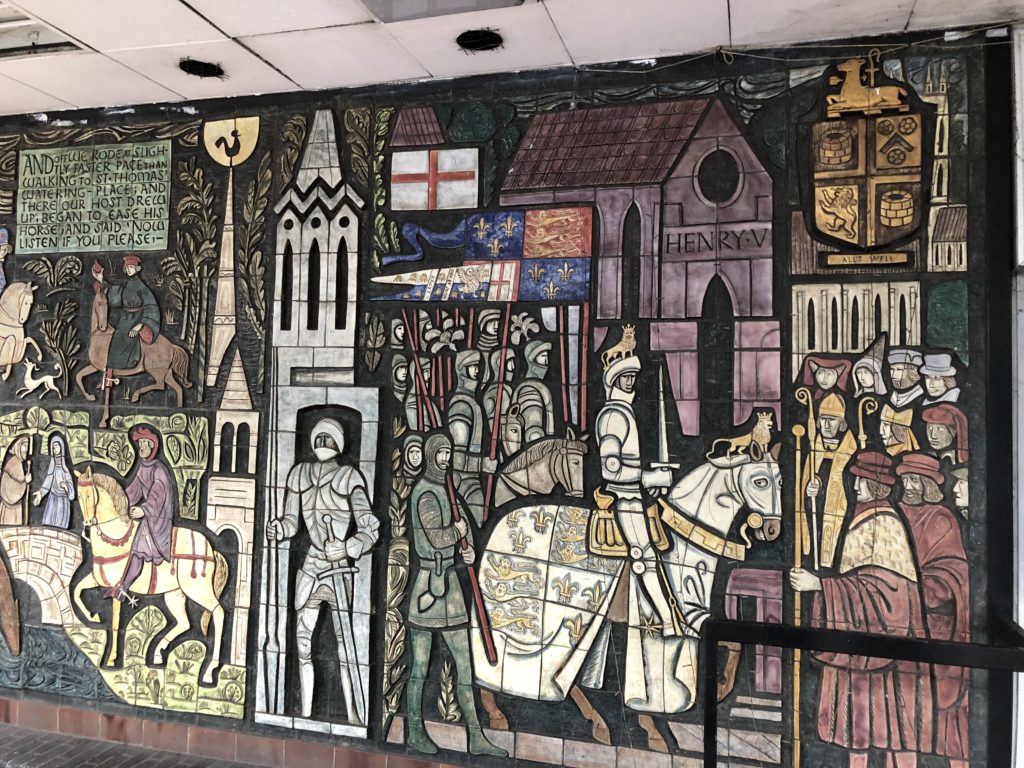 Historic mural on Pilgrims Way Photo by JFPenn
Historic mural on Pilgrims Way Photo by JFPenn
The artist himself represents another aspect of modern history. Adam Kossowski was Polish and arrived in the UK as a refugee from the Soviet labour camps in 1943. As well as this mural, he created many other artistic works, including the History of the Carmelites of Aylesford, at the abbey, which also lies on the Pilgrims’ Way and where he was buried after his death in 1986.
Lesnes Abbey, London, England
The ruins of twelfth-century Lesnes Abbey (pronounced ‘lane’) lie on the Pilgrims’ Way in an ancient woodland in east London. Founded in 1178 by the Chief Justiciar to Henry II, it may have been part of a penance to atone for the murder of Archbishop Thomas Becket.
After the Dissolution of the Monasteries in the sixteenth century, the abbey fell into ruin and was eventually lost to farmland before being restored in modern times. The ruins now feature much-appreciated public toilets and a cafe along the Green Chain Walk that forms part of the Pilgrims’ Way.
There is a memorial of three triple archways that overlook the ruins, and an ancient mulberry tree with the skyscrapers of the city of London framed on the horizon.
The mulberry tree represents patience, as it will not bud until there is no danger of frost. Its red berries also represent sacrifice, as depicted by Shakespeare’s forbidden lovers Pyramis and Thisbe, who died under a mulberry bush, their blood staining the berries red.
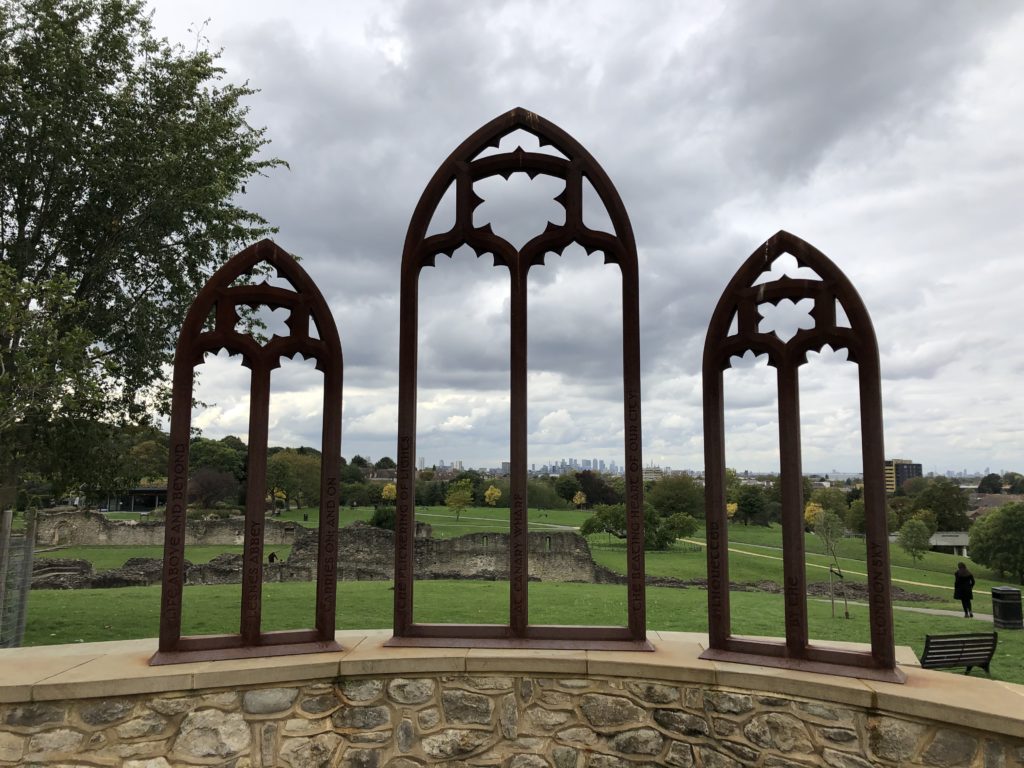 Lesnes Abbey Ruins, London. Photo by JFPenn
Lesnes Abbey Ruins, London. Photo by JFPenn
Lesnes Abbey is a place of ancient nature and medieval faith against a backdrop of modern London. Well worth a visit.
The cadaver tombs of Southwark and Canterbury Cathedrals, England
There are unusual cadaver tombs in both Southwark and Canterbury Cathedral, at the beginning and the end of the Pilgrims’ Way. These are rare depictions of the deceased as corpses as opposed to the grand effigies usually sitting above the tombs of nobility.
The Southwark cadaver is the medieval tomb of Thomas Cure, who died in 1588, the same year as the Spanish Armada, during the reign of Elizabeth I. Its skeletal frame is weathered by time, its face disintegrated. It’s clearly a dead body, partially wrapped in a shroud, a simple representation of the inevitability of death.
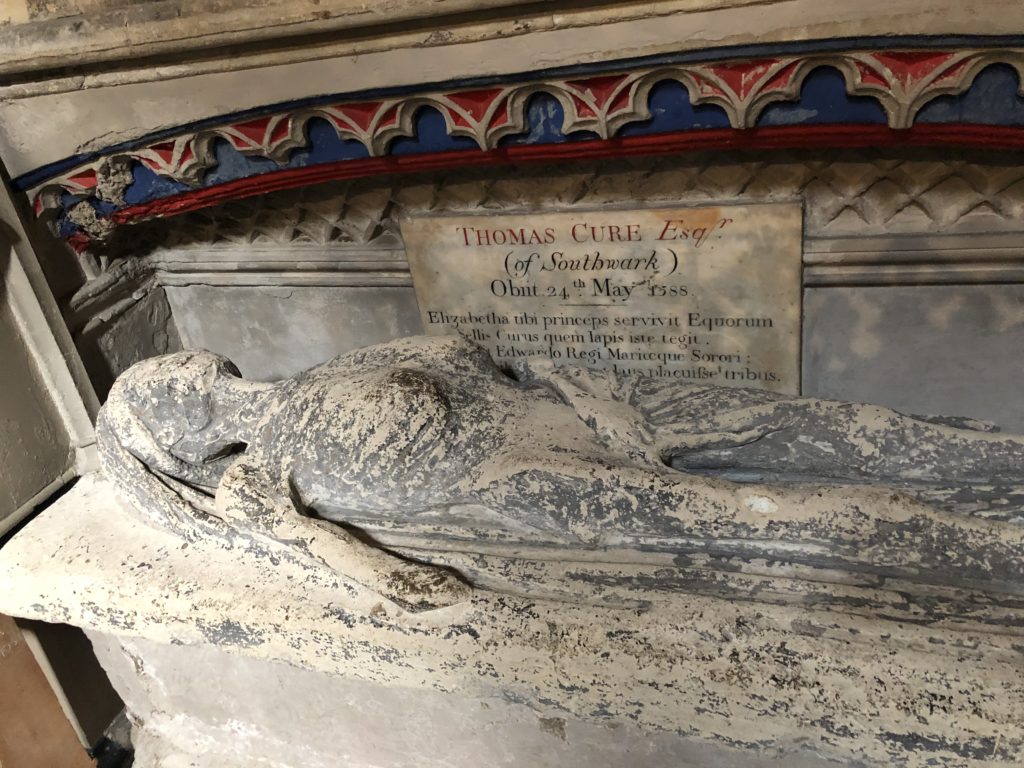 Medieval cadaver tomb, Southwark Cathedral, London. Photo by JFPenn
Medieval cadaver tomb, Southwark Cathedral, London. Photo by JFPenn
The Canterbury cadaver tomb is on an entirely different scale in terms of grandeur. The tomb of Archbishop Henry Chichele, who died in 1443, has two levels, one showing the effigy of the deceased man in full ecclesiastical robes and, underneath, the cadaver stripped of all its finery, lying naked except for a shroud. It’s surrounded by an ornately decorated arch with figures from church history. A tour guide told me that the archbishop had the tomb built many years before his death so he could look at it every day and contemplate his end.
 Cadaver monument of Henry Chichele, Archbishop of Canterbury (died 1443), Canterbury Cathedral. Photo by JFPenn
Cadaver monument of Henry Chichele, Archbishop of Canterbury (died 1443), Canterbury Cathedral. Photo by JFPenn
St Cuthbert’s Cave, Northumberland, England
This natural sandstone cave lies within a National Trust reserve on the final day’s walk towards Lindisfarne, Holy Island. The cave has a wide mouth and is ringed by a wood of Scots pine. According to legend, the monks fleeing from a medieval Viking invasion stopped in the cave with the remains of St Cuthbert.
It doesn’t really matter if his body lay there over a thousand years ago. The cave is clearly a natural shelter from the dark and cold and wild weather, and humans certainly rested and slept here over millennia. There is fire damage and graffiti, both old and new, evidence of people making their mark across time.
On my approach to the cave, an adder with its distinctive zig-zag markings crossed the path in front of me. A protected species, the adder is the UK’s only venomous snake, but they are secretive creatures and rarely seen. I had never seen one in the wild before, and it was a precious moment.
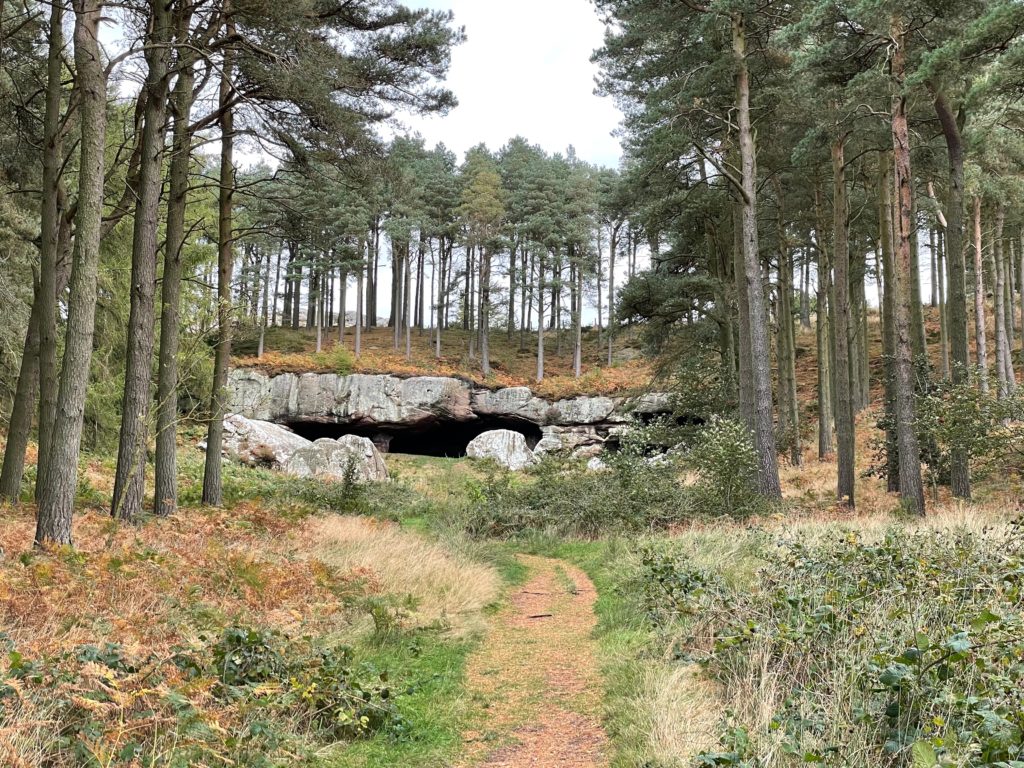 St Cuthbert’s Cave Photo by JFPenn
St Cuthbert’s Cave Photo by JFPenn
As I sat on a rock in the rain eating my lunch, there was a sense of being part of an ancient environment. If I slept in the cave in the dark of night, perhaps I might hear the crackle of ancient flames and the whisper of the long-dead.
Memento mori — Remember, you will die
While walking an ancient route like the Camino de Santiago helps the pilgrim to reflect on mortality, it is almost impossible to comprehend a thousand years of pilgrims walking ahead and many more coming behind.
But while I walked in September 2022, I had a vivid reminder of memento mori — remember, you will die — as Queen Elizabeth II died at the age of ninety-six on the second day of my pilgrimage. Snippets of her life punctuated each following day of my Camino on TV in coffee bars and glimpses of newspapers, and I couldn’t help but read some of the UK media coverage online when resting at the end of the day.
It was strange to walk outside of my country during such a historically significant week. I remember seeing newly carved statues of the Queen and Prince Philip mounted outside the cathedral in Canterbury on my first pilgrimage in October 2020. The stone was paler than the other sculptures of historic monarchs. The features weren’t yet weathered — and of course, both were still alive then. There was a sense of standing next to living history, as another generation passed, and now they are both gone.
I am not an ardent royalist by any means, but the Queen was a constant across my life, as she was for many people in the UK and around the world. As I walked my Camino, the news was full of pictures of her as a young woman, then middle-aged going through the trials of life, then an old woman at her husband’s funeral, and in her final days, standing bent over and smiling as she welcomed the new Prime Minister. The span of an extraordinary life against the backdrop of history.
Her life passed by, as will mine and yours. Even a Queen cannot hold back the end.
I walked into Santiago de Compostela on the day of her funeral and, as I rested in my hotel that afternoon, I watched her coffin being lowered into the vault at Windsor Castle. It was a fitting end to my pilgrimage and underscored the sense that something must die for change to happen — new life will emerge from the ashes of the old.
 Graves in Boxley churchyard, Kent, England Photo by JFPenn
Graves in Boxley churchyard, Kent, England Photo by JFPenn
Questions:
- What aspects of history form part of your pilgrimage route?
- Which are you interested in visiting?
- Sometimes it is the unexpected places that mean the most. How can you keep an open mind so serendipity may alight at other times?
- How can ‘memento mori’ help you put life into perspective?
A glimpse of the divine in sacred places
“All such sites are regarded as thin places, set apart from the world, moving to a different drum, and possessed of an innately special atmosphere because of their connection to another, higher dimension.” —Peter Stanford, Pilgrimage: Journeys of Meaning
The paths and final destinations of great pilgrimage routes have been imbued with so much meaning over centuries, they call both to those who believe and those who don’t follow a particular faith.
The depth of history and belief of the faithful over generations impart a deeper resonance to certain places where the veil is thin, and you are closer to God, or a sense of the divine. Your pilgrimage will have moments of spiritual meaning if you are open to them, although, of course, they may come at unexpected times.
Here are some moments where I glimpsed the divine while walking these ancient ways.
Crayford Ness, near Dartford, England
I was exhausted as I emerged from the Thames Path Walkway and passed through the gritty, urban sprawl of Erith in East London. I’d already walked around thirty-eight kilometres that day, and I still had several more to walk before I reached my hotel in Dartford. It was October, and dusk was fast approaching.
I took a wrong turn and found myself alongside a busy dual carriageway, the noise of so many cars jolting me back into the modern world. I considered getting a bus or even a taxi to carry me through the last few kilometres, but I had promised myself I would walk every step of my pilgrimage and this was only the first day.
As I trudged on through an industrial estate echoing with the rumble of cranes hauling heavy equipment, the screech of trucks, and the shouts of workers, I wondered what the hell I was doing there.
But then the path opened out onto a flood plain where horses grazed on common land, and the way ahead ran alongside the river once more. This was Erith Saltings, an ancient salt marsh, part of the Thames estuary that can’t be built upon as the tide may wash it away. The remains of an ancient fossilised forest dating back to Neolithic times over five thousand years ago lie partially submerged beneath the water, and on the opposite bank lies the Rainham Marshes Nature Reserve. Oyster catchers waded in the shallows, and a regal heron rested on a solitary spar emerging from the water.
But this is no pristine wilderness. The path runs alongside a recycling centre, with the stink of waste coming from huge sorting bins filled with all kinds of discarded human detritus.
I turned my back on the industrial centre and looked out over the salt marsh, as a flock of Canada geese flew overhead, calling to one another in the dusk. With the warbling trill of skylarks and the whistle of the wind off the river, I stood in a moment out of time. The ancient forest buried beneath the waters once echoed with birdsong, and, after human civilisation has passed away, the birds will sing on.
Whether it was the juxtaposition of such ugliness alongside natural beauty, or the timelessness of the fossilised forest with the ephemeral sound of birdsong — or just my exhaustion — I stepped into a thin place there.
After a time, a metallic crash jolted me back to the present. I turned to see an urban fox waiting by the side of the industrial centre, an inquisitive look on his face as I passed by.
My pack seemed lighter as I walked the rest of the way along the River Darent into Dartford, grateful that I had not skipped this part of the journey.
Evensong at Canterbury Cathedral, England
It was dark outside when I entered the cathedral, my final destination on the Pilgrims’ Way. With my mask in place, I walked to my solitary chair in the nave, directed by a similarly masked attendant who made sure all present followed pandemic rules. There were a few other people there, all separated by several metres, the space around us cold in the autumn evening.
The choir entered in a line, walking across the nave in robes of purple, all of them masked. They arranged themselves on the steps in front of the quire screen, physically distanced, before removing their face coverings.
They sang psalms in Latin, their voices soaring high into the vault above, harmonising together even as they stood so far apart. This cathedral was built for the glory of God and these men sang for Him too, but also surely for the sheer joy of human voices coming together in song at a time of so much separation.
Ancient stone, ancient words, ancient faith — and the transience of each note disappearing into silence once more.
I stayed for the service, but it was the practice before that truly moved me, and those minutes almost alone in the cathedral nave that freed my spirit. A fitting end to my Pilgrims’ Way.
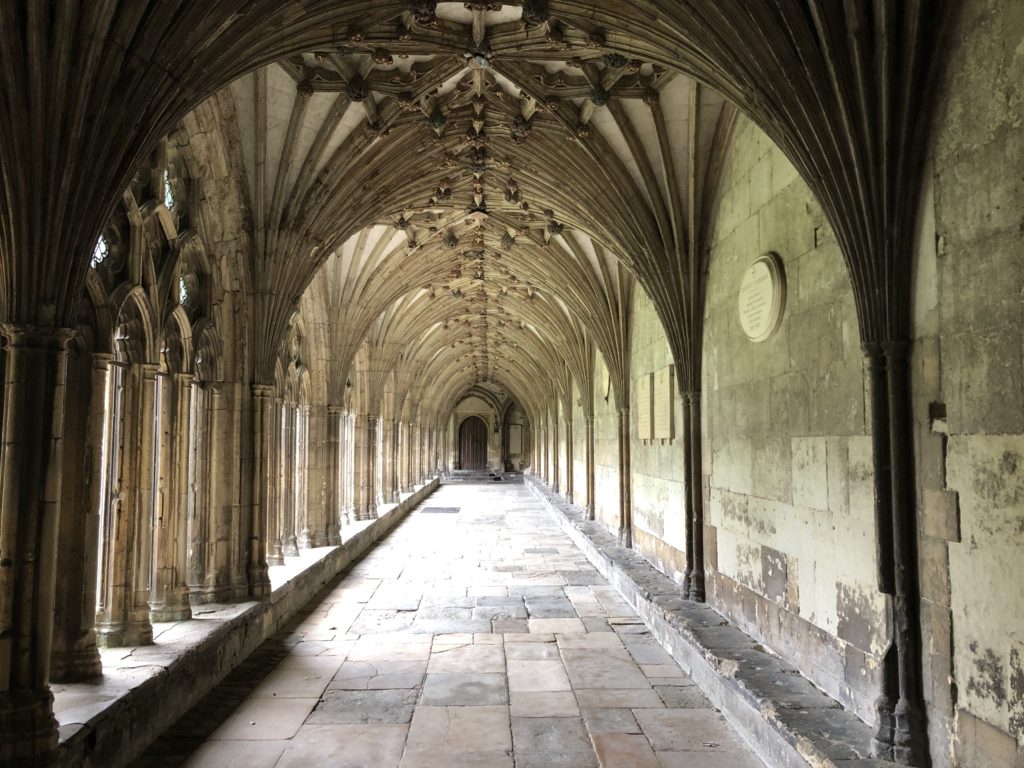 Cloisters, Canterbury Cathedral. Photo by JFPenn
Cloisters, Canterbury Cathedral. Photo by JFPenn
Walking across the sands to Lindisfarne, Holy Island
I rose before the dawn on the final morning of my pilgrimage on the St Cuthbert’s Way. I stood at a farm gate looking east into the rising sun, next to a field of curious alpacas and chickens quietly clucking in their roost. As the darkness lifted, the castle on Lindisfarne stood in silhouette against bars of coral clouds, shot through with luminous yellow and pink as the sun rose above the horizon.
The end was so close now.
I was relieved because my muscles ached and I wanted to stop and rest and not walk another day, but I was also sad that the journey was almost over. I wanted to finish the path, but also to keep going. Yet there is nothing beyond Lindisfarne, only the North Sea, and I would reach the furthest point that day.
The clearing sky indicated that the weather would be fine for my crossing of the sands, but I still felt some trepidation. The tidal website warned it was only safe to cross with a guide, and there were tales of walkers lost to the sea in the fog, or cars stranded on the causeway as water reclaimed the land.
But I had prepared, and I knew it was safe to cross. All that remained was to step off onto the sands that the sea left behind.
As the sky turned pale blue, I returned to the farm to retrieve my pack, hefting it onto my shoulders for the last time.
It was only a few kilometres from the farm to the edge of the causeway. I walked with Dave and Keith, pilgrims I had met a few days back after getting lost on the boggy moor. On the way down, Keith and I discovered we had both studied theology and read many of the same books. Whereas I had turned my degree into the basis of my thrillers, he had spent a life of service as a social worker, supporting those with mental health issues. We disagreed on matters of faith, but there was a spark of intellectual connection. Pilgrimage encourages the discussion of such deeper matters and I fleetingly wished we could carry on our debate. But we were soon at the edge of South Low, where the tide had turned and the waters were receding.
Several enormous concrete blocks lay just before the causeway, anti-tank sea defences from World War II. There were signs warning of unexploded ordnance in the area as well as quicksand, and more warnings of what could happen if the tide cut you off. It was hard to imagine the military swarming over this area, now a National Nature Reserve, protected for the biodiversity of life within its shifting sands and tidal waters.
A series of marker poles stretched across the sand to Lindisfarne, interspersed by two wooden refuges on stilts for those who could not beat the tide. The sky was pale blue and clouds scudded high above, and I could see all the way to Holy Island. It was safe to cross.
 JFPenn on the sand crossing to Lindisfarne
JFPenn on the sand crossing to Lindisfarne
I rolled my walking trousers up above my knees. Walking barefoot was the traditional way to cross, but I had blisters and raw patches on my feet, so I wore my walking shoes with waterproof socks. I grasped my poles to steady myself — then stepped off the causeway onto the sand.
I wanted to walk the final stretch alone, so after taking photos with Keith and Dave, I let them stride ahead.
The sand was initially firm underfoot as I followed the path of tall wooden poles towards Holy Island. I skirted around deeper pools of water, stepping over the wiggly casts of lugworms and the footprints of wader birds. Gulls flew overhead, their calls piercing the air.
There were patches of grass in places and channels of deeper water to navigate, with sections of sucking mud which I clambered through, using my walking poles to gain a more even footing. I almost lost one shoe in the mud, and it was certainly a more challenging walk than I expected. Less a stroll across firm sand, and more an adventure to reach the final destination.
The lower parts of the wooden guide poles were covered with barnacles and bladder wrack seaweed, surrounded by winkle shells and long strands of sea grass. Crabs scuttled in the shallow water, trying to sink away from the light. The upper parts of the poles that lay above the tide were stark white, reflecting the morning sun, and I could imagine pilgrims spotting them with relief on a foggy crossing.
I stopped halfway across and turned my back on the causeway, looking south across the water to Bamburgh Castle in the distance. A mournful sound pierced the air, a low moan like a chill wind sweeping through ruins. The call of grey seals out on the sand flats, singing as they have for generations of pilgrims. I was just one more in a long line stretching back through history, and my footsteps would wash away with the tide like all who walked here before me.
The crossing took about ninety minutes, with time enough to navigate slowly around the mud and deeper water channels. I finally clambered up the bank on the other side and sat on a bench, looking back at the mainland as I changed into dry shoes.
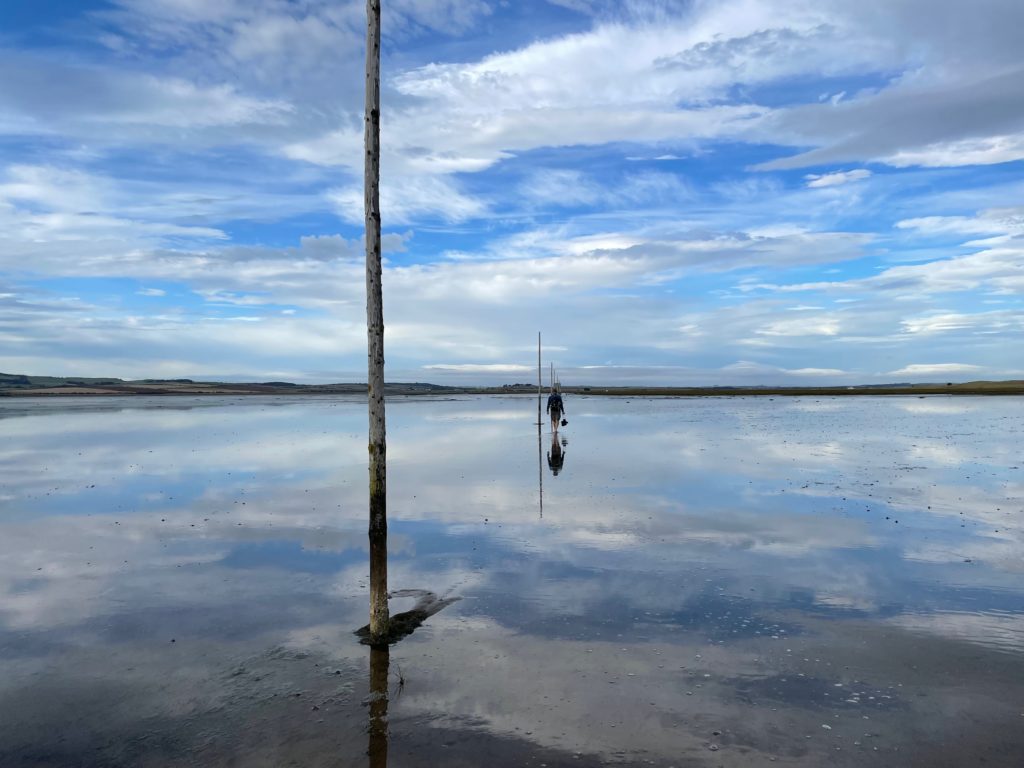 Walker on the sands crossing away from Lindisfarne Photo by JFPenn
Walker on the sands crossing away from Lindisfarne Photo by JFPenn
As with my arrival at Canterbury Cathedral a year ago, there was no fanfare, no one cheering the finish line of my pilgrimage. Only a quiet sense of satisfaction that I had accomplished what I set out to do.
After one last look back at the crossing, I walked into Lindisfarne village. After days of solitude, it was a shock to find hundreds of day-trippers pouring out of coaches and cars, streaming over the causeway while it was open during the narrow tidal window. Throngs of tourists rammed into ice cream shops, artists’ studios, and cafes, spilling out into the narrow streets.
While I ate a local crab sandwich in front of the Lindisfarne Mead shop, I wondered what St Cuthbert would have made of the modern Holy Island. There was a frenetic energy about the place as day-trippers rushed to see everything before hurrying back to escape the incoming tide. Some people glanced sideways at me, in a very judgmental English way, as if they didn’t appreciate my muddy pack and dishevelled appearance. It was strange to re-enter the real world again.
I hoisted my pack back on and walked to the ruined abbey while it was still open and then visited the parish church of St Mary the Virgin. A full-sized statue of monks carrying the coffin of St Cuthbert stood inside, and I felt more of a connection with those medieval walkers than the modern religious tourists filling the aisles.
As the island emptied, I walked east to Lindisfarne Castle along the shore. Tourists ran in the opposite direction to catch their buses and I was grateful I’d booked a night on the island when it became quiet once more.
I walked until I reached the coast, where cairns of balanced stones stood overlooking the rough waters of the North Sea. The lands beyond were those of Norway and Denmark, and this was the way the Vikings arrived in the eighth century, bringing violence to the abbey and causing the monks to scatter.
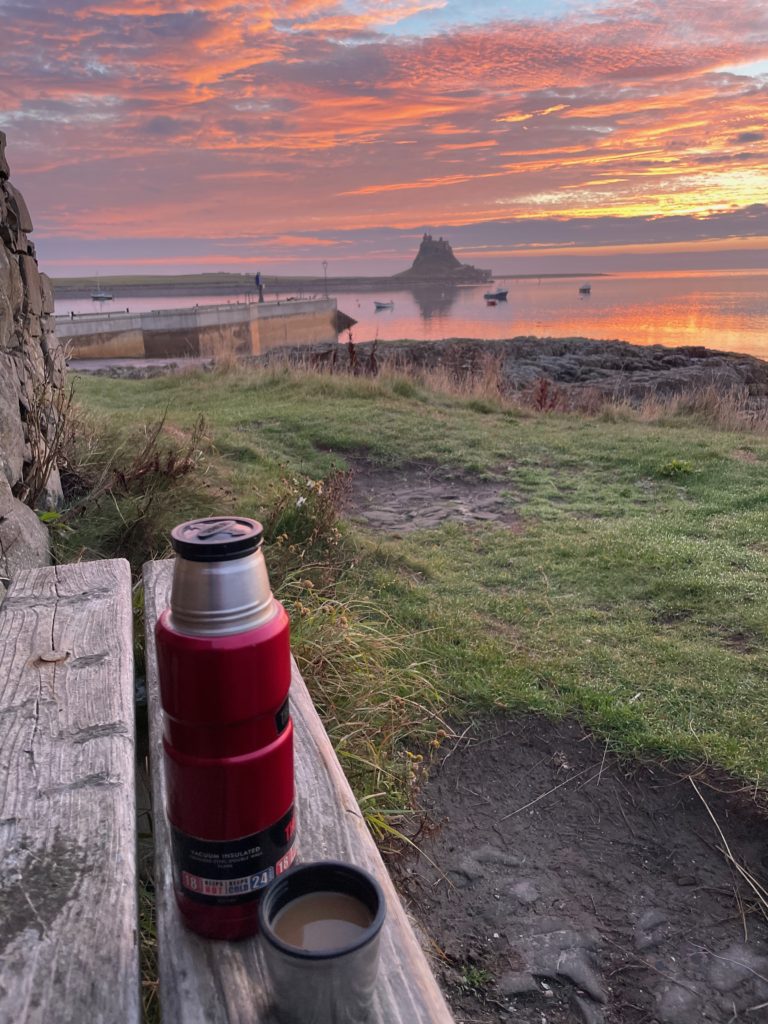 Coffee at dawn on Lindisfarne Island Photo by JFPenn
Coffee at dawn on Lindisfarne Island Photo by JFPenn
I wrote about Lindisfarne in my novella Day of the Vikings, a modern-day thriller set against the history of invasion and a supernatural power called down from the ancients. Now finally there in person, I sensed a different power. One that emanated from the island and the tide. There was a part of me that wanted to stay there, to sink into island life, and allow the tide to cut off my access to the wider world.
As I walked back from the castle, a murmuration of starlings swooped above the wetlands. As they soared in unison, forming and reforming different shapes in the twilight, I remembered seeing the same thing at Stonehenge a decade ago. Another place where the veil is thin, a glimpse into a timeless realm where I am just another pilgrim in another sunset.
Questions:
- Where have you experienced this sense of the divine or felt that the veil is thin?
- How can you remain open to the spiritual aspects of pilgrimage without expectation of such moments?
Pilgrimage is available now: www.JFPenn.com/pilgrimage
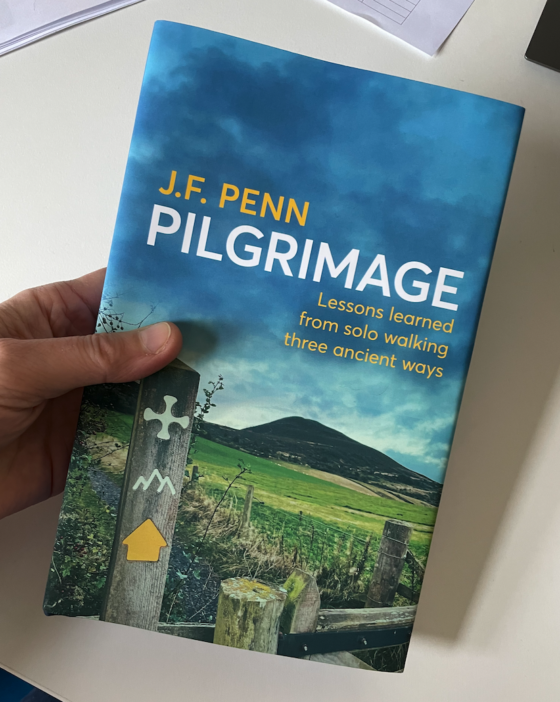 Pilgrimage: Lessons Learned from Solo Walking Three Ancient Ways by J.F. Penn
Pilgrimage: Lessons Learned from Solo Walking Three Ancient Ways by J.F. Penn
The post Pilgrimage: The Perspective Of History And Glimpses Of The Divine appeared first on Books And Travel.
8 January 2023, 12:10 am - 36 minutes 35 secondsThe Meaning of Travel With Emily Thomas
In this wide-ranging interview, Emily Thomas talks about the importance of perspective and time in travel writing, how sublime moments of pleasurable terror make travel so interesting, how to overcome fears both real and imaginary, as well as the ethics of doom tourism, and how VR (virtual reality) might change how we travel in future.
Dr. Emily Thomas is an associate professor in philosophy at Durham University in England. She’s also the author of several books, including The Meaning of Travel: Philosophers Abroad.
- Traveling is about experiencing otherness, going to places that are new and unfamiliar and trying to figure out how to make sense of them
- Sublime moments in travel as a kind of pleasurable terror
- Tackling fears, both real and imagined
- Research before a trip, and arriving in Malawi, Africa
- How do travel books blur the line between fiction and nonfiction, and why is this so important to address stereotypes
- “There is no view from nowhere.” Perspective in travel writing
- Maps as processes, and how they change over time. The importance of knowing ‘when’ a book was written and the perspective of the writer.
- Doom tourism
- How VR (virtual reality) might improve aspects of travel, and what we want to keep as in-person experiences
- Recommended travel books
You can find Emily at www.EmilyThomasWrites.co.uk and on Twitter @emilytwrites
Shareable and header image generated by Jo Frances Penn on Midjourney.
Transcript of interview (lightly edited)
Jo Frances Penn
Dr. Emily Thomas is an associate professor in philosophy at Durham University in England. She’s also the author of several books, including The Meaning of Travel: Philosophers Abroad, which we’re talking about today. So welcome, Emily.Emily Thomas
Hello. It’s a pleasure to be here.Jo Frances Penn
I’m excited to talk about this topic.What drew you to write a book about travel and philosophy, since one seems quite internal, and the other one quite external?
Emily Thomas
That’s right. So I have been a professional philosopher for more than 10 years, but far longer than that I have been a backpacker. So I did buckets of traveling when I was younger. And at some point, when I was writing about philosophy, I began wondering, does philosophy have anything to say about travel? Is there some way that I can bring these two parts of my life together, and I started doing some research. And to my delight, I found that philosophy has lots to say about travel. And that was how the book was born.Jo Frances Penn
What does travel mean to you?Emily Thomas
For me, traveling is all about experiencing otherness. It’s all about going to places that are new and unfamiliar. And trying to figure out how to make sense of them, how to map them on to the world that you do know.My best travel experiences have actually been ones where I have gone to some place where I haven’t understood anything around me. Not not the language, not what’s going on in the street, not the social cues and I have very slowly, by reading and talking to people, come to put the pieces together and come to understand the place.
Jo Frances Penn
That’s interesting. So you have otherness and the new and the unfamiliar. Does that mean that for you, traveling say within England, doesn’t count as travel?Emily Thomas
There are definitely places within England that I don’t know at all and might give me that travel unfamiliarity experience. But you’re right, I think that to be really immersed in the unknown for me, I’m going to have to go farther afield than that.Jo Frances Penn
Absolutely. So you have this chapter on sublime tourism, which is so often the special moments we remember, rather than all the difficulties around it.Tell us a bit more about some of your own sublime moments in travel.
Emily Thomas
So I should explain that I use the word sublime in a technical way, to mean a very specific kind of feeling that was picked out by 18th-century Irish philosopher Edmund Burke.When you have a sublime feeling, it’s a kind of pleasurable terror. So it’s the kind of enjoyable fear that you get from standing close to a waterfall, but not too close. You can feel the spray on your face, but you’re not actually afraid of falling over.
And I had definitely had a lot of those kinds of moments whilst traveling that often because I’ve done almost all my traveling by myself, just rocking up in a new place that I find really terrifying. And also really exciting on the other. I think the first time I really powerfully experienced that. I was 18. And I spent a couple of months wandering around China, the very first time I arrived in a big new city, and I stepped out of the hotel room, just not understanding anything that was going on around me it was really scary, but also exhilarating.
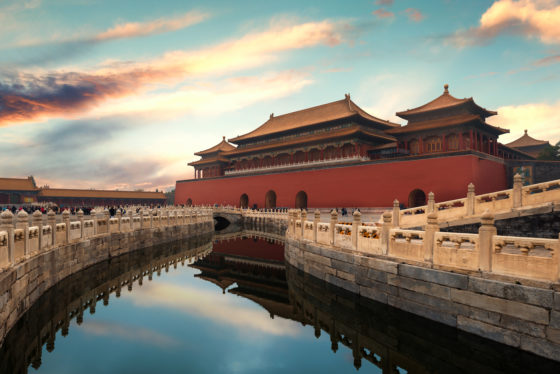 Forbidden City, Beijing. Photo licensed from BigStockPhoto
Forbidden City, Beijing. Photo licensed from BigStockPhoto
Jo Frances Penn
That’s really interesting that you call it that ‘pleasurable terror.’ And in the book, you also quote Camus, “what gives the value to travel is fear.” And it’s interesting.You talk there about terror, you’re using the word fear in the book.
What are some of the fears that you’ve had to face? When have they been real? When have they been imagined?
Emily Thomas
Some of the fears, I think, are very reasonable to have and they are not pleasurable. So for example, walking through a city by yourself where you’re conscious that it’s not very safe, that the crime rates are very high, and you’re afraid of being attacked or mugged. That’s not fun. They are not imagined fears either.But I think there are other fears are more exciting. And in a pleasurable way. I might have a fear that if I walk into a city I don’t know very well. I’m going to get lost. Well, actually, really, what’s the worst that’s going to happen? You know, I get lost it and I ended up asking for directions in a coffee shop or something. The feeling of oh, maybe I could be lost. That’s quite nice.
Have I personally been in some scrapes? I have. What especially springs to mind when people ask me that question. I was once in a taxi in Zimbabwe that caught fire, and the driver refused to pull over. It was just there was smoke, I mean, we could see flames on the bonnet. And he was like, no, it’ll be fine, like we don’t have to stop the car.
Jo Frances Penn
Oh, wow. Okay. So you’ve talked about solo travel, and fear of being attacked, specifically as a solo woman. I mean, that can happen if one is just in London late at night or in Newcastle late at night or something. I mean, that doesn’t have to be a foreign fear.But if it’s in a foreign country, it feels like things will just be more difficult, even like asking someone where the bathroom is, like when I traveled in India, that can be a moment of fear.
How can we overcome some of these fears in order to travel to new places?
Emily Thomas
I’ve recently been reading about stoicism, which is a particular kind of philosophy dating back to Roman times. And one of the suggestions they have is that when you’re afraid of something, you should actually sit down in your mind and work through what could possibly happen. Like what is the worst case scenario? And how would you deal with that, if that comes up.And I personally get scared by the unknown. So the idea of landing in a new place that I find quite scary, I find it scary, because I have no idea what to expect when I’m there. But if I actually really go back and start thinking, Okay, this is where I want to go. And okay, and this is how taxis or whatever it might work here. The more knowledge that I have about the place that I find that the fear goes away. It’s like horror movies, right? You know, the unseen monster or ghost is always much scarier than when you actually see the ridiculous special effects that the producer has drummed up for your movie entertainment delight,
Jo Frances Penn
Which is why you don’t often see the monster — then the actual fear is like, Oh, right. It’s just another vampire.Emily Thomas
Yeah, exactly. Right.Jo Frances Penn
That’s really interesting that you say that in terms of a guidebook, for example. So let’s put that under the category of research. You can research a place and for me, it’s like I often I will research lots of places, but then I just concentrate on getting off the plane to the first night’s accommodation.And even if I’m doing more free-range travel, I will have a first night’s accommodation booked. And also as a solo woman traveler, I will make sure the plane arrives at a time of day that is appropriate.
I had a terrible experience arriving at 2 am in Tel Aviv, Israel, back in the early 90s. And the war with Iraq was going on. And it was honestly one of the scariest times. I was in a new city. I don’t know what the hell I’m doing. I was before the internet, etc.
So you’ve just arrived in Malawi in Africa, which I have talked about on the show in episode 1 because I went to school there.
 Jo Frances Penn in Malawi in the early 1980s
Jo Frances Penn in Malawi in the early 1980s
How has this research and discovery process worked with Malawi?
Emily Thomas
One thing that makes this trip a bit different for me is that I’m actually living here for a few months. So rather than traveling around moving on every night or two, that I’m actually settling in. It was quite similar in some ways, I had the first couple of nights’ accommodation booked, but then I had to go out and look at apartments to set myself up.And now it’s a case of really trying to understand how basic things work. So things I was not expecting include there are many power cuts every day. And so it is not a good idea, for example, if you are working as I am to let your laptop go very low on battery, because otherwise when the next power cut comes you might run out of battery quite quickly. So really, really basic things about how to live here is what I’m now trying to get to grips with.
Jo Frances Penn
I think money is something really interesting because before the pandemic, one would turn up in various countries and you might have been able to get some local currency or you just take US dollars or another currency that people accept. But what I’ve discovered is post-pandemic, even really out-of-the-way places take mobile payments or digital payments. And of course, Africa has a lot of mobile payments. So how’s the money working? I know it’s very practical, but money is a big deal, right?Emily Thomas
It is a really big deal. And you’re absolutely right. I’m making payments via mobile phone payments, which is not something I have ever done before in the UK.I’ve had to download the correct apps and figure out how it works. And part of the issue is that people want to avoid the government taking a slice out of certain payment apps. So they always want you to use their particular payment app, but the government takes less money. It has been a learning curve. And I definitely find post-COVID people want to handle objects less, including notes and coins. That is a big deal. And so electronic payments are hugely on the rise.
Jo Frances Penn
Another thing you talk about in the book — obviously, you’re a professional philosopher, which sounds just amazing — is about truth with a little t. And then truth with a capital T.You say in the book that “travel books often blur the line between fiction and nonfiction.” What are your thoughts on the truth of travel books/guides/memoir, especially if we’re using them to research places before we go?
Emily Thomas
Which we are doing all the time. Okay, so what I mean by this is, so with nonfiction writing, we tend to think of it as being very factual, you know, the temperature was 32 degrees today, and this place lives at a certain longitude and latitude.But travel books, even though they are within the nonfiction genre, actually, they are using many, many devices from fiction. They are using metaphor or hyperbole, that kind of thing. Travel books often have a plot, where they will start you off at one point in time and then the author backtracks a little bit to kind of give a bit more context. And then we move forwards in time again.
And all these devices borrow from fiction, they obviously serve to make the travel book much more readable, but they also begin blurring the line. And I think one of the important consequences of that is that we get more and more of the author’s own perspective, as they are experiencing the place and writing the book.
If we were to have this list of facts, temperature and longitude, that there’s very little of the author in that, that when we begin to have the author saying, ‘Oh, I saw a hippopotamus in person for the first time and its skin was like this, and its teeth were like this,’ that we’re really starting to get the author’s window on to the world. And then that becomes quite non-factual. And that’s part of writing a good story. But it’s also part of what makes travel writing a bit unusual as a nonfiction genre.
Jo Frances Penn
So often, books can be written from a romantic point of view, or a way to try and perhaps make the author seem a certain way.And of course, we understand that writing is also editing. So you don’t put in a lot of the stuff that happened because it doesn’t fit whatever overarching narrative you have.
I have a particular place in mind, which is Venice. [Note from Jo: Check out my solo episode: Myth and Reality: Beauty and Decay in Venice.]
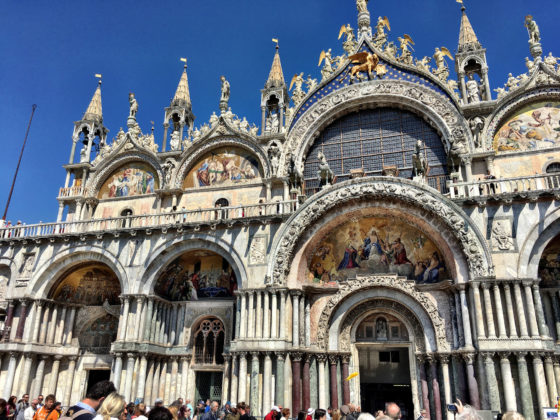 St Marks Basilica, Venice. Photo by J.F.Penn
St Marks Basilica, Venice. Photo by J.F.Penn
I’ve been to Venice three times. And the third time was by far the best. But when I went the first time, I feel like all the writing I’ve ever read on Venice, it was just completely wrong. In my experience, I got there, it was flooded. I’ve never read a book about the flooding, and how much it stank of the sewers, and how overcrowded it was, and those huge tourist ships, and it really impacted my experience.
How should we approach reading travel fiction or just travel books in general? Do we just have to take them with a pinch of salt?
Emily Thomas
Yes, we absolutely have to take them with a pinch of salt. I think travel books are always written with the author’s particular vision in mind.When you arrive, you may well have a very different outlook on that. And you’re certainly right. Venice is one of those places that has been so heavily romanticized that in a way, it’s difficult to see how the reality can live up to those romantic images of it.
And I mean it historically, if we go back before the 17th century into medieval travel, travel writing was absolutely chock full of lies, you know, people describe going to the Middle East and encountering dragons or great whales that come off out of the sea, and they’re sort of wandering around on the local coasts. And the Mandeville Travels describes meeting people with the heads of dogs. A lot of this is coming from the idea that whatever is unknown, we can somehow fill in the gaps. And there’s less of that today, partly because the world is more known, but it’s not entirely gone, and our brains are still filling in gaps.
Jo Frances Penn
Absolutely. And I wonder, I mean again, Malawi — if people don’t know it’s in southeast Africa, but landlocked — and Africa is one of these continents that I feel travel writing has impacted, I would say negatively, because so many popular-cited travel books are old.And they see Africa — which of course, is not monolithic, it’s very diverse — but many show Africa in a way that perhaps it was 40 years ago, but so much has changed in the last decade in terms of what’s happening in Africa.
How can we write responsibly about places to change stereotypes, or when we read, question those stereotypes?
Emily Thomas
That’s a really great question. I would start by saying travel books are about places, but they are also always about time. So it is always about the author’s experience of traveling to Malawi in 1970, or 2020, or wherever it might be.When we are all reading travel books, we must bear in mind the date that they were published, that’s going to have a big impact on how we approach them. Of course, I’m a historian of philosophy, so I’m going to stress the importance of dates.
With regards to changing stereotypes or leaving us to question them, I think that good writers should be conscious of stereotypes as they are writing and flag them up. That seems like something that the best travel writers do, actually, they approach people as individuals, and if there are stereotypes, they are mentioning them in order to deconstruct them.
Jo Frances Penn
Well, then I have another challenge for you because you said that travel is about otherness. And when we are ‘Other,’ I feel like we almost see things that people who live in a country don’t see. Like when I go to America and I walk into a grocery store, I’m just ‘how are there 10 fridges full of different sodas?’ It’s a tiny thing, but I notice that and an American would not notice that.And so when we are commenting on other places as we travel, I also worry in this time when we need more diverse voices, can you and I as white English women write about Malawi? And how does that compare to a Malawian author writing about Malawi?
Emily Thomas
If I were to read two books, one written by a white English woman and one written by a Malawian author that I would 100% be looking to the Malawi author as the authoritative tome, but I don’t think that means that we shouldn’t do it.You can only ever write from your perspective. All writing is written from a perspective, and that’s the same whether it’s me writing about Malawi, or someone from Blantyre going to the UK and writing about England.
There is no view from nowhere. The trick is to write from your perspective, being conscious that you are writing from a perspective.
So if I were to go to the US and write about how staggered I am by the sheer number of soda fridges, I should be overt about that, of course, be honest, I find this astonishing, because I’m from the UK, if I was from somewhere else, maybe I wouldn’t.
Jo Frances Penn
It’s funny, isn’t it? And I mean, I feel the same way. I think we have to write from whatever perspective we have.Let’s talk about maps, because I love that you start actually start the book with chapters on that.
I love maps, I’ve got a map of the world here in front of me on my wall. It is something that I find really important, and I’ve even written a fantasy trilogy about walking through maps.
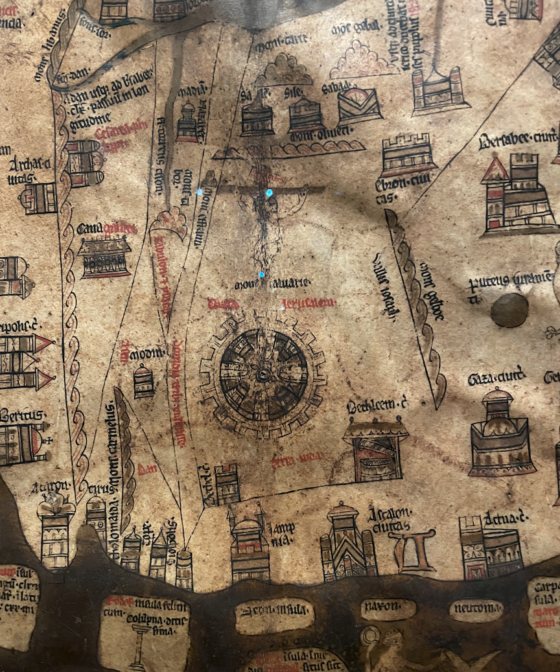 Detail of the Mappa Mundi Hereford cathedral Photo by JFPenn
Detail of the Mappa Mundi Hereford cathedral Photo by JFPenn
You question in the book, “Are maps things or processes?” What do you mean by that?
Emily Thomas
In philosophy, we draw a distinction between things that are static, so chairs, teacups, trees, versus things that are dynamic and continually changing processes, like thunderstorms, or running rivers.And what I find fascinating about maps, or one of the many things I find fascinating about them, is that I always assumed that a map was a static thing. You know, it’s something that you hold in your hand and you look at it much like a teapot, and that’s the end of it.
But there are some philosophers who’ve argued that actually maps are much closer to processes. And in defense of this view, they asked us to consider things like Google Maps. So Google Maps are being continually updated, as are all these online mapping software. And then the question is, does that mean that there’s a new map that’s coming into existence? Like once every second or so? Or is it rather, it’s the same map that’s continually changing?
And when you begin to think of maps, like that, I can then begin to think of other maps, perhaps written on paper, but also continually being updated. So famously during the Second World War in London, there are some maps in the British Museum that were updated as buildings were bombed. So as buildings were removed, people would change the map to reflect the new reality.
Jo Frances Penn
I was just looking at the wall on my wall. It’s an older Mercator projection. And Malawi’s still labeled as Nyasaland, which was its previous name. And of course, that’s what’s so weird, isn’t it? You can look at a map, even like Europe’s changed a lot. I mean, Europe’s changing right? Now we have a war on, who knows where that will end up — but it’s like these countries appear and disappear, and borders move. I’ve got this map on my wall. It looks static, and yet borders move all the time.You say in the book, “maps are objects of power.” So what do we need to keep in mind in terms of who drew the map, and in terms of power shifts over time?
Emily Thomas
So maps are always trying to tell us things. And they can tell us things in quite subtle ways. So, for example, whatever is placed at the center of the map is given a feeling of geopolitical force.In historical maps, perhaps that was Jerusalem, or Athens, and today, if you look at world maps produced in Europe, Europe is usually at the center of the map. If you look at world maps produced by China, or the US, those countries will be at the center of the map. And that’s telling you a lot about how the map maker sees the world. And what maps do and don’t represent, and also tells you a lot about the social power that the map maker is outlining. So whether they are including castles or churches or huts belonging to peasants or not, that tells you about what they’re trying to do.
There are some really striking examples of maps being used to persuade people about where the lines of power lie in the world. So for example, historically, you can see lots of maps of the same place with borders drawn differently, and that’s because the map maker is trying to convince you that here is where the border is, my country is really at this is an even today, depending on where you are in the world. If you access Google Maps, the borders will shift depending on your local country’s attitude towards disputed territories —
Jo Frances Penn
— which is just crazy. I don’t think I knew that before I read that in your book. I was like, okay, that’s weird. But I mean, why would it be any different because, for example, we travel to New Zealand a lot, because my husband’s a New Zealander, so we have family there. And when we look at prices for flights here in the UK, we get a completely different price than if we’re in New Zealand, even if we’re booking London to Auckland, for example. Loads of things change when your physical location is known to advertisers.But it’s kind of disturbing, in a way, isn’t it? The way that borders shift? I mean, again, on the map I’m looking at there is absolutely no way it reflects the actual size of the countries. The African continent has often made much smaller, hasn’t it?
Emily Thomas
Absolutely. Which is this famous problem with Mercator projection, that it makes the southern countries smaller in the northern ones, the ones closer to the center of the map, and Europe is subtly pushed towards the center of the map. It makes them bigger. And there are various projections that seek to address these concerns. And when you see the size of Africa represented, as it really is proportionate to Europe, and North America, it’s quite a shock because it is in fact, a gigantic continent. And it’s not this smaller, sort of squeezed thing that you get on the Mercator projection.Jo Frances Penn
Absolutely. So there’s so many things I want to talk to you about, but I want to come to Doom Tourism. You have a chapter on Doom tourism and which incorporates things like dark tourism to outfits for example, or but also places like the Maldives that might disappear or will disappear with climate change.Tell us about Doom Tourism? Should we travel at all? Or should we all just stay home?
Emily Thomas
In principle, I don’t think there’s anything wrong with doing tourism or dark tourism. So the idea of going to see a place before it’s destroyed because it’s doomed in some way. I think why not? That sounds fine to me. You know, you can imagine there’s a rainbow outside your door, someone’s calling to you, come and look at it before it’s gone. That just seems absolutely fine.Where it gets ethically tricky is when we are traveling to places and the very act of traveling is contributing to the doom of the place in question. That’s a really classic example is glaciers or underwater coral reefs. So when we visit a glacier, in addition to the CO2 that we may spend getting there, trampling all over the glacier can be harmful to it in various ways. If the ice is degrading anyway, then people walking all over it can hasten that.
The same with visiting coral reefs, you know, there are many articles on the internet ’10 places you should visit before they die off due to climate change.’ And lots of coral reefs are on the list. But again, the very act of visiting the reefs can damage them, and then it starts to feel unethical to visit these doomed places.
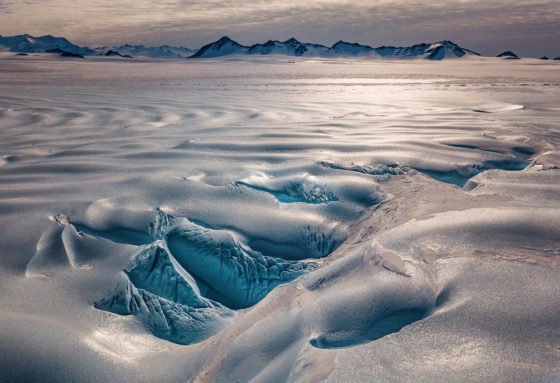 Union Glacier in Antarctica. Photo Licensed from BigStockPhoto
Union Glacier in Antarctica. Photo Licensed from BigStockPhoto
Jo Frances Penn
Yeah, and that’s why this idea of virtual reality or augmented reality could be great for travel. So I have scuba dived on the Barrier Reef and in Western Australia as well on Ningaloo Reef. And I learned later about how suncream on your skin can contribute to things. And yet, I remember those scuba diving in those places very vividly. They are highlights in my memory.But I absolutely think that VR scuba diving is what I want to do. I haven’t dived for about a decade, like I’m really not that interested anymore in all the gear and all the boat sickness and all of that. So, to me, a brilliant thing would be virtual reality scuba diving to go see the coral reefs.
But taking that further, what do you think of the future of travel in terms of virtual reality?
Emily Thomas
I think there’s going to be a lot more VR travel, if for exactly these kinds of reasons. Travel can often be difficult and scary and really inconvenient — and expensive. And I think VR offers us a really safe, cheap alternative.I think lots and lots of people are going to turn to VR for travel, I really do, and I think as VR improves, the more that that will happen. And I find that quite exciting, in part because we can travel to real world places that have been reproduced in VR, but also because we can travel to imaginary worlds that are going to be created for our enjoyment. And I’m looking forward to that as well. I think that will be that will be great.
Honestly, that said, for me, part of the value of travel lies in the difficulty and the fear and the inconvenience. And I don’t see myself wanting to give that up. I think rather I want to do both.
Jo Frances Penn
I agree with you. And I almost split it into two. For example, I went to the Egyptian pyramids back in the early 2000s. And when I see pictures now, it seems a hell of a lot more touristy. And if you go and see the pyramids, it’s the sound and light show, there’s 1000s of people and coaches, and it’s not like the movies, you know. But with a VR tour, I could see the pyramids up close, I could potentially go inside the pyramids, which you cannot do in real life. And that to me is a very touristy experience that would be better off in VR. But walking around the souk in Cairo, for example, or Alexandria, that is not the same. So there’s the experiential thing versus the famous monument thing.Emily Thomas
Oh, I like that. I think you’re absolutely right. I think the two can complement each other in that way. I also think there will be a lot of people who would opt for the VR Cairo souk. In addition, it partly because it’s hot, it’s expensive and people are bumping into you. And I think COVID is going to have a big impact on how a lot of people continue to travel. Moving forward, it’s all just going to feel safer.I have also been to the pyramids a little bit later than you, before the light show but post the tourism era. And what I was astonished by was the way that if you stood in precisely the right spot, you could take a photograph just with the pyramids against the background of sand. But if you turned in any other direction, the tourist carnival, the shops. It’s a strange experience.
Jo Frances Penn
Petra is another place or Angkor Wat, there are so many places where we want to see, not because they’re on ‘lists,’ but because they really are special places. And yet, sometimes you get there and they’re not special, like Venice, a lot of Venice would be better in VR. If you’re listening in Venice, sorry about that! But I mean, it’s so full of tourists.But then we come back to truth with a little t as in, if I make a VR experience of the Cairo souk, for example, I could walk through and record it with a special camera. And that is my experience.
But again, we’ve just captured it at one moment in time, or we could then edit it to make it seem more romantic or to fit some stereotype. Will VR again recreate this incorrect version of reality?
Emily Thomas
Or at the very least it will be a bastion of reality told from someone else’s perspective. I think that that’s absolutely right. Because even if it it’s based on real camera footage, it’s what the camera person chooses to focus on. Are they looking at the vegetables or the jewelry? What they’re panning over? Are they focusing more on the older people or the younger people? All of this is going to be told from a person’s perspective? And if you visited yourself, you would absolutely have a different one.So yeah, it will always be indirect in that sense that there are some VR experiences you can have now where I understand you literally pay a guide to wear a VR helmet or transmit things back to you. And then by telephone, you tell them, could you turn left here, I want to look more at this. So that seems like more that you’d have more control over what you’re seeing, at least in that way.
Jo Frances Penn
So many interesting things and lots we could talk about, but we’re almost out of time.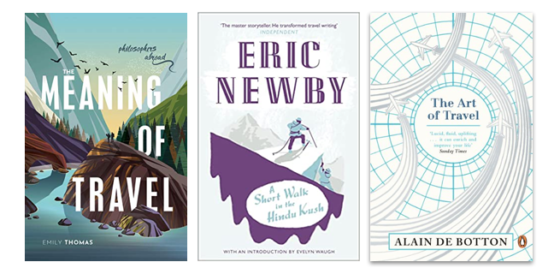
What are a few books that you recommend either just travel books or philosophy?
Emily Thomas
My favorite travel book is quite old now, but if you haven’t read it, I highly recommend it. It’s Eric Newby’s 1958, A Short Walk in the Hindu Kush. He’s wandering around the mountains of Afghanistan, getting himself into various scrapes. It’s really, really funny. And it’s also very thoughtful. I think that’s great.From a philosophy and travel perspective, my book is in fact, the only book on the philosophy of travel. But if you want to take a related but different angle, that Alain de Botton’s The Art of Travel. He explores the way that various artists and novelists have thought about travel. And that’s also a great read,
Jo Frances Penn
While there are similarities with De Botton, I definitely like yours better. We’ve talked about the themes, I guess, that you bring out in the book. I’m definitely someone who is romantic about travel, and clearly you are too. Travel means a lot to us, and so we naturally come at this with a positive and romantic view of everything. But it’s funny, I’ve also just come back from that walking the Camino de Santiago, the Portuguese route. I’ve been reading Camino books for over two decades — and I’m just writing my own, obviously — but I feel this responsibility to say some things that I don’t feel enough people say about how like busy the route is, and all of this kind of thing. So I’m pretty obsessed with the ‘truth’ of travel writing at the moment, so I think your book really helped.Emily Thomas
Thank you. I’m glad.Jo Frances Penn
Brilliant. Where can people find you and your book online?Emily Thomas
Thank you. So I am on Twitter @emilytwrites. If you want to check out some of my other popular writings, you can look at my website, which is www.EmilyThomasWrites.co.uk.Jo Frances Penn
Fantastic. Thanks so much for your time, Emily, that was great.Emily Thomas
This has been brilliant. Thank you very much.The post The Meaning of Travel With Emily Thomas appeared first on Books And Travel.
30 November 2022, 12:10 am - 36 minutes 51 secondsUntethered. A Woman’s Search For Self On The Edge Of India With C.L. Stambush
How can we adopt an untethered attitude to life, especially when it comes to expectations of travel? C.L. Stambush talks about how her experience of motor-cycling around India taught her more about herself, and how she brings that to her daily life. We also talk about connecting with people across cultural and language barriers, when taking risks is worth it, and how we need to keep pushing the boundaries of our comfort zone to live a more expansive life.
C.L. Stambush is an award-winning writer, journalist, editor and author of Untethered: A Woman’s Search for Self on the Edge of India.
Show notes
- Taking risks and discovering that life improves because of it
- Riding alone on a motorcycle around India
- Breaking down barriers when we travel to different cultures
- Getting over our fears around traveling
- If we are not pushing forward, are we sliding backward?
- Cultivating an untethered state of mind
- Recommended travel books
You can find C.L. Stambush at clstambush.com
Header and shareable image generated by Jo Frances Penn on Midjourney and edited on DALL-E.
Transcript of the interview
Joanna: C.L. Stambush is an award-winning writer, journalist, editor, and author of Untethered: A Woman’s Search for Self on the Edge of India. Welcome, Connie.
Connie: Thank you. I’m excited to be here, Jo.
Joanna: This is such an interesting topic.
You traveled around the edge of India by motorcycle back in the late 90s. Why did you choose that trip in particular, what led to that happening, especially back then, when it really wasn’t so common?
Connie: That journey was a long time in the coming. I would date it all the way back to when I was in kindergarten or first grade when I was very shy kid and I just hugged the wall and kept one shoulder to the wall at all times. But as I became aware of what I was doing, I didn’t like this aspect of myself. I felt like I was really losing out on engaging in life, because I just kind of watched it from the sidelines.
So over the years, I wanted to become braver and put myself in situations like forcing myself to stay up and watch scary movies or get past this very scary stuffed bear in the museum alone, and just kept pushing myself farther and farther. By the time I got to India, which is in itself a very long, convoluted story, I was working for a pharmaceutical company, and they were downsizing.
I never imagined that I would leave the United States. And I literally had this overnight revelation where I just woke up the next morning and said, I quit. I sold everything that I had, I bought a backpack, flipped a coin, bought a one-way ticket, landed in Germany, and kind of went, ‘Oh, I didn’t really have a plan or anything as to what I would do.’
From there, I progressed on through Europe and then Eastern Europe and then the Middle East. I wound up working in India as an editor for a wire service, the women’s feature service and then when that contract ended, I decided I was ready to leave Delhi but I was not ready to leave India.
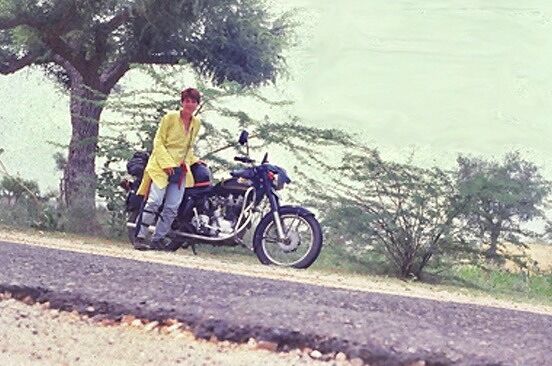 CL Stambush with her bike in India, Photo copyright CL Stambush
CL Stambush with her bike in India, Photo copyright CL Stambush
I didn’t want to see India on India’s public transportation. So the motorcycle seemed the most obvious thing for me to do, because everybody had a Royal Enfield Bullet. You have this wonderful bump, bump, bump sound. And it just called out to me. So I decided, I’m just going to do this.
Joanna: We’re going to go back into the book, but I just have to ask as a child, you decided to become braver and force yourself to try these things. And then, like you said, you quit, you sold everything. There’s definitely something in your personality that makes decisions quickly, and then does these difficult things. But of course, this book is set back in the 90s. But that’s not the end of your story. How has this attitude to travel and taking risks impacted your life since then?
Connie: I think that it has allowed me to take even greater risks than I probably wouldn’t have. When I came back, I decided I wanted to get a master’s degree. And so again, I just up and left what I had going on here and went to New York and got a degree from Sarah Lawrence College, in creative nonfiction writing, and then came back.
So it has given me the freedom to understand that the world will keep going and keep getting better for you if you just keep trying the things that you want to do, but are a little hesitant to do anyway. Nothing comes to a crashing end when you try something new. Usually, it works out better.
Joanna: I like that. Let’s step into the book. Now, I’ve been to India a number of times. And of course, much of India is ancient as well. And there are some really beautiful places. What are some of the most memorable places that still stand out for you even all these years later, either because of beauty or an emotional or spiritual resonance?
Connie: I had lived in India for over three years by the time I took this journey, so I had traveled to various places. And then when I did this travel journey, I was basically on the edge so not necessarily in some of India’s most famous places. But during my time in India, the places that stand out to me would be the desert.
I’ve always drawn to the desert, Jai Samir, and then also the mountains and South India because it’s just so much lusher and greener down there.
In terms of the things that stand out to me, it’s not really places, but people.
I met just so many amazing people while I was there, even people I didn’t necessarily have a conversation with or engage with, just people who were friendly.
First of all, as a woman alone, riding a motorcycle, I didn’t really look like a woman, I looked like a Westerner. I had full gear on, I had a motorcycle helmet on. And they couldn’t really tell that I was a woman.
But at one point, it was early on in my journey, and I was riding along the highway, and in front of me was this overloaded truck with all these women that had gathered from a field where they were out working, and were being taken back home again. They were very listless and just sort of worn out from working in the hot fields all day.
One of them began to watch me. And as she watched me, she became more intent as to try to figure out who I was, then she began to nudge a woman next to her. And soon, they’re all looking at me. And smiling really big, because there’s the recognition that this is a woman doing something that women just don’t do in India, which is one being on a motorcycle at that time, as well as traveling alone. And then it was just great. They just all smiled and waved, and it was just really uplifting.
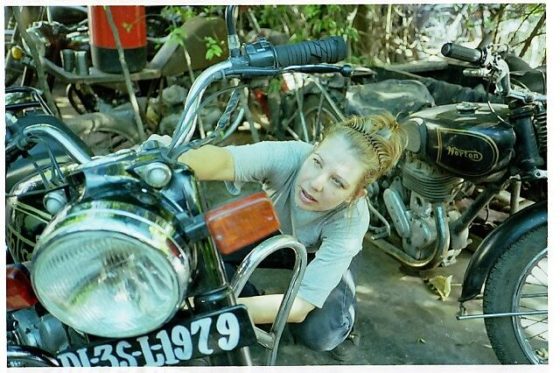 CLStambush with her bike Photo copyright CL Stambush
CLStambush with her bike Photo copyright CL Stambush
There were many experiences where I ran into women. There was another time when I got stopped at a train station, and there was no train on the track, but the barriers were down. And the minute I stopped as a foreigner, the men would sort of begin to crush in on me because of the space or the lack of space that we have between the US culture and the Indian culture. And so they got quite close to me and kind of closed in on me. And it was very hot and I began to take off my gear a little bit at a time.
And the minute they noticed that I was a woman, they didn’t know what to do with me at that point. So they all just kind of stepped back. But this gave an opportunity for these tribal women who had been standing at a far-off distance with some of their sheep flock. They had been watching, but there had been no opportunity for them, so when the men moved away, the women just moved in.
They wanted to feel my hair and compare it to their hair, and feel my skin and compare it to their skin. And I felt like at that point, because I was quite lonely on the road – and this was even still, within the first month or so of my journey – that it was just really a lovely experience to feel that I wasn’t so alone because riding a motorcycle as a woman alone in India, I felt very much like an outlier. And to have these women come up and tell me, we get you. You’re different. We’re different. It was just a very beautiful connecting moment for me,
Joanna: It’s one of the things, isn’t it, with travel there that you feel there are always people who can help. I was cycling in India and I came off my bike. It was after the monsoon rains. And I came off my bike in this tiny village and cut my knee and I was in shock. I was on the ground; I was crying my eyes out. And like you say all these women came out and brought water and tried to help me and we didn’t share the language. They obviously didn’t speak English, but I just remember everyone was so kind.
There’s that human connection, even if you’re a very, very different person from a different culture, right?
Connie: I agree. I think that’s what travel really does is it breaks down all these assumptions that we have in our mind when we’re back in our own culture. We’re back in our own hometown, we’re back in our own familiar settings. But when we’re out, all that is just stripped away. And it’s just people connecting to people, which I think is the most beautiful thing.
Joanna: You mentioned there about being a woman alone. And that example with personal space. I felt that too and it can feel quite claustrophobic. It can be quite scary.
What fears did you face along the way? You must have gone through some really difficult times and how did you overcome them?
Connie: I think by then I had become a much stronger person, obviously, than the person I started out as a child. I had been working very, very hard and very long to become braver. But it is a scary thing to be out there on your own. I found that when I was not in threatening situations, but just in situations, I would use my height to create a larger presence for myself in a space.
As a woman alone, I found that to be an effective thing just to stand taller, to feel broader in just in the normal space of walking down the street. I didn’t have a lot of scary experiences, but I had some I have, for instance, I believe that all the gear really made me stand out and made me, like I said earlier, a very other type person. But there was a time when these children came up to me, and they wanted to shake hands. And I wasn’t very obliging, and they were very fun, but they just kept on and then this little old man came along, and they pushed him into me.
They had become rather menacing. I don’t know what they wanted, but they weren’t just happy children any longer so they pushed the little old man into me. I got very, very angry, not at the children so much, but at the kind of cultural circumstances are allowed this and all these men then crowded in on me. I ended up slapping one of them, and ended up chasing him down an alleyway, which was a very scary experience because I had become somebody quite other than anything that I knew at all. And it wasn’t until I tripped and fell that I came to my senses.
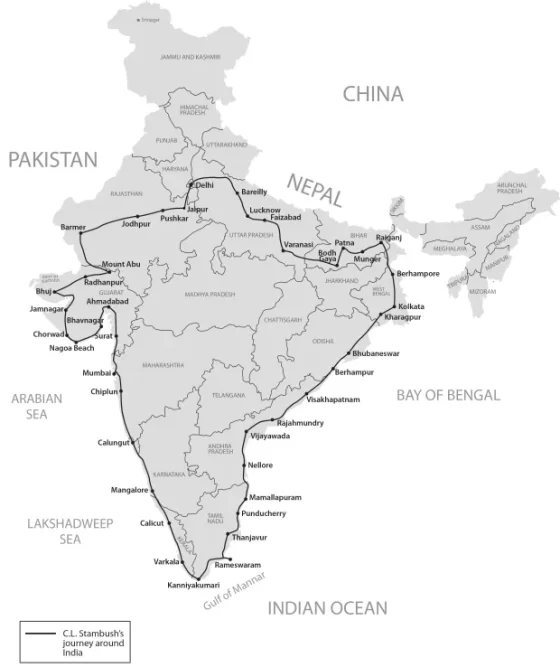 CL Stambush journey around India. Image copyright CL Stambush.
CL Stambush journey around India. Image copyright CL Stambush.
Joanna: Wow, that seems that’s quite extreme to find yourself in that situation. It’s like you learn these lessons to make yourself less afraid. But I’m certainly listening going, I would not cycle around India alone, I wouldn’t do that. And I know a lot of people listening would feel the same.
But there are lots of things that we can be scared of that stop us in life, even if those things are smaller than the journey you did. What are some of the ways that you might encourage people listening to, some people would say, Oh, I’m not I couldn’t even travel to India. from the US.
Or I’ve met people in the US, say in New York, and someone would say to me, “Oh, you’ve been to New Orleans? I’ve never been there. I just couldn’t do that. I couldn’t.” And I’m like, it’s in your country? How have you not traveled that far?
How can people get over the fears of things being different?
Connie: I think that’s a great question. I would hear people when I lived in the downtown section of my hometown, I would have people tell me, “I would never live down there, I won’t even go down there. I don’t think that’s safe.” So I really think it starts in our mind, what we think of someplace. And maybe these are places we don’t even know.
We have to begin to educate ourselves on what those places are and who those people are. And I just feel like in my experience, when I’m in a place that I don’t know that it’s the people that make me feel welcome there. I find people everywhere make me feel welcome, when I go to these places, whether you go to New Orleans, or to India.
I get that riding a motorcycle is certainly not for everyone. And it’s not even for the majority. But going outside of your comfort zone is something that we can do in small ways. Even if it’s just like a small thing, like, oh, I would never feel comfortable eating in a restaurant by myself, well, that’s a kind of a small thing that we can do. And we can get used to that.
When we get used to that, we find that there’s nothing really bad happening to us. We just perceive that something bad would happen, or we would feel not comfortable there. But then when we experience it, we understand that it is okay. And that inches you along, I think, to try different things. It’s not a big leap. I didn’t go from living in Evansville, Indiana, to riding a motorcycle. There were so many little incremental steps along the way that you just keep elevating to the next level.
Joanna: I agree with this pushing out of the comfort zone, and particularly during the pandemic, I really felt that my comfort zone shrank and we all were so trapped in our areas. I will walk the same paths around and around. It took quite a lot for even someone like me, and I’ve traveled a lot, I’ve lived all over the world, to push myself back out there again. Is that something that happened to you? Have you found that just incrementally you’ve been able to keep pushing this comfort zone out?
Connie: I think that when you stop doing it, then when you try to start doing it again, it gets harder, you’ve kind of lost some ground, don’t you? Once you’re in the groove of keep pushing yourself out there, then it gets more and more comfortable when you stop doing that. You stall a little bit and you’ve got a little bit of a restart to get going. Again, I think that’s pretty usual for most people.
Joanna: I almost feel like if you don’t keep pushing outwards, it shrinks you and shrinks you and shrinks you and that’s why a lot of older people I feel as you get older and obviously maybe you don’t want to travel so much in your 80s for example, but I feel like if you don’t push it, then it will kind of come closer to you and shrink you.
I felt personally that my life shrunk a lot more in the pandemic, and part of this podcast was really just keeping my own horizons expanding.
Connie: I think you’re right. I think if you’re not moving forward, then you could be sliding backward. And I think having that awareness of who you want to be and where you want to be and the type of person you want to be, and keep pushing yourself out that way.
My mom’s a great example of somebody who does the things she knows she needs to do, even though she would rather not do them. Forces herself to go out, and she’s in her 90s now, so she forces herself to go out, to do things just to keep engaged with other people when it would be easier just to not go out. So maybe I get that from her.
Joanna: I think you’re right. And also, the wonderful thing about travel is that you’re meeting people in real life. Whereas I feel like a lot of the media, a lot of social media, we get the wrong idea. And we might find things that reinforce stereotypes, or that are completely wrong half the time. So it’s almost like going to these places and challenging what we think we know often makes us see that we didn’t know it after all, especially in a huge place like India, which is so diverse.
Connie: Yes. And I think that’s very good. There’s a line I think that the Buddha said is, “Don’t believe everything you think”, and I really try to remember that because that is so true. When we think we know something, and then we meet the thing that we think we understand, we usually find out okay, I was completely wrong, at least in my experience.
Joanna: What were you wrong about on that motorcycle trip?
Connie: Oh, I don’t know that I was wrong so much about anything on the motorcycle trip because I sort of took it moment by moment. I tried to get through. I had no experience riding a motorcycle, I had taken a one-week course in Indiana. So there were 12 motorcycles in an empty parking lot, which does not at all prepare you to be on a motorcycle in India, where there are billions of vehicles on the road.
My neighbor had given me really great advice. He said ‘just practice stopping.’ That was his advice. So when I got back when I got the motorcycle in India I took it slow and got used to it and got comfortable with it and then took it out on the road.
I didn’t have these big objectives to meet each day. In the beginning, I could not ride very far at all. A couple of hours and I was aching very much and it was very hot and it was very hard and roads could be very dangerous and there would be traffic coming at you and not necessarily staying on their side of the road. But the longer I did it, the more miles I got underneath me the more comfortable I got with it all.
Joanna: You named the motorcycle Kali, a goddess I also identify with. I wrote about Kali in a thriller of mine, Destroyer of Worlds. But a lot of people listening might not know anything about Kali.
Tell us more about Kali and why you chose that name for your bike.
Connie: She is the most badass Goddess that there is. I think there are about 33 recognized gods and goddesses and something like 330 million additional ones that not everybody agrees on. But she’s one of the main Hindu goddesses and she is half benevolent and half warrior but all the images of her are very fierce.
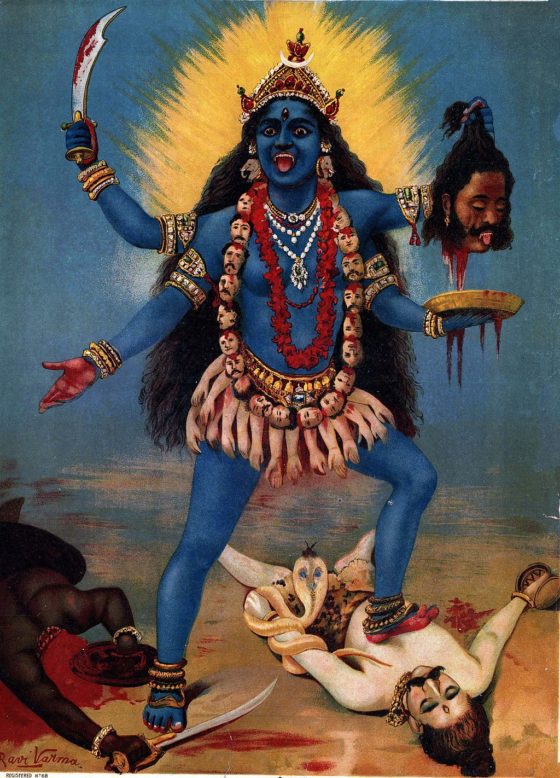 Goddess Kali. Photo by Raja Ravi Varma, Public domain, via Wikimedia Commons
Goddess Kali. Photo by Raja Ravi Varma, Public domain, via Wikimedia Commons
And why I chose her is because one of the things that she’s known for is revealing our true selves. In a quest to discover who I was, she seemed to not only be the right goddess to have as a partner with me, but the right one to help me on this particular journey, which I’m trying to identify who I really am and who I really want to be.
Joanna: You say fierce, but most of the images of Kali are holding a decapitated head and there’s all these hands and it’s basically death and multiple arms and pretty, pretty scary. That’s a more extreme version. When you told people along the way were they surprised that you even chose this goddess?
Connie: No, they didn’t seem surprised. I had Kali stenciled on this side of the tank in Hindi. So people recognized it. And one day I was in a hotel and the hotel clerk gave me a note from a traveler who had seen me arrive on this motorcycle. This just comes back to people who are just so helpful and so encouraging along the way. They had seen me ride in on the motorcycle and left me a note telling me, “To the rider of Kali, I wish you all the best of luck in your journey.”
Joanna: That’s lovely.
How did religion or spirituality play a part in your journey other than just the name of the bike? And did you visit any particular temples along the way, because there was an underlying theme that wasn’t there?
Connie: Yes. So in order to navigate around this large country on its own, I decided that, as a woman trying to find out who she was, trying to put together the type of person I wanted to be, that I would visit the Kali temples. Now the Kali temples – there are 52 and or 51, depending on which version you read – contain these pieces of the Goddess Kali that fell to Earth.
And then these Shakti Peetha temples sprang up, so they are power temples. Each one of these temples has a piece of the goddess. So my plan was to visit each of the temples and reassemble Kali as I went along the way. But I discovered that I really didn’t enjoy visiting the temples. And when that discovery came to my mind, I realized that I had created that as almost a crutch for myself, and that I no longer needed that.
Joanna: It’s interesting, because I do feel like having a deeper meaning, and or having a framework for a journey, in the way that you did there, is better than just saying, “I’m just going to motorcycle all the way around India.” I almost feel like even though you changed what you wanted, it did start you out with a direction that was more than just get on the road. Do you think that plan helped you?
Connie: Oh, absolutely. Yes. I think what it taught me was what I took away when I felt like I no longer needed to find because, for one reason, they were very difficult to find. I had a map, I had locations, but people didn’t always agree on which was a Shakti Peetha temple and which wasn’t. So it became increasingly difficult to discover the actual temple.
Now, I knew that I wanted to make it to the end and reached the Kali temple for the Kali Puja, and I managed to do that. But it certainly did give me that kind of understanding that I needed this in the beginning. And then when I realized, hey, I don’t really need this, that felt like a growth for me. That was what Kali was doing for me because she is the goddess of rebirth.
Joanna: Sometimes the search for self involves something dying in order for something new to be reborn.
And Kali is definitely the goddess of death. I like that.
When I heard the title of your book, Untethered, I knew I wanted to talk to you because I have also got Untethered as a title or draft title for a book, which I’ve had around for a while it might be around for as long as yours was. What does ‘untethered’ mean to you?
Connie: That’s a great question. I feel like because I felt as a child bound and tied to and stuck to this wall that that being untethered was both a physical and but more a psychological undertaking. So I wasn’t physically scared any longer or attached to this wall.
But being untethered for me is really a state of mind, the way you look at things. I saw myself much younger and even as a teen very attached to certain things. But as I became untethered, I became unburdened by the things that I thought I believed, I felt like that they, in the end, were weighing me down as well.
Joanna: Was that also about the USA? Because I feel that a lot of Americans who’ve traveled a lot or who end up as living as expats in other countries, they are trying to untether themselves from what being American is. Is that something that you were trying to untether from and how have you come back?
Connie: I don’t think I was trying to untether from being an American. I think that when I was out in the world, I felt like I needed to be a representative of a good American. I met a lot of travelers who were Americans who would have Canadian flags on their backpacks and things like that, but I always felt like it was it was up to me to show the world that the way that they see Americans isn’t necessarily true, through my own actions.
Being untethered is really the way you look at your life, whether you see yourself tied down or you see yourself as free.
I think it really became a state of mind for me.
Joanna: When you returned to the USA and like you said, you studied a Masters in quite a traditional industry now, the publishing industry in writing. Have you retained that sense of being untethered, even as you’ve gone back home?
Connie: I think it’s the constant moment-by-moment, where you keep asking yourself, “Is what I’m doing now, or about to do, taking me to where I want to be?” As far as the state of mind, if you don’t pay attention any longer to what you’re doing, you can slide into being back where you are a person that you didn’t want to be. So for me, it’s just a constant moment by moment of trying to figure out, will thinking this way, free me or enslave me?
Joanna: What’s an example of that?
Connie: Oh, I imagine in American politics, or just seeing people as what we think that they are, rather than seeing them for who they are. Everybody’s got the good and the bad in them.
Joanna: So you mean looking at other people in terms of an untethered attitude? I guess I thought it was more about living your life with a certain amount of freedom in terms of I don’t know, for example, not buying a house would be an untethered way of living.
Connie: Yes, I still do not own a house. And I think you’re right. I recently was looking at buying houses and thought again, no, that is like an anchor for me. So you’re right, that would be an untethered way of living.
But I also think it’s not just the physical tethering to the ground. I feel grounded now that I’m back in the United States, but I don’t feel tied down. I feel like I have the freedom to do the things that I want to do. Because the trip taught me that I’m – in fact, all the travel taught me that – that I can pick the time in which I want to do them now.
Joanna: This is something I ponder about a lot. Because up until the pandemic, I didn’t feel like I had a home. And that didn’t matter. Because I like this idea of being untethered. And I can find it, I can make it home wherever I am in the world, right? We’ve lived all over the place. Maybe home is the people that you love, things like that.
But I’m starting to change my mind about the concept of home. I have bought a house in a community and I almost feel like I’m putting down roots. That’s kind of scary for someone like me, who wants the freedom to be untethered.
What do you think about the word home and putting down roots? Are those things that you think about or want?
Connie: They are and like you, Jo, I feel like I could make a home anywhere. But I have been thinking about if I did make a home, what would that home be? I would want a small home so that I wouldn’t feel as anchored by it.
I have gotten rid of a lot of possessions. The more I’m in one place, the more I gather. So I tried to keep an eye and a mind on exactly how I can keep letting things go, keep untethering myself from the physical world like that.
I think it’s nice to think about nesting, it’s nice to be in your home and have your things around you. It’s hard to be on the road for a long period. I was on the road for five months, with nothing more than would fit into the couple of bags on a motorcycle. That is a very stripped-down way of living.
Joanna: It’s very tiring, isn’t it? I had [ digital nomad Nora Dunn ] on the show recently, and she said the work of travel, which is finding somewhere to sleep that night and getting the money right. And in India, finding water that you can drink. There’s work associated with active travel.
Connie: There really is. And it’s on a level that we don’t think about when we’re in our own environment, the things that we take for granted. But when you’re out in the world, and you’re really stripped down of all those securities, you do have to work at finding those sorts of basic things again.
Joanna: That’s also quite nice in our local environment is to try and look at things with the eyes of a traveler, and figure out what would be difficult if someone comes to our country. When I first went back to the USA after the pandemic, a country that I’ve been traveling to for decades, I felt like a stranger for the first time in a long time. I saw some weird things about America that I hadn’t really noticed before.
Do you notice things with the eyes of a traveler now?
Connie: I hope so. I hope that I’m still keeping that fresh in myself. I try not to walk the same path. I’m always trying to shake it up. I try to go down alleys because they’re very overlooked pathways in our city but you get a completely different perspective when you go down an alley, then you go down the front of a street. So I constantly try to push myself to change it up so that I can keep seeing things fresh and new.
I do think that is the danger to fall back into not questioning things, to not asking why is it that way? Or how can I see this differently? Or how would this person see this? Because it’s easy to become complacent like that.
Joanna: And then it turns into a sort of jaded, take-it-for-granted attitude, which is why I think people sometimes are unhappy is because they’re not looking at things with new eyes and trying new things.
Connie: That’s very true. Yeah, that’s a good point. I also think people, they just believe what they think. And they don’t even know why they think that way.
Joanna: And that questioning can really help.
The subtitle of the book is ‘A woman’s search for self on the edge of India.’ Did you find yourself? Or are you still looking?
Connie: As I alluded to, earlier, I became someone that I did not expect that I would be. I would have never predicted that kind of behavior and myself. And it came as sort of a combination of many things.
I was feeling very tired, the heat of it, the emotional isolation of it – that became very stressful and heavy for me. And then when I was in this situation, I really just felt like I cracked and went over the edge. And then I literally went over an edge when I chased someone. And that is not at all who I am. But I think it showed me that I have the potential to be people I don’t know. I can be good or bad.
Joanna: When you take these trips, when you travel in a certain way with this openness, it often doesn’t end up the way you expected or the way you planned. And if it did, I guess it would just be a holiday.
Connie: Yeah, and I think we can take that even to our hometown, own town roots too. Because if we have these expectations of people just in our everyday lives, that often doesn’t turn out the way we expected or wanted either.
So if we just keep an open mind, and then open our heart and that mindful presence in each moment without putting expectations on things. That’s where the disappointment comes when we expect something to go one way, but it doesn’t.
Joanna: That’s fantastic. So this is the books and travel show.

Apart from your own book, what are some books that you recommend about travel in India or just travel in general?
Connie: Oh, there are so many good books out there, so many written by women that really helped me even understand the kind of story that I wanted to tell.
One of the first ones that comes to mind is Robyn Davidson’s Tracks. A woman who solo trekked across 1700 miles of the Australian outback. She’s this woman who decides she’s going to get these camels, and she’s never handled camels ever, and then take them across this huge journey. So I thought that was very inspiring to see women doing things that women aren’t really expected to do.
The other one would be Cheryl Strayed’s Wild: Lost and Found On the Pacific Crest Trail. I thought that was a great book to really understand what it was like for her, again, to do something that she wasn’t really experienced or trained or skilled to actually do. But she learned and she grew into that as she went.
As far as being in India, one of my favorites is Hindoo Holiday, which is a very old book by J.R. Ackerley. I think it was published in 1932. But it’s very funny. It takes you into the day-to-day life of someone living and working in India, in New Delhi, I think, maybe not in New Delhi, but in India.
And then the other one would be William Dalrymple, City of Djinns, which is about his year of living in Delhi. Again, there are all sorts of characters that he meets and culture clashes, where his own culture and his own expectations are really turned upside down when he’s in a different situation. And then how do you deal with that?
Joanna: All fantastic books.
Where can people find you and your book online?
Connie: My book is just about everywhere. It is, of course, on Amazon and is in Barnes and Noble. If you’re anywhere in the world, if you wanted to have your local bookstore order it, they can order it through Ingram Spark’s global distribution. There is a paperback there is an ebook. And hopefully, by the end of the year, there will be an audiobook of it as well. My website is www.clstambush.com.
Joanna: Fantastic. Thanks so much for your time, Connie. That was great
Connie: Thank you so much. I enjoyed talking with you.
The post Untethered. A Woman’s Search For Self On The Edge Of India With C.L. Stambush appeared first on Books And Travel.
3 November 2022, 12:10 am - 32 minutes 37 secondsA Pilgrim In The Path Of History. Solo Walking The Camino De Santiago Portuguese Coastal Route With J.F. Penn
In September 2022, I walked the Camino de Santiago along the Portuguese Coastal route. It was around 300 kilometers from Porto in Portugal north along the coast and then inland to Santiago de Compostela, Spain, which took 14 days of back-to-back walking.
I walked alone and carried my pack with everything in it, and I organized my accommodation through Macs Adventure so I knew where I was sleeping every night. I’ve posted a day by day breakdown of the route and my gear list separately, and in this episode, I go through some of my lessons and thoughts from the Way.
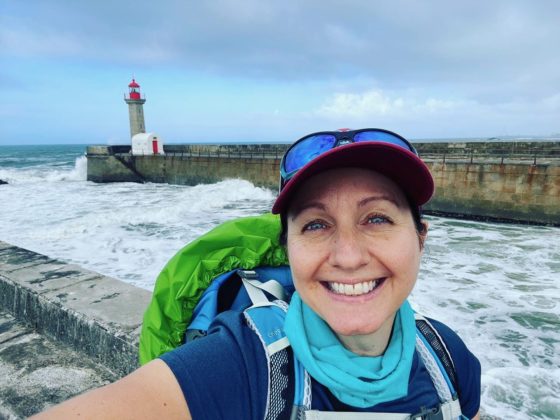 JFPenn at Farolim de Felgueiras lighthouse, Porto
JFPenn at Farolim de Felgueiras lighthouse, Porto
Show notes
- How walking in the path of history puts life in perspective
- If you’ve lost direction in life, pilgrimage can help
- Pilgrimage proves you can do hard things, and that knowledge helps back in your daily life
- A fusion of sacred and secular
- The Camino is an industry — and it always has been
- Your Camino, your way. Practical considerations and tips.
- Why I needed these last years of walking alone across a seasonal change in my life
You’ll find additional reflections and tips in Pilgrimage: Lessons Learned from Solo Walking Three Ancient Ways, out now at jfpenn.com/pilgrimage.
(1) Walking in the path of history puts life in perspective
The cathedral at Santiago de Compostela is almost a thousand years old, and pilgrims have been walking there since medieval times from all over Europe. I started in Porto, Portugal, with its historic center and cathedral on the banks of the river Douro.
The route heads north along the coastline past Roman fish-salting vats, and at Matasinhos, there is a sculpture of women wailing as they look out to wrecked boats on the horizon where their fishermen husbands lie beneath the waves. Life retains a familiar rhythm through the ages and some aspects of being human never change.
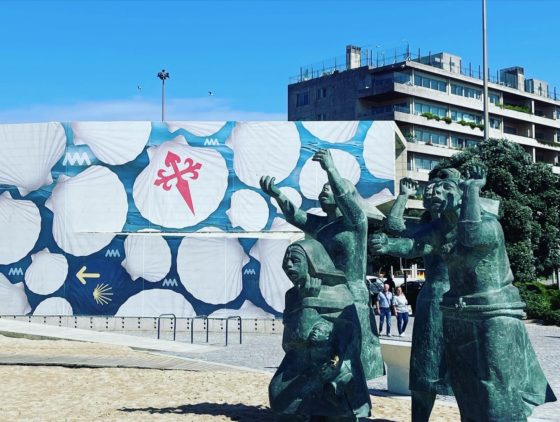 Matasinhos Camino office with statue of grieving fisherwives, Photo by JFPenn
Matasinhos Camino office with statue of grieving fisherwives, Photo by JFPenn
Walking every day shrinks life down to its basic elements. Eat, sleep, walk.
You appreciate the simple things — shelter from the rain and wind, a hot shower after a long day, painkillers and blister plasters, coffee in the first few hours of the day, or a cold beer when the sun is high, local bread and olive oil when you’re hungry, an encouraging smile from another pilgrim.
Once you step away and see how other people live, and experience being uncomfortable, or in pain, somewhere you can’t control your environment, it’s easier to be grateful for what you have and what you will return to. It’s easy to take these comforts for granted until we lose them, even temporarily.
I travel partly because it helps me see how insignificant I am on the face of the world, and walking intensifies this feeling as it is so slow. When I look at a map at the end of the day, I see I have only crossed a tiny part of a tiny area in a little corner of the world. I can only move at my pace, which for me is what English walkers call ‘bimbling,’ a relaxed gait, stopping regularly for photos, notes, or coffee when available.
When at home, the daily grind of life makes everything feel important and urgent. It’s easy to get stressed about a deadline or the emails that pile up, or the jobs that always need doing. Perspective narrows, even as we worry about the bigger things we can’t control — the economy, war, disease.
When on pilgrimage, I am just another human walking on the face of the world, a tiny speck in the grand scheme of things, a flash of light, gone so quickly.
The waves of the Atlantic will continue to crash on the shores after my footsteps are washed away. The Cathedral of Santiago de Compostela will welcome more pilgrims after I have gone, the same words of the Mass will be spoken by the next generation. I am comforted by my insignificance, and I can return with a perspective on what is truly important.
While walking an ancient route like the Camino helps you reflect on mortality, it is almost impossible to comprehend a thousand years of pilgrims walking ahead and many more coming behind. But while I walked, I had a more vivid reminder of memento mori — remember, you will die — as Queen Elizabeth II died. Each day of my Camino was punctuated by snippets of her life on TV in coffee bars and glimpses of newspapers, and I couldn’t help but read the UK papers online when resting at the end of the day.
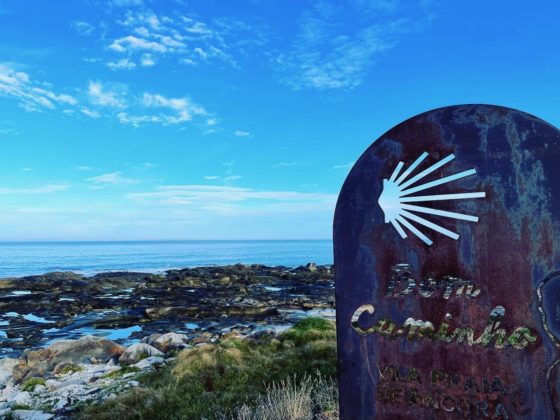 Bom Caminho sign Walking out of Vila Praia de Ancora Photo by JFPenn
Bom Caminho sign Walking out of Vila Praia de Ancora Photo by JFPenn
It was strange to walk outside of my country during such a historically significant week. I remember seeing newly carved statues of the Queen and Prince Philip mounted outside the cathedral in Canterbury on my first pilgrimage in October 2020. The stone was paler than the other sculptures of historic monarchs. The features weren’t weathered — and of course, both were still alive. There was a sense of standing next to living history, as another generation passed, and now they are both gone.
I am not an ardent royalist by any means, but the Queen was a constant across my life as she was for many Brits. As I walked, the news was full of pictures of her as a young woman, then middle-aged going through the trials of life, then an old woman at her husband’s funeral, and in her final days, standing bent over and smiling as she welcomed the new Prime Minister, Liz Truss. The span of an extraordinary life against the backdrop of history, much of which I remember over the last 35 years at least. Her life passed by, as will mine and yours. Even a Queen cannot hold back the end.
I walked into Santiago de Compostela on the day of the funeral and I watched her coffin lowered into the vault at Windsor Castle as I rested in my hotel that afternoon. It was a fitting end to my pilgrimage and underscored the sense that something must die for change to happen, and new life can emerge from the ashes of the old.
(2) If you’ve lost direction in life, pilgrimage can help
A pilgrimage is a clear task with a clear direction. You have a starting point and a destination and if you follow the way-markers and the guide book, you have a route to get there. You might get lost for a short time, but if you keep going, you will reach the end.
Once you are on the trail, whatever that might be, the pilgrim’s day is much the same.
Wake up, wash and get dressed.
Check feet, tape and plaster blisters as best you can before putting on socks and walking shoes/boots. Take painkillers if you need to.
Pack your bag.
Eat breakfast, or pick up some food to take for the day.
Walk, maybe alone, maybe with others.
Stop for coffee/food/beer depending on the time of day and facilities en route.
Walk. Rest. Walk.
Arrive at accommodation.
Shower while washing sweaty, smelly clothes.
Hang clothes to dry.
Check feet and dress blisters. Take painkillers if you need to.
Eat dinner, maybe alone, maybe with others.
Rest and sleep.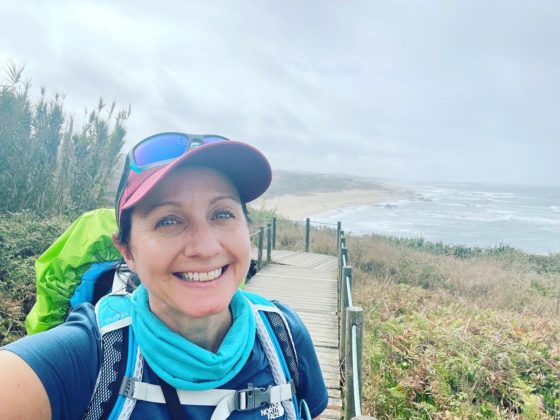 JFPenn near Labruges Portugal
JFPenn near Labruges Portugal
This daily repetition is a blessing of pilgrimage, as it simplifies life to its basics. You have no purpose but to get up and walk, and if you make it to your destination for the night, you have achieved your goal. The daily difficulties of normal life fade as you deal with the immediate issues of pain and hunger and exhaustion. You sleep satisfied, and tomorrow you get up and do it again.
Pilgrimage creates clear boundaries, and that can be a great comfort in difficult times.
(3) Pilgrimage proves you can do hard things, and that knowledge helps back in your daily life
You need ‘starting energy’ to plan and organize your trip, to turn it from a dream or a goal into reality.
Many people fall at this first hurdle and you need to overcome obstacles and fears to get even as far as the starting point. You need to book time away from normal life and since most of the Camino routes are a physical challenge, you also need to train in preparation.
I’ve been wanting to walk a Camino for more than twenty years, and I only found my ‘starting energy’ since the pandemic put the brevity of life into perspective. I know how it feels to say ‘some day,’ but that day will never come unless you make a decision, book a route or a flight, and commit.
Once you begin, you need ‘pushing through’ energy, especially on the days when you’re tired and in pain and emotionally broken and you just want to give up.
I woke up on the eighth day of my Camino in the village of Oia, Spain. A hurricane had blown in the night before, cutting the power to the village as I lay in bed listening to the violence of the wind and rain. When I woke, it was still dark and rain pounded down outside.
As I taped my feet and plastered my blisters, I wondered what the hell I was doing. I did not want to walk out into the storm, especially when every step was painful. I still had seven more days of walking to get to Santiago de Compostela, and given the state of my feet, it would only get harder.
But pilgrimage is not a holiday. It is meant to be a challenge — and part of the challenge is not giving up.
A long-distance walk is a test of stamina. Each day might be a manageable distance in itself, and nothing too challenging for a single day’s walking, but day after day — especially on the stones of the Portuguese route — the fatigue and pain compound.
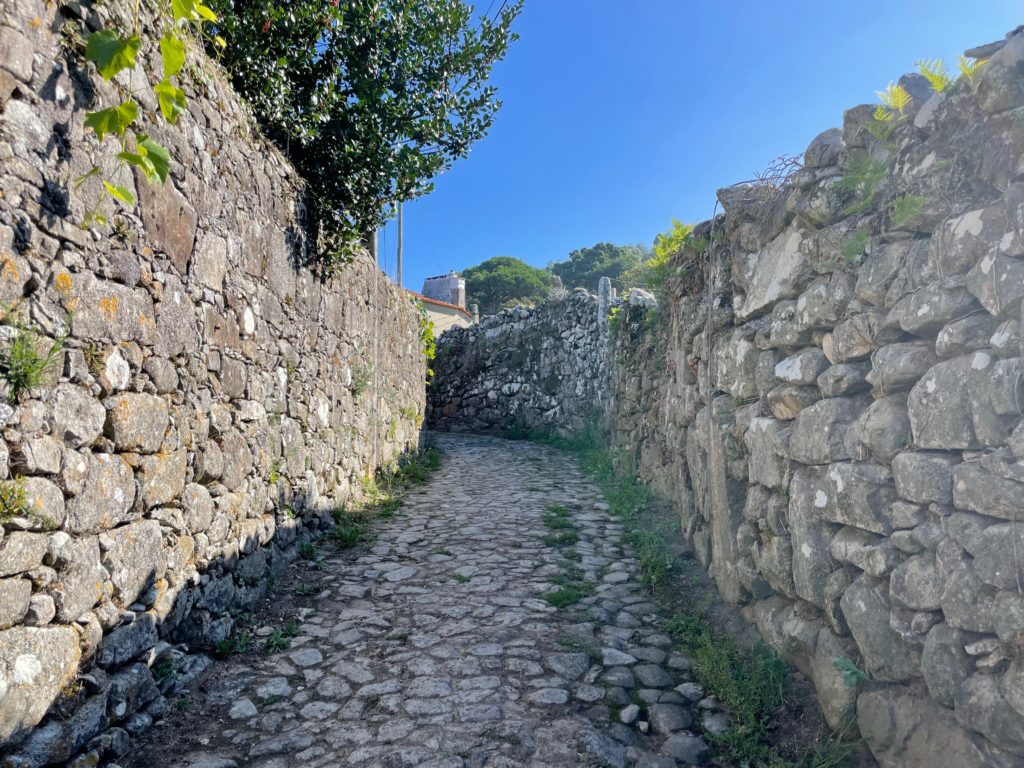 Stony back streets at Carreco Photo by JFPenn
Stony back streets at Carreco Photo by JFPenn
It’s easy to give up on the Camino, as you can call a taxi at most accommodation and other places along the route each day. Many people choose to skip a stage and take transport to their next hotel, so the temptation is always there — and if you truly need help, then, of course, you must take it. But I know the difference between the ‘normal’ pain of long-distance walking and acute ‘something is definitely wrong’ pain.
At times like these, when the struggle is more mental than physical, I write in my journal. Some might pray, but I find solace and answers in writing.
I moan a lot and list all the things that hurt and why I want to stop and give up and go home. Then I write about why I am walking and why I should continue. I know this pain is temporary and it will fade, but the pride in finishing will be mine for the rest of my life.
I write my affirmations over and over again: I am strong. I can do hard things. I will finish.
That morning in Oia, I took some painkillers, put on my rain gear, and headed out into the storm.
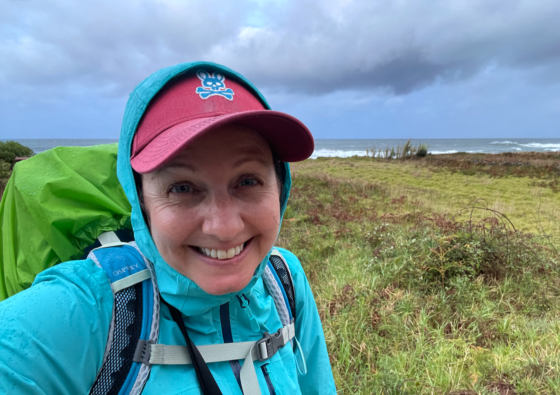 JFPenn walking out of Oia in the rain
JFPenn walking out of Oia in the rain
This ‘pushing through’ energy will get you to your destination and help you overcome obstacles along the way. Then you need ‘finishing energy’ to return home and reflect on the experience, to bring the lessons of the Camino to the rest of your life.
It’s too easy to arrive home, put your pack away and your clothes in the wash, then catch up on the inevitable life admin and everything you’ve missed. By the time your blisters have healed, you may have already forgotten the lessons of the Way, and finishing energy is needed to find the gold and incorporate it into your life. It might be re-reading your journal, or going through your photos and printing those that still resonate. It might be taking action on a decision you made on your walk.
Don’t just slip back into life as if nothing has changed. The gifts of pilgrimage take time to emerge so allow space for them.
This episode is part of my finishing energy and I’m also writing a book on pilgrimage, which includes lessons from the Pilgrims’ Way and the St Cuthbert’s Way in addition to the Camino. It will be out in 2023, so depending on when you’re listening, check out www.JFPenn.com/pilgrimage for links.
(4) A fusion of sacred and secular
A pilgrimage is a journey to a place of meaning. The Camino was originally for Christians who walked to the relics of St James to atone for their sin, or to ask for healing or intercession with God, but it is more of a secular experience these days. It certainly was for me, although, of course, if you are a person of faith, you will experience it differently.
I talked to many pilgrims on the Way and not a single one said they were walking for reasons of faith. Many had thought about the Camino for years and saw it more as a physical challenge, or a chance to get away and make a change in their lives. A surprising number had walked parts of it before and returned to try alternative routes and experience the camaraderie of the Camino once again.
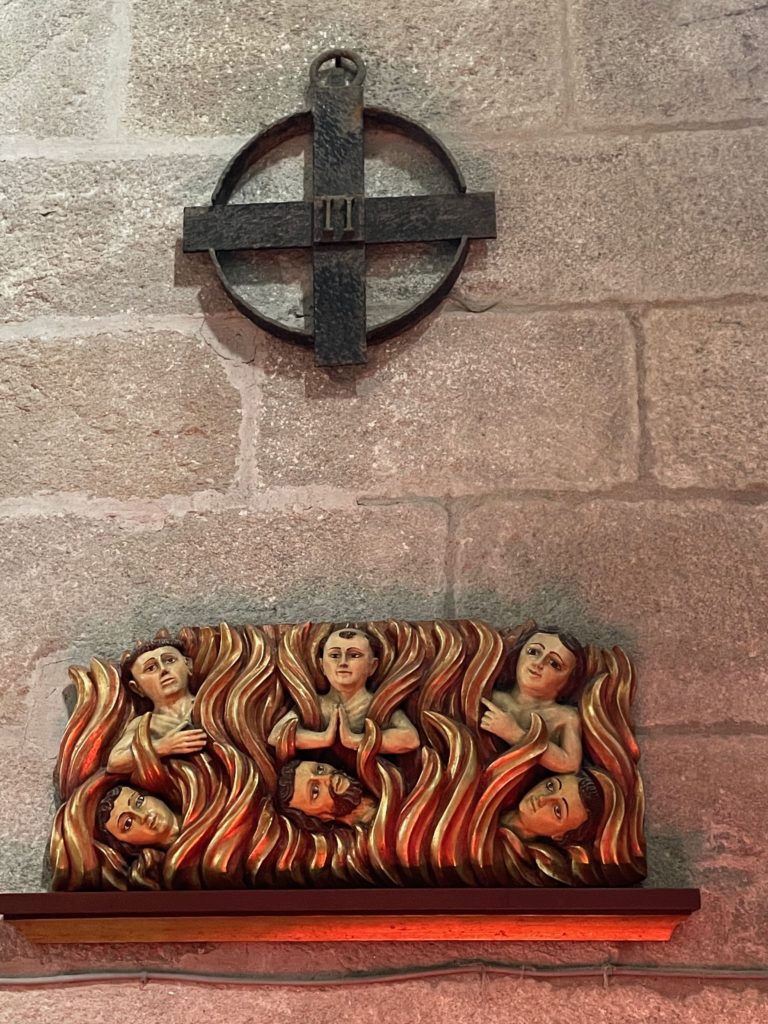 Burning sinners in Colexiata de Santa María de Baiona Photo by JFPenn
Burning sinners in Colexiata de Santa María de Baiona Photo by JFPenn
There were elements of the sacred along the route if you looked for them. Roadside shrines to the Virgin Mary saving sinners from burning boats, and later, shrines to St James, sometimes just a carving on a rock, and other times, full-size sculptures and chapels. There were plenty of churches along the Way, but the convoy of pilgrims stopping to get their Credentials stamped made them crowded and noisy. I found more moments of peace in graveyards along the Way than sitting in the nave of any of the churches.
Santiago de Compostela itself is a busy city with a thriving tourist center and pilgrims are just one type of visitor. The cathedral is packed full at every Mass, of which there are several each day, and there is nowhere to find silence if you crave it as I do. The cathedral’s imposing Baroque architecture and the relics of St James in the crypt are a necessary part of the end of the Camino, but I felt more of a spiritual insight in the nearby Monasterio de San Martin Pinario, which was completely empty when I visited. The church was also a cemetery for the Benedictine community, their bodies laid under the stones of the nave, so the living could remember them and reflect on the inevitability of their own fate.
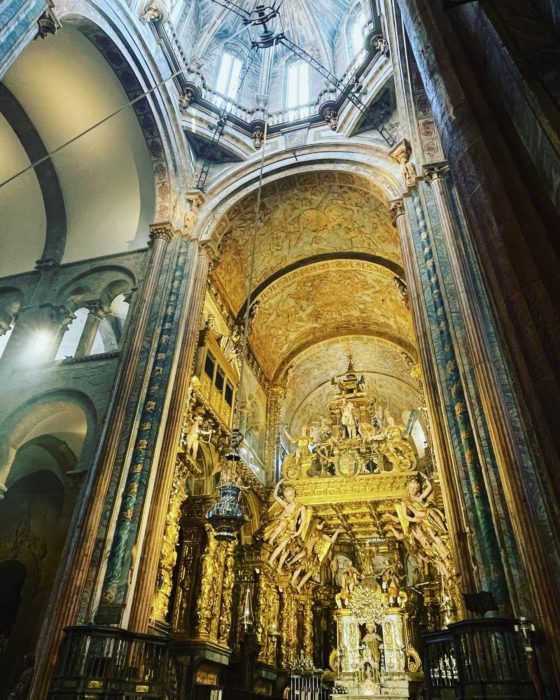 Cathedral of Santiago de Compostela Altar Photo by JFPenn
Cathedral of Santiago de Compostela Altar Photo by JFPenn
I found the Camino more of a physical journey than a spiritual one, partly because it was busy, so there was little time to walk alone and think as I did on the St Cuthbert’s Way. At the end of a day’s walk, it was about washing off the sweat and changing smelly clothes, attending to seeping blisters and spraying antiseptic on open wounds, resting swollen aching feet, finding food, and sleeping.
The needs of the physical self overwhelmed the spiritual, but then we are embodied souls. The physical is how we experience life, even an occasional glimpse of the divine.
(5) The Camino is an industry — and it always has been
The Camino de Santiago has waxed and waned in popularity and now several hundred thousand walk the different routes every year. It is not a wilderness walk unless you choose the early stages of the Via de la Plata, which are far less developed.
There will be people, sometimes lots of them, and there were moments on the Way where I was literally part of a long line of pilgrims. Many only walk the last 100km, which you need to complete to get the Compostela, so those last few days in particular are really busy.
The pilgrim industry starts with getting the Credential, which you can buy at many of the starting points and also online before you go. You have to get stamps along the Way from churches and hostels, hotels and restaurants, and inevitably, this results in queues even in out-of-the-way places. There are pilgrim menus at cafes, often very good value, and if you stay at albergues, there are even organized opportunities for socializing with other pilgrims.
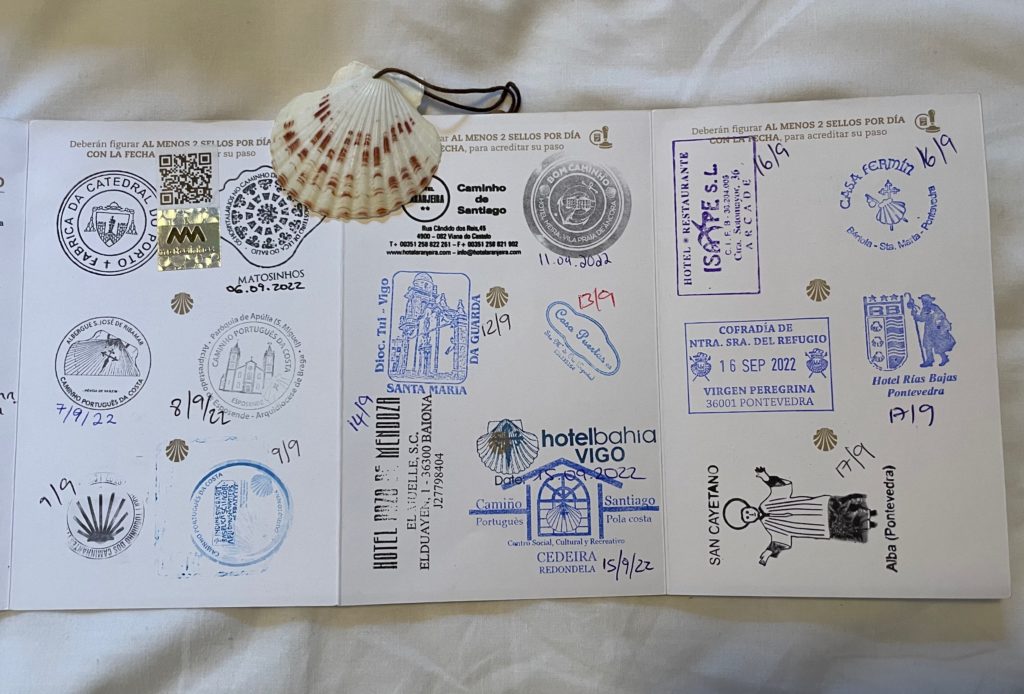 Pilgrim Credential with stamps, Photo by JFPenn
Pilgrim Credential with stamps, Photo by JFPenn
There are two possible attitudes to this industry. You can resent the intrusion of so many people and the overt commercialism, and pine for a solo, spiritual pilgrimage — or you can embrace it and join in wholeheartedly.
I did the latter and considered it part of supporting the local businesses that play an important part in the Camino experience. I appreciated comfortable accommodation, pharmacies, and supermarkets, as well as coffee shops, restaurants, and bars along the Way. However, I did stop in some sections to let waves of chattering pilgrims pass, and I relished moments of quiet walking when I didn’t see another person for a while, mainly when I left before sunrise a few mornings.
My favorite day’s walk was Baiona to Vigo, or at least the first 20km of it. The main Camino route went through the hills, but there was a slightly longer alternate route following the coast north. I chose the coastal route, which was barely way-marked, but by keeping the sea on my left, it was easy enough to navigate along paths and boardwalks.
I left Baiona in the dark and walked north as the dawn broke over the coastal wetlands. Wading birds picked their way through the shallows and finches darted between bushes on the shore. The path followed alongside almost deserted beaches. It was a cool autumnal weekday morning, so there were just a few dog walkers on the sand. There were heavy clouds overhead, and the wind blew rain in later that day. I saw a few pilgrims but mostly I walked alone, happy to have taken the alternative route, to step out of the stream of pilgrims even just for a day.
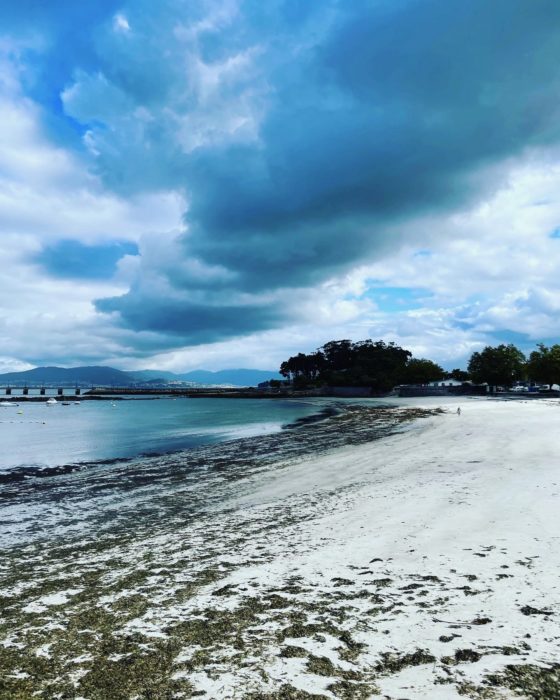 Clouds gathering over the beaches heading north to Vigo Photo by JFPenn
Clouds gathering over the beaches heading north to Vigo Photo by JFPenn
(6) Your Camino, your way
When people say they have “walked the Camino,” it can mean many things, and if you want to walk (or cycle), it’s important to consider what you want your Camino experience to be. We all have different definitions of challenge, and also different capabilities at different times in our lives.
There are various Camino routes you can choose depending on how much time you have and how far you want to walk. You have to walk 100 kilometers to be eligible for the Compostela, but the longest route, the Via de la Plata, is nearly 1000 kilometers. The Frances is nearly 800 kilometers and is the most popular and busy route, but there are also short routes like the Ingles if you have limited time, or you can do the final stage of the longer routes.
There are many companies who can organize and book accommodation for you, or you can walk independently and stay in hostels/albergues along the way. You can carry your own pack or get luggage transfer and carry a day pack. The time of year will also affect your experience, so you can see how the challenge can vary depending on these practical elements.
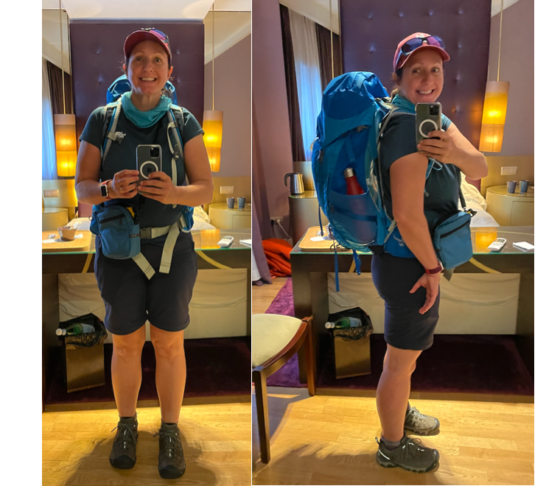 JFPenn with backpack for the Camino Portuguese Coastal route.
JFPenn with backpack for the Camino Portuguese Coastal route.
While I originally wanted to walk the Frances route, made famous by countless books and the film The Way, I couldn’t be away from my business for the time needed to complete it. I decided on the Portuguese Coastal route, still a challenge at 14 days of back-to-back walking, and considered much quieter than the Frances.
I carried my own pack and walked the whole route. I booked through Macs Adventure and had a private room each night in hotels or B&Bs. I like to know where I’m sleeping every night, and I didn’t want to deal with shared bathrooms and snoring.
Those were my choices, and they shaped my Camino. Many people, including pilgrims in their 70s, overtook me during the day carrying day packs, and certainly, getting luggage transferred is a good way to make walking easier.
Every pilgrim is different, and it is easy to end up comparing situations. You might pass a tired and limping pilgrim one day, only to end up like that yourself another day. You might wish your pack was lighter, or you might judge others for ‘only’ walking five days instead of a longer route, or you might judge yourself for not being fit enough, or for not looking after your feet and getting blisters, or for carrying too much stuff.
But no pilgrim is ‘better’ than another. We all have different reasons to walk, and different challenges along the Way. Keep your eyes on your own path.
Practical considerations and tips
In terms of training, I regularly walk 20km with a day pack and I also do weight training, so I have strong legs and no issues with my knees or back.
This was my third multi-day solo pilgrimage walk, but it was also much longer than anything I have done before. I knew I could do six days back-to-back walking in bad weather, but on reflection, 14 days was difficult, even though there were some shorter days in the middle. I should have scheduled a rest day and certainly recommend one if you are carrying your own gear for weeks at a time.
I’ve done plenty of long walks without getting blisters in the same walking shoes, but after one long, hot and sweaty day walking on rocky uneven ground, I started getting sore spots and they compounded into blisters over subsequent days. I ended up taping my feet and hobbling the last few days, but the many pharmacies along the way are used to pilgrims, and you’ll find painkillers and blister plasters front and center in them all.
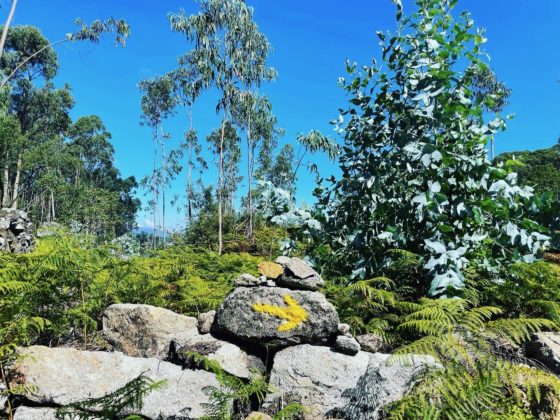 Camino arrow in eucalyptus forest on a hot day’s walking, Photo by JFPenn
Camino arrow in eucalyptus forest on a hot day’s walking, Photo by JFPenn
I’ve listed my gear in a separate article, and I was pleased with my Osprey Sirrus 36-litre backpack. I didn’t get any bruising on my hips and no back pain, so it wasn’t too heavy at around 8kg (plus water during the day). I made the mistake of a heavy pack on the St Cuthbert’s Way and paid the price! I was also grateful for my walking poles (LEKI Womens Micro Vario Carbon Trekking Poles), as the Portuguese route is rocky and uneven in places, plus they helped this tired and wobbly pilgrim keep going in difficult times!
During the day, I took pictures and wrote little notes in my phone, and then every morning, I woke early and wrote up the notes from the day before. If you want to reflect on your experience later, definitely keep notes and take photos as you walk. On a multi-day trip, the days blend together as the routine of pilgrimage shifts the passing of time in some strange way.
Schedule time before you leave to prepare, both practically and also to shift out of your busy normal life into ‘pilgrim time,’ which is a slower, more reflective pacer.
You’ll also need to schedule time when you return to ease back into things. Have at least a day in Santiago de Compostela to look around and attend mass, but also keep your schedule clear back home. I was exhausted and needed to rest the first few days, but also I found I couldn’t just jump back into busy work and meetings and noise. I needed some reflection time before ramping up to full speed. I’m writing this a month after returning, which has given me some space to reflect, and my blisters are all healed too.
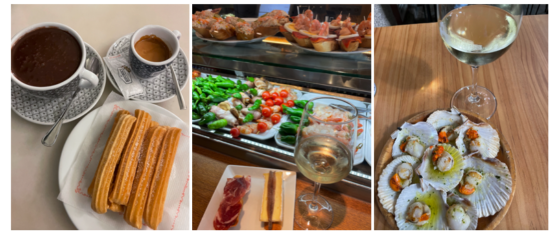 Eating well in Santiago de Compostela Photo by JFPenn
Eating well in Santiago de Compostela Photo by JFPenn
(7) I needed these last years of walking alone across a seasonal change in my life
I did my first solo multi-day pilgrimage, the Pilgrims’ Way in October 2020 between pandemic lockdowns, which I talked about in episode 50: This too shall pass.
I walked the St Cuthbert’s Way alone in October 2021 when I was still recovering from Covid, and I have walked alone for many days in training. I love my husband, Jonathan. He is my best friend and we walk together a lot — but I needed those times to walk alone.
The pandemic lockdowns made me feel like a bird bashing its wings against the bars of a cage as I talked about in my lessons from the Pilgrims’ Way. I walked myself into submission over that time and the pilgrimage helped calm my anger and frustration and grief at everything going on in the world and my inability to change it.
These last two years have also been a time of change physically and emotionally. I’m 47 as I record this and I’m still in the hormonal rollercoaster of midlife which has impacted my sleep and mental health and, compounded by the pandemic, has made the last few years pretty tough. I had terrible insomnia for most of it but am grateful that has now been fixed by HRT patches, which have been truly life-changing for me. HRT is not for everyone, but I recommend reading Menopausing by Davina McCall if you or anyone you love is struggling through this phase.
These long walks have given me so much during difficult times. I am goal-orientated and completing a pilgrimage route is a clear physical goal that you can tick off and feel a sense of accomplishment in finishing. I walked alone and proved to myself that I can do hard things, that I can walk through pain, that I can walk in all weathers, that I can deal with things going wrong and I can cope with my fears along the way. I have proved to myself that I am resilient and that has felt like an important thing to prove at this time of my life.
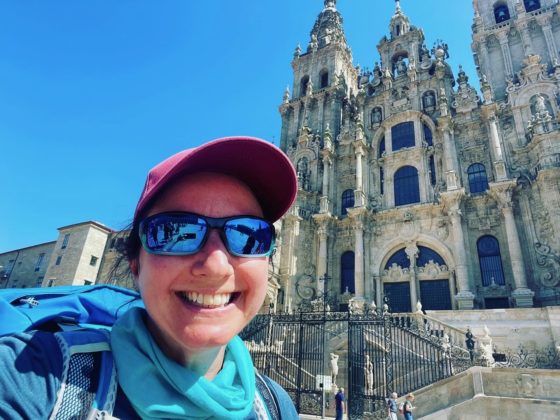 JFPenn arriving at cathedral of Santiago de Compostela 19 Sept 2022
JFPenn arriving at cathedral of Santiago de Compostela 19 Sept 2022
Many people walk pilgrimage at a time of change — out of a need to reset, or change jobs, or recover from grief, or find an answer to a question.
The Camino alone was not about changing my life and in fact, it made me realise how grateful I am for what I have in my creative business and happy marriage. But the three pilgrimage routes together over the last two years have certainly been a path of change through a rocky period in my life, and in the world in general. It feels like the end of one season and the beginning of another. Perhaps that’s just one of the gifts of middle age, but regardless, walking the Camino was the completion of a life goal and it closed one chapter so I can begin another.
You can find more reflections in my book, Pilgrimage, which combines aspects of the emotional and spiritual journey with practical tips which will hopefully help you if you are considering such a trip. You can find more details at jfpenn.com/pilgrimage.
I’d love to know what you think about this episode, or hear about your experiences from your own pilgrimage, or if you’d like to ask any questions, please leave a comment, or tweet me @thecreativepenn.
Buen Camino!
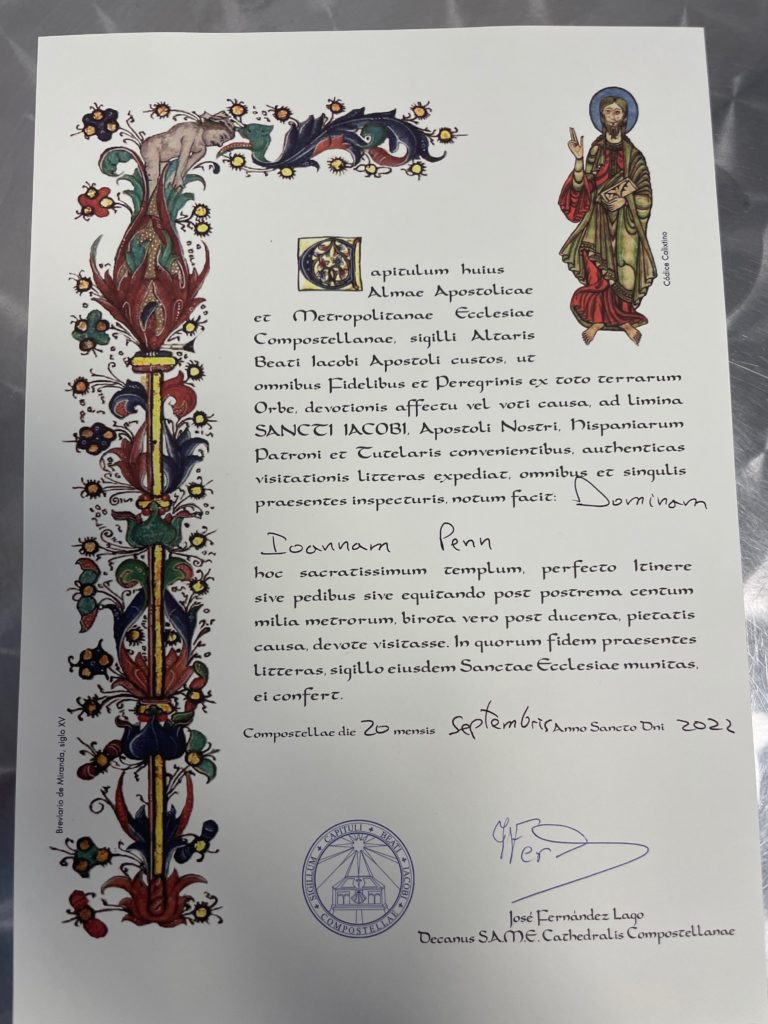 Compostela Joanna Penn, Sept 2022
Compostela Joanna Penn, Sept 2022
The post A Pilgrim In The Path Of History. Solo Walking The Camino De Santiago Portuguese Coastal Route With J.F. Penn appeared first on Books And Travel.
19 October 2022, 12:10 am - 34 minutes 45 secondsShaping The World In Profound And Unexpected Ways. Bolivia With Shafik Meghji
From the silver mines of empire to lithium mining under gigantic salt flats, Bolivia has played a significant part in history and is now shaping the future of green technology. Shafik Meghji talks about the diversity of the country from its landscape to its people and religious ceremonies, as well as recommended places to visit, and books to read.
Shafik Meghji is an award-winning travel writer, journalist, and author, specializing in Latin America and South Asia. He has co-authored more than 40 guidebooks. His latest book is Crossed Off the Map: Travels in Bolivia.
Show notes
- Bolivia’s geographical diversity and recommended places to visit, including the largest salt flats in the world
- The unexpected ways Bolivia has influenced and shaped the world
- Indigenous culture and architecture
- Festivals and other religious and cultural events, including the dance of the devils and the witches’ market
- Balancing the desire to travel with environmental responsibility
- Recommended books about Bolivia
You can find Shafik Meghji at ShafikMeghji.com
Transcript of the interview
Joanna: Shafik Meghji is an award winning travel writer, journalist, and author, specializing in Latin America and South Asia. He has co-authored more than 40 guidebooks. His latest book is Crossed Off the Map: Travels in Bolivia. Welcome, Shafik.
Shafik: Thanks, Jo. It’s a pleasure to be chatting to you. Looking forward to talking about all things Bolivia.
Joanna: Let’s start with the basics, just in case people don’t know.
Where is Bolivia? And what are some of its unique characteristics in terms of geography and climate?
Shafik: Partly, as the title of my book alludes to, a lot of people who aren’t familiar with South America or Bolivia specifically, would find it difficult to place. It’s essentially right in the heart of South America. It’s bounded by five different countries; Brazil, and Argentina, Peru, Paraguay, and Chile.
It’s incredibly geographically and climatically diverse, so it’s landlocked, but apart from the sea, it has the world’s largest salt flat, it has massive payotes due to the Lake Titicaca, which I’m sure lots of people have heard of.
It has some of the highest mountains on earth, of course, the Andes, it’s got part of the Panama Canal, which is the world’s largest tropical wetland, which he shares with Brazil, around a third of it lies within the Amazon basin. There are foothills and there are low-lands. There’s desert-like landscapes, this huge metropolis, like cities is incredibly diverse, and the climate ranges from absolutely freezing to sweltering. And you can sometimes experience both of those in the same day.
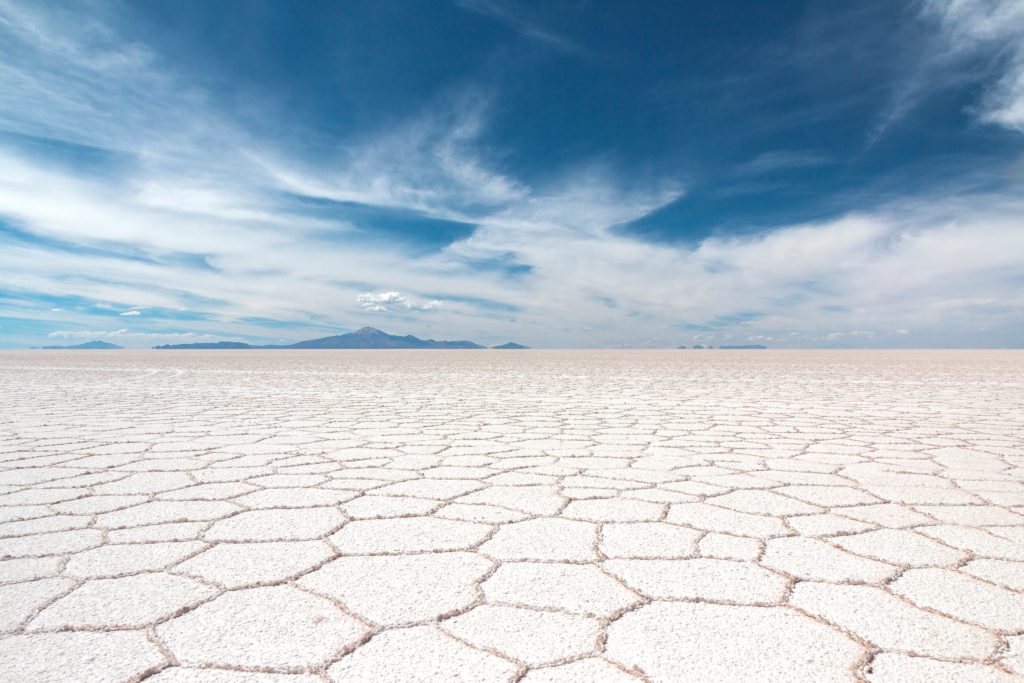 Uyuni Salt Flat, Bolivia. Photo by Samuel Scrimshaw on Unsplash
Uyuni Salt Flat, Bolivia. Photo by Samuel Scrimshaw on Unsplash
Joanna: How brilliant. We’re going to come back to some of these places.
How did you come to travel so much to Bolivia? And what’s your personal link there?
Shafik: I think like a lot of places and destinations that people come to love, it was really just by chance, it was a bit of an accident. I started off my career as a news desk sports journalist, and then slowly got fed up with that and resigned, and went backpacking around India, and then around South America.
I was really at that point, just in the highlights, I wanted to go to Rio for Carnival, and I had a wonderful time there.
Joanna: Of course.
Shafik: Of course, it’s impossible not to and really I only planned to spend a few weeks there and ended up spending a couple of months. But after that I’ve managed to drag myself away and I wanted to hike the Inca Trail to Machu Picchu, The Classic Gringo Trail stuff. But at the time I couldn’t afford to fly and the cheapest way was to travel overland from Brazil to Peru, through Bolivia. And so I planned to do that and didn’t really think too much about it.
I didn’t really know much about the country.
But as soon as I crossed the border, I got hooked, I ended up travelling to the Salar de Uyuni, an otherworldly landscape, the world’s largest salt flat. I visited the world’s richest silver mine, I traveled into the Amazon and explored the most biodiverse National Park on Earth. I went to some of the highest cities in the world, well over 4000 meters.
During that time, I really started to learn a bit more about the cultures, the peoples, the history, and I realized that this country that most people, including myself, before visiting would have had trouble placing on a map has actually influenced and helped even to shape the world in profound and unexpected ways. And that really led to kind of a lifelong love of the place.
So I later returned as a travel writer to co-author The Rough Guide to Bolivia. And that gave me a great excuse and an opportunity to visit virtually every part of the country. In doing so, I met so many fascinating people who were generous enough to share their stories. And I learned about the history of the country.
I learned about how, really, it feels like the future has arrived in Bolivia. It stands on the front line of so many touchstone issues, like climate, emergency, populism, and so on. And that all was brought together in my book Crossed Off the Map.
Joanna: I want to return something you said, that Bolivia has influenced and shaped the world in unexpected ways. I bet everyone’s listening is as surprised about that, because probably we don’t know.
What are some of the ways that Bolivia has shaped the world?
Shafik: I’ll tell you the story that really first gave me an insight into this aspect of Bolivia’s history, and it was a visit to a place called Potosi, which today most people outside the country don’t really know too much about it, may not have heard of it before.
Potosi is the second highest city on Earth. It’s high up in the Altiplano, which is a high plane between two branches of the Andes. It’s a city and above it, well, is a mountain called Cerro Rico and that was home about 500 years ago to the richest silver mine in history.
During the Spanish colonial period, so much silver was pulled out of these mines that they said that according to legend you could build a solid over railway track all the way from Bolivia to Madrid, and still have enough leftover for a solid silver engine divide on top.
This silver changed the world. It connected up Europe, and Latin America, and Africa, and Asia, together for the first time. The silver was shipped to Europe, which helped to fund the Industrial Revolution, and various wars and conflicts. It traveled over to Asia to Manila on these huge galleons. And there, it was traded for Chinese-made goods.
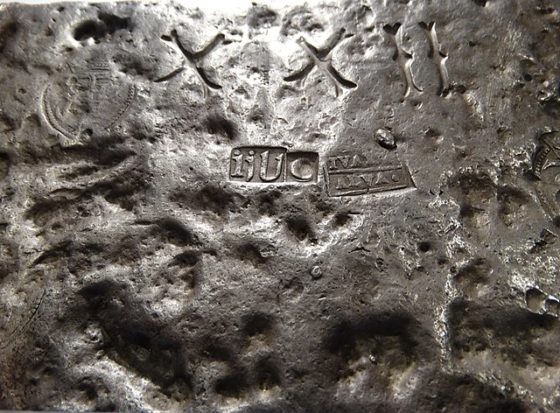 Detail of 16-Pound Silver Bar, probably from Mines of Potosi – 16th Century. Adam Jones from Kelowna, BC, Canada, CC BY-SA 2.0 via Wikimedia Commons
Detail of 16-Pound Silver Bar, probably from Mines of Potosi – 16th Century. Adam Jones from Kelowna, BC, Canada, CC BY-SA 2.0 via Wikimedia Commons
The silver from Potosi helped to fund the Great Wall of China, for example. And it also played a role in destabilizing various dynasties.
It became such a significant place for hundreds of years.
And it became synonymous with great wealth in ‘Don Quixote,’ there’s a phrase ‘worth a potosi,’ which means worth a fortune, which would have been commonly understood at that time, now is obviously drifted out. It’s also the source of that quirky things such as ‘pieces of eight’. This pirate phrase is actually based on some of the silver currency that came out of Potosi.
When I visited, I didn’t know anything about this. But I ended up going into these mines, which are centuries old, now they call them rat runs, they’re very claustrophobic and simultaneously thousands of meters above sea level, and hundreds of meters underground, and you’re crawling on your stomach. And then there’s all these poisonous dusts around.
There was arsenic dust everywhere when I visited. It’s a very unsettling place. And you see the miners who still work there now the silver has largely long gone. But many miners still work there hoping to strike it rich in very, very difficult conditions. It’s incredibly intense experience.
That started to give me an idea and an interest in the history. And then the more I read, and the more I learned, and the more I spoke to people in the city, I realized what an influence of this city, once on of the richest and biggest on Earth, but now forgotten, that had on the rest of the world.
It’s stories like that, that helped to spur me to write the book, because I thought these are just fantastic stories. And they deserve to be better known beyond Bolivia’s borders.
Joanna: Wow, that is so interesting. When you look into history, and you realize how far things travel, it’s incredible. What you’re talking about there is essentially pillaged out of Bolivia and taken across the world. I wonder how much of our silver that we look at here even in England is from there. I presume it doesn’t have a mark.
Once things are made into things we wouldn’t know, would we, how far the silver has gone?
Shafik: Absolutely. People listening to this podcast will have silver, they got old heirlooms, family heirlooms perhaps, or things that are made a few 100 years ago, they may well have something made from Potosi silver.
And I should say at this point that, of course, all of this wealth came at a great cost. It was borne by the indigenous peoples of the Andes.
And it was also born by enslaved Africans who were trafficked over to labor in the mines, and in the smelting plants and so on. But definitely Potosi silver, people will have seen it, and some people may have it in their possession without knowing it.
One other side kind of quirky thing from that is that the dollar sign one of the most recognizable symbols today, the origin of that also kind of drifts back to Potosi. Potosi’s initials, used to be stamped on the silver coins that were made in the Royal Mint, which is now a fascinating Museum in Potosi. And they were shipped around the world. The PTSI over one another vaguely resembles the dollar sign. And that was how that particular symbol developed.
Joanna: Wow. That’s so interesting. Coming back to the indigenous people, because the history of the world is a history of conquest. But there are I think, based on looking at your book, there are still aspects that the indigenous people still play a part in the culture.
What aspects of Bolivia now are based around the indigenous people?
Shafik: Well, this is one of the aspects of Bolivian society that really fascinates me and also, I think, is really of interest to the increasing numbers of travelers and tourists that make it out there.
Huge numbers of Bolivians have indigenous heritage. And there’s an incredible range of indigenous cultural groups across the country with often very different beliefs, and practices, and cultural makeups, and so on. And really, over the last 20 years or so, often many centuries of repression and violence and so on.
Some of those things are starting to be collected in Bolivia. Bolivia, about 20 years ago had the first indigenous president in South American history Juan Evo Morales. And although his legacy is mixed, shall we say, one of the things that it led to was a real flourishing of indigenous identity, and pride, and representation.
If you travel in Bolivia today, or any part of Bolivia, from the hot and sweaty east and low-lands, all the way up into the Amazon or to the high-altitude cities of the Andes, you will see indigenous culture thriving in a way that you may not see in many neighboring countries such as Chile, or Argentina, or Brazil.
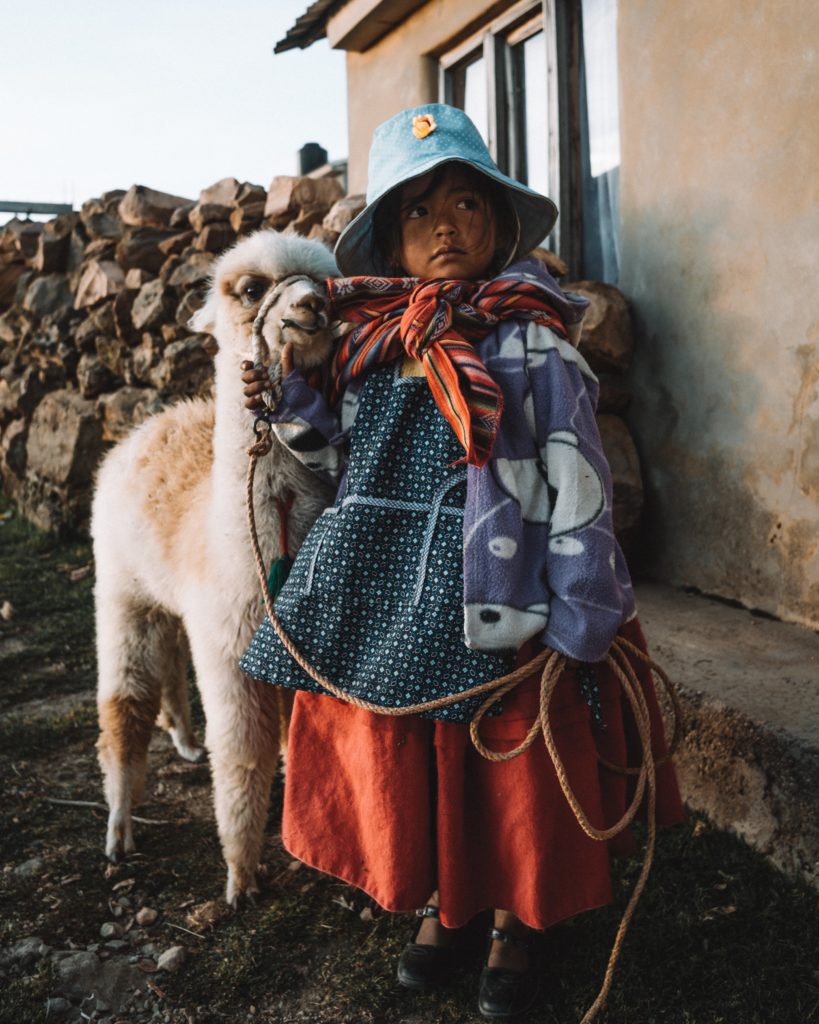 Bolivian girl with baby Llama in Isla del sol, Bolivia. Photo by Alex Azabache on Unsplash
Bolivian girl with baby Llama in Isla del sol, Bolivia. Photo by Alex Azabache on Unsplash
And of course, these indigenous cultures are fused with European influences. And also African influences, as I mentioned, huge numbers of enslaved Africans were trafficked to Bolivia, and elsewhere in South America, of course, during the colonial period. All of these are fused together.
I’m sure we’ll talk about some of the festivals and celebrations later in this talk, but you really see some of those, this fusion of ideas and this blend and this mixture of influences coming together in events like that.
Joanna: Tell us about these now. And you’ve mentioned that wherever you travel, you can find this.
Are there specific places that people can go to and attend one of these festivals or places where the architecture might be resonant?
Shafik: Absolutely. It’s always better to be specific with these kinds of things. I’ll pick a couple in terms of festivals and religious celebrations.
Carnival in Bolivia, and carnival’s celebrated across Bolivia. But the most famous one is in a city called Oruro, which is an old tin mining city in the Andean region, and it can be a kind of melancholy place for much of the year. But during Carnival, late February, early March, it becomes a riot of activity.
As I mentioned the celebrations blend indigenous African and European influences, their parades and street parties. The highlight is the Diablada, which is the dance of the devils. And essentially, that’s a snaking procession of dancers in devilish masks, clanging brass bands coming up behind them, and there is figures representing Lucifer and Archangel Michael, everyone’s in absolutely outlandish costumes.
Despite the Christian veneer behind things, you really see the indigenous origins of the beliefs coming to the fore. Lucifer, as is often said, to represent the Andean god of the underworld.
You can go along and as people might expect from carnivals around the world, there’s copious eating, and drinking, and dancing, and merrymaking, and so on. But the Oruro Carnival is an absolutely fascinating thing to really experience.
There’s lots of historic architecture. There are ruins dating back to pre-Inca civilizations, there’s lots and lots of Spanish colonial architecture in cities like Sucre.
But the architecture I’m often most interested in, is in a place called El Alto.
Now El Alto is not too familiar for people outside of South America is the highest city on Earth. It’s just above La Paz, which is the de facto capital. And it’s really it’s developed, it’s one of the fastest growing cities in South America. It’s developed massively over the last 40 years or so. Huge numbers of indigenous migration, predominantly people from the Aymara and indigenous group who have fled droughts and it’s often caused by the climate crisis, which is having a huge impact in the Andes, but also economic crises and political crises and so on.
They flocked to this city and it’s become a real hotbed of Aymara culture and identity. And one of the ways that you see this expressed is in the architecture, and over the last couple of decades, something called cholets have developed. These are multipurpose, incredibly colorful, bright buildings that double up as shops as entertainment spaces for weddings or birthday parties, and so on, which play a big role in Aymara culture, and there’s often some housing as well, and including for the owner, often a chalet, which is part of the portmanteau word.
But the look of these buildings is incredibly eye-catching. You’ll have some that resemble characters for Marvel movies, you’ll have some that represent…there’s one that has been designed to look like Optimus Prime, a character from transformers. They have Technicolor, lots of glass and mirrors and all manner of colors, and they blend both kind of modern touches with indigenous Andean symbols. It’s a real clash of influences.
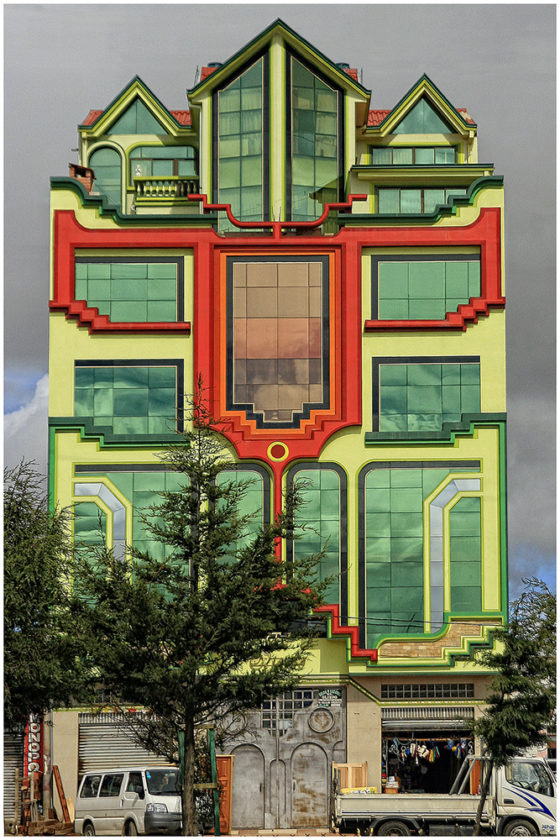 A cholet in El Alto, Bolivia Photo by Tasmita Gz Wikimedia CC
A cholet in El Alto, Bolivia Photo by Tasmita Gz Wikimedia CC
The last time I visited, I had a wonderful guide, and she described it as firecracker architecture. I certainly can’t do any better than that. But I really advise the audience to stick it into Google after you’ve listened to this and have a look, because they’re absolutely fascinating but also they’ve got a great story behind them, too.
Joanna: That’s great. I always like to find pictures for the show notes. So hopefully I’ll have some, if people want to go look at the show notes. But I want to come back, lots of things to come back on.
You mentioned this thin Christian veneer. I like that phrase a lot. When I was having a look at your book and about a cities that it seems that death culture and occult things are more common.
You mentioned the devil dancing, but La Paz has this unusual cemetery and there’s a witch market.
Tell us what is underneath this thin Christian veneer that you mentioned?
Shafik: It’s something that if you visit a city like La Paz, it’ll immediately become obvious to you just as you wander the streets.
Let’s start off with the cemetery. It’s the Cementerio General, the general cemetery, the biggest in La Paz. But essentially, it’s a mini city, I think it’s roughly about 1.5 square miles. So huge really, kind of dates back to the early 1800s. And they’re really compact, too. So they’re all stacked on top of each other, almost like shelves, and space is of an essence.
La Paz is in a valley high up in the mountains, very, very steep sides. But the buildings are absolutely crammed in there, there’s not a lot of space. So that’s reflected in something like the cemetery. I believe that remains had to be cremated after about 10 years and moved to a smaller space. So you’re often only temporarily in a slot in the cemetery. But if you walk round, it feels like you’re in a mini-city of the dead within the larger city of La Paz.
Actually, just to go very briefly off tangent, you’ll find this similar things in other South American cities, even in places like Buenos Aires, the famous Recoleta cemetery, huge, huge places, and they’re right in the middle of the cities. They’re more of an urban field than often our graveyards and cemeteries are, say in the UK.
But often when I’m traveling to research articles, or to collect books, I always pay a visit to the cemetery because I think they offer an incredible insight into the history, the place just the names, the causes of death and that kind of thing. It offers an insight into the culture and the history.
Something that’s much more on the tourist trail than that though, is the Witches’ Market, which is in the heart of the tourist, their backpacker area. And essentially, although it’s called the Witches’ Market, that’s actually a kind of a Spanish colonial term is women, predominantly indigenous women known locally as chifleras.
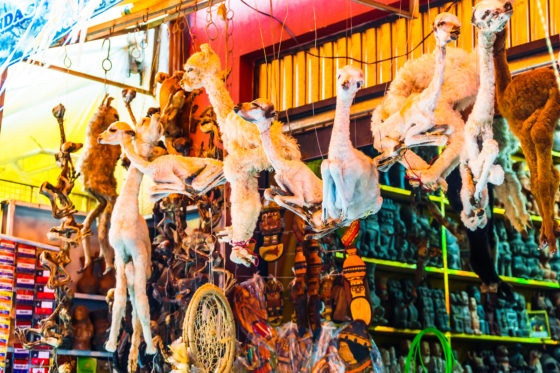 Witchcraft market, La Paz, Bolivia. Photo licensed from BigStockPhoto
Witchcraft market, La Paz, Bolivia. Photo licensed from BigStockPhoto
It’s a cross between a healer, a counselor, a doctor, a medicine woman, it doesn’t have the kind of the pejorative sense the witch is often used that for in an English language point of view. But their stalls are absolutely incredible to look around. Often they have all manner of amulets and potions and the thing that really strikes newcomers the most are the llama fetuses which are dried…
Joanna: Oh.
Shafik: …and, yeah, and hung up above the door. And you often have to duck under them to get into these tiny shops. And they’re really like almost as big as a broom cupboard is that kind of thing.
The Ilama fetuses feature very heavily in traditional central Andean traditions. For example, if you’re buying a new house, or you’re building a new house, you will often bury Ilama fetus beneath the surface, beneath the foundations, and that’s supposed to bring you luck.
Joanna: It’s like a rabbit’s foot here in the UK. People carry a rabbit’s foot for luck. We don’t now, but it’s one of these lucky charm type things.
Shafik: Exactly. And actually, it’s a really good example to bring up because often if you’re coming from UK, you come from Europe, this seems crazy and outlandish and ‘very exotic.’ But, actually, when you interrogate some of our own beliefs, often actually there are similarities with them.
I should say the llama fetuses are stillbirth, they’re stillborn. So that’s how they come about. Across the Andean part of Bolivia, you’ll see llamas and alpacas play a huge part in the culture both as food, and transport, and for cultural reasons.
The so called Witches’ Market rather, offers a fascinating insight into these beliefs which live in beliefs, really. And particularly if you speak some Spanish, then you can have a chat with some of the chiflera, who normally if you buy something, will be happy to talk.
Joanna: You mentioned that this so called Witches’ Market is in the tourist area, and you said earlier about The Gringo Trail and this backpacker route and it comes down to one of the difficulties that I think you do tackle in your book, which is that yes, we want to travel. We are people who like to travel. But there’s also the climate crisis that you mentioned. Are we changing culture through backpacking and all of this?
How can we balance this as people who want to travel but also want to be more responsible?
Shafik: I think this is a key question for really for travel writers, but all of us who travel and go on holiday at the moment. First of all, if you’re in the UK, you’ve got to fly to Bolivia, which obviously has a huge carbon imprint. Putting that to one side, there are lots of ways that while you’re there, that you can actually have a positive impact on local communities, and particularly local communities that are bearing the brunt of the climate crisis.
There are lots of really good community-run and indigenous-run tourism agencies. And also lodges give you a really good practical example, there’s a logical Chalalan, which is Parque Nacional Madidi Amazon, is run by an indigenous community. And it’s helped to both empower that community and also help to preserve some of the most biodiverse rainforest on Earth.
So I think if you’re there, there’s ways to have a positive impact. Obviously, try and avoid internal flights, as tempting as that can be. But also be aware that the way you spend your money, you’re obviously having an impact on the local cultures, as well.
The Witches’ Market, which obviously we’re just talking about, is aimed at local people, originally, but it has become more touristy in recent years. And you can generally see that some aspects of it are played up. It’s a difficult balancing act, because also tourists spending money is a key source of income for these people as well.
So I think, definitely look for independent places to stay in, look for locally and, ideally, indigenous-ran tourism organizations to go with travel agencies, and really try and minimize your carbon impact once you’re there, which is taking public transport, avoiding flights.
And also, if you visit reserves, not just in the Amazon, but also places like the Salar de Uyuni, which is the world’s largest salt flat, the tourism gives local people an economic incentive to help conserve these often very threatened ecosystems. So it’s a thorny issue, that there’s not easy answers to it. But there are certainly ways to minimize the negative impact you have, and in certain areas have a positive impact when you visit.
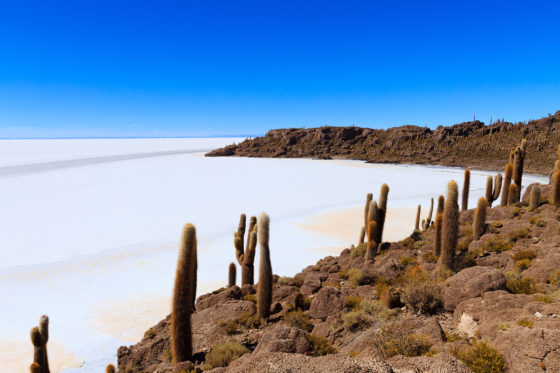 Salar De Uyuni View From Isla Incahuasi, Photo licensed from BigStockPhoto
Salar De Uyuni View From Isla Incahuasi, Photo licensed from BigStockPhoto
Joanna: You’ve mentioned this salt flat several times. And part of me is like, “Okay, that sounds great.” And then part of me just has this view in my mind that, “I would never want to visit a salt flat.”
What is it about this salt flat that makes it so amazing?
Shafik: On the surface, it doesn’t sound super appealing. But if you imagine an incredibly flat blindingly white, the brightest place I’ve ever been, expanse, surrounded by volcanoes, and mountains, and dotted with these islands of giant cacti. It’s a really otherworldly landscape. And I just said it’s the biggest in the world is roughly the size of Jamaica. That’s how big this salt flat is.
This is only one of several salt flats in southwestern Bolivia. But you can explore on detours and the surface of the salt flat, are covered by…they look like giant fish scales, kind of hexagonal shapes. And you can play lots of tricks with perspective, while you’re there. It’s a hallucinatory landscape. It really is. It feels like stepping onto another planet.
And there’s a nearby reserve as well, which is even higher altitude. And there they’ve got mineral stained lakes. So there’s a green lake. There’s a red lake as well, dotted with flamingos. There’s this surreal stones that have been sculpted by the very high winds there. There’s areas that look like lunar landscapes.
Salt flat really doesn’t do this area justice, the Salar de Uyuni and the neighboring Eduardo Alvaroa Reserve, are really almost as close as you can get to stepping onto another planet as you can on Earth.
Joanna: Yeah, that’s kind of crazy. Is that the place where they did some of these fastest cars racing across the what looks like a desert? Is that on the salt flats or is that in America? I’m trying to remember.
Shafik: The time trials, I think, they do on salt flats in the U.S., but they do very much have in the Salar de Uyuni as well. In fact, the Paris Dakar Rally, which confusingly now is often over in South America has been held on the salt flats in the past, and in fact, there’s other sporting events as well. There’s an ultramarathon that goes across it as well, which is challenging to put it mildly because you’re 3600 meters above sea level.
The altitude is really testing. And it’s an incredibly remote area yet is linked by train or a town on the edge is linked by train from some of the bigger cities, but you just have to travel across by Toyota Land Cruisers. You often have this landscape to yourself.
This is dotted with small communities that rely on salt trading, which has been an industry in this area for millennia. Quinoa farmers, llama herders. But, yeah, it’s a fascinating place to visit.
Also it has more modern challenges. It’s a big area for smuggling, both for cars and for drugs, because it’s very close to the Chilean border. And the terrain is very, very difficult to manage. So an awful lot of cars and drugs crisscross over the border.
Also interestingly, this is another area where Bolivia will help to shape or certainly will impact the wider world over the years to come.
Beneath the surface of the salt flat, and the surface of the salt, there’s kind of like a briny fluid, which is very rich in lithium.
Lithium is the lightest metal on earth. The fact that we’re able to do this recording is thanks to the lithium battery in our laptops.
Lithium is essential for electric vehicles. It’s used in solar panels. It’s an absolutely vital material, or metal, for our transition to a hopefully fairly soon to a lower carbon global economy. According to some estimates, roughly 50% of the world’s lithium supplies lie in, what’s called The Lithium Triangle, which is in this part of Bolivia, and also in neighboring Argentina, and Chile.
At the moment, if you’re traveling for so long with all these natural wonders, and these things like salt traders, which seem to have been around forever, you will also find these grids of tennis court-sized pools of turquoise water or turquoise liquid. These are the fledgling lithium programs with the brine being pumped up.
And funnily enough, recently, I think over the last couple of months, Bolivia has actually started to produce its first electric cars within the country as well, taking advantage of its lithium reserves. So all in all, the Salar de Uyuni is an incredibly diverse, it’s an interesting place to explore, particularly at the moment.
Joanna: I used to work for a mining company in Australia, and you see the landscape quite dramatically changed when mining wealth is found. So I can imagine that that will change quite a lot over the coming years. So that’s really interesting.
A quick question before we talk about books. You’ve mentioned the altitude a number of times and I do know someone who came to Bolivia and got sick with altitude sickness.
Is that a problem with altitude and any recommendations for the altitude-related issues?
Shafik: Yes, it’s absolutely something to be aware of. If you’re visiting the Western Andean side of Bolivia, most of it is very high attitude. So if you’re flying to La Paz, you’re flying to the world’s highest international airport, which is well over 4000 meters. If you’ve got the time, the best way to avoid it is to fly into sea level, you’re as close as you can at sea level to another city, and then slowly make your way up, pausing every 500 or 1000 meters. So you adapt.
However, that’s not a luxury that everyone has. So if you do fly into La Paz, really take it easy for the first few days until you’ve started to acclimatized. Get lots of sleep, drink lots of water, avoid alcohol, and definitely don’t overdo it.
Even when you adapt, you’ll still feel tired, you’ll get exhausted quickly. I always think of it as a bit of an insight into the aging process kind of speeded up, because even just climbing a flight of stairs will feel like scaling Everest.
Definitely take it easy, but be aware of these symptoms as well. And unless you’ve got a serious attack of it, in which you should go to hospital, the best approach is to descend. Even within La Paz, there’s various park places either in the city or nearby that are lower altitude. So if you’re struggling, descend.
Joanna: Yeah, good tip. So we’re always out of time. And this is the Books and Travel podcast.
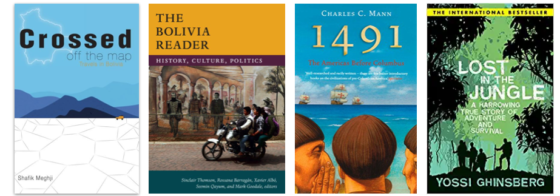
What are some of your recommended books about or set in Bolivia?
Shafik: One of the things, it’s a real shame the very few Bolivian authors are translated into English and beyond academic books, very few English language authors write about the country which is one of the reasons that I wrote Crossed Off the Map to help fill this in, but there are definitely a few other books that I would recommend.
The first one is The Bolivia Reader, which is Duke University Press, and it’s got several editors. It features an incredible range of extracts of writing about Bolivia, mainly from Bolivian authors. You have pieces by the former President Evo Morales, who was the first indigenous president in South America, but also by people like Che Guevara, who died in Bolivia. And also conquistadores like Pedro Cieza de León, who provides one of the earliest written accounts of Bolivia. So the book ranges from ancient stories and poetries, and legends, to fiction, and contemporary journalism. As I say, I particularly found it useful and interesting to read the early accounts from the 16th century.
One of the other books I’d recommend is 1491: The Americas Before Columbus, by Charles C. Mann, and that examines the indigenous societies across the Americas, including in what is now Bolivia, prior to the arrival of the Europeans. It was particularly interesting on the ancient cultures of the Llanos de Moxos, which is a part of the Bolivian Amazon. These ancient societies built thousands and thousands, tens of thousands of earthworks structures, including even pyramids in some of the most challenging environments imaginable. It’s an incredibly insightful book. And actually, it was a huge inspiration for Crossed Off the Map.
Also in the Bolivian Amazon, which is the reason that is often overlooked, so I always like to emphasize it is a book called Lost in the Jungle by a guy called Yossi Ghinsberg. People might be familiar with it because he was turned into a film a few years ago called ‘Jungle,’ with Daniel Radcliffe. It’s an adventurous tale of survival in the Bolivian Amazon.
Essentially, Yossi Ginsburg was a Israeli backpacker who went off on a expedition into the rainforest inevitably goes wrong, and he ends up lost and alone. But he survived. He went to great odds, despite being menaced by wild animals, not having any food, and so on. He was eventually rescued by indigenous communities, and wrote a very interesting and exciting book about it.
There’s also a coda to that book because it really helped to encourage interest in the Bolivian Amazon amongst backpackers. Initially, Israeli backpackers, but then, backpackers from the UK, Europe, and beyond. And it helped to turn a place called Rurrenabaque into a hub of eco-tourism. So it’s had an interest in afterlife, as well. But I think those three books will give you a bit of an insight into Bolivia’s history, and also its contemporary life.
Joanna: Brilliant. Where can people find you and your books online?
Shafik: Right, if you can spell up my name, I’m easy to find. It’s shafikmeghji.com. And then that’s the same for my twitter and Instagram handles and Crossed Off the Map: Travels in Bolivia is available from all good bookshops.
Joanna: Brilliant. Well, thanks so much for your time, Shafik. That was great.
Shafik: Oh, my absolute pleasure, Jo. Thanks for having me on.
The post Shaping The World In Profound And Unexpected Ways. Bolivia With Shafik Meghji appeared first on Books And Travel.
6 October 2022, 12:10 am - 46 minutes 37 secondsSacred Steps. Pilgrimage With Kevin Donahue
How is pilgrimage different from just a long walk? Why do we feel a calling to pilgrimage even when not religious? How does pilgrimage connect us to our physicality, and simplify life so we find some perspective? Kevin Donahue talks about some of his ‘sacred steps’ on various pilgrimage routes across Europe.
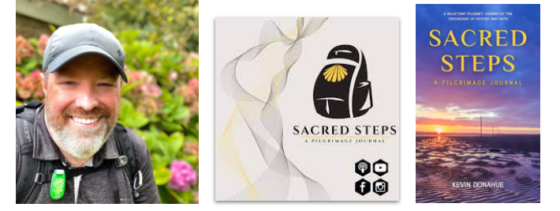
Kevin Donahue began walking pilgrimage routes in 2019 and hosts the ‘Sacred Steps Podcast,’ where he discusses pilgrimage with fellow pilgrims. He’s currently writing a book, Sacred Steps: A Pilgrim’s Journal, out in 2023.
Show notes
- How is pilgrimage different from a long walk?
- Why pilgrimage resonates even to those who are not religious
- Highlights of Kevin’s pilgrimage, including the crossing to Holy Island, Lindisfarne
- The challenges of pilgrimage — and the gifts that only emerge later
- Tips for the Camino Portuguese route — wear shoes with thicker soles for the cobblestones!
- Recommended books on pilgrimage
You can find Kevin Donahue at SacredStepsPodcast.com and on Instagram @kevincdonahue
You can listen to my interview on Kevin’s podcast about my pilgrimage to Canterbury here.
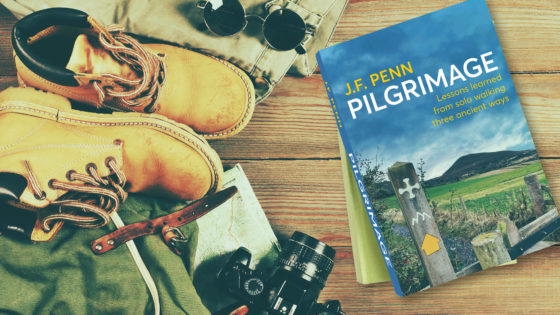 My book, Pilgrimage, Lessons Learned from Solo Walking Three Ancient Ways, is out now
My book, Pilgrimage, Lessons Learned from Solo Walking Three Ancient Ways, is out now
Transcript of the interview
Jo: Kevin Donahue began walking pilgrimage routes in 2019, and hosts the Sacred Steps Podcast, where he discusses pilgrimage with fellow pilgrims. He’s currently writing a book, Sacred Steps: A Pilgrim’s Journal, out in 2023. Welcome, Kevin.
Kevin: Thanks, Jo. It’s great to be on. I appreciate getting a chance to talk with you today.
Jo: I’ve been on your show discussing my pilgrimage and you talk about pilgrimage a lot. And so, this is fascinating, but let’s start with a definition.
What is pilgrimage? How is it different from a long walk?
Kevin: That’s a great question, Jo, and I think this is something that’s really a bit intimidating for people when they hear the word ‘pilgrimage.’
I didn’t really know what that meant to me as a walker at first. I went to the Webster’s children’s dictionary, because, for me, if Webster could explain it to a child, surely that could be something I would understand. And the dictionary said, look at pilgrimage and then look at pilgrim, a person who travels to a holy place as an act of religious devotion.
That made a lot of sense to me. Because when you think about devotion, that gets into intention and purpose. And if you’re walking with this intent, versus a long walk, which you and I have both actually done a lot of, Jo, but pilgrimage is as much about the journey as it is the destination.
I think it’s those moments of greater awareness, either about ourselves or, to some degree, maybe our faith or our world, or how we interact and engage with the world around us, that really makes pilgrimage so rewarding. And it’s that spirit of each step of the journey having significance, rather than just the beginning or the end. It’s the full process, I think, that makes pilgrimage much different than just a long walk.
Jo: That’s really interesting. We’ll come back to some of those aspects, but I noticed that you call yourself a ‘reluctant pilgrim’ on your website.
Where does this reluctance come from, and what happened in your life to get you over that?
Kevin: I’ve had the opportunity in the United States to do some of our national scenic trails, and we have some great ones. I’ve walked along the Appalachian Trail, haven’t finished the whole thing just yet, the Florida National Scenic Trail. I’ve walked out in the western United States. And like you said, those are long walks.
I had always wanted to do the Camino de Santiago in Spain. And I made the decision, but as it grew closer, I really didn’t understand the concept of pilgrimage and how it related to me. So, I jokingly said I was a very reluctant pilgrim, because I didn’t set out to be a pilgrim or to go on pilgrimage. I wanted to have this bucket list experience, this life-affirming socialization, walking in the footsteps of history, where people had trod for a thousand-plus years. And that seemed really like a great, great walk for me.
It’s those other elements that intervened throughout the process that really reconnected me in some ways to my faith, because I was, I think what we would call ‘lapsed but listening,’ where you can be someone who maybe follows Christ as a Christian, but not necessarily follows the orthodoxy and teachings maybe of a Christian church or denomination.
Being on that walk and going through some of the places that I got to experience, which, I think that’s the great part about pilgrimage, you come and engage with these different places and people, that really, I think you said, what was it that sparked? I think for me, that’s what maybe pushed me over the edge a little bit and changed my long walk into a pilgrimage. And I think it’s something that happens for each person very individually, and perhaps quite a bit differently.
Jo: It’s interesting because as we talked about before, I’m not a Christian, but I would say I’m a seeker and I find moments of connection with the divine, I suppose, or the universe. But I definitely do not follow a Christian religion, or any particular religion.
It’s interesting because you started off by defining a sort of traveling to a holy place as an act of religious devotion, and that pilgrimage is going to these holy places.
And I always feel like even if we don’t adhere to a particular religion, there’s something about pilgrimage that touches a part of every person’s soul, if they have any form of kind of spiritual seeking. And so, it’s not just that it has to be a Christian faith or any kind of, because the pilgrimage is obviously in every religion.
What do you think about pilgrimage transcending religion in a way?
Kevin: Oh, you are spot on, Jo. There’s a great organization in the UK, the British Pilgrimage Trust, and their mantra is that they want to enliven pilgrimage for people of all faiths and none. I think that’s such a powerful mission statement. Because it speaks to so much of what these special places have meant in our lives collectively, for centuries and millennia.
We look across the UK and there are these sacred places that we know had such great value to our ancestors. One of the obvious ones that stands out for U.S. tourists is Stonehenge. Or up the road in Avebury, Woodhenge. And you say to yourself, ‘I’m standing in a place where people have journeyed here for centuries.’
And, to your point, that’s obviously not a Christian church. There’s no cross and steeple. But clearly, people have held that space in high regard. And it might have been something where people had journeyed from a great distance to come to be in this space.
I think we can all recognize that there are these places where we feel a greater sense of purpose or a greater sense of connectivity, whether that’s with something spiritual, or whether it’s with our own self-identity and feeling of self-worth.
I think pilgrimage does mean something different to everyone, but I think it has meaning to everyone. And, again, I think that’s a bit about what separates pilgrimage from a long journey is that it’s the process of making that trip that has significance to the person that’s undertaking it.
Jo: Absolutely. And that resonance with faith in whatever over the generations, and a resonance with that emotional connection and people of faith in a particular place, I almost feel leave an imprint that, and that’s almost what we feel. You can feel that it’s God touching you, and it may be that, but you can also feel that it’s connection to people across millennia.
I remember being at Stonehenge once, and there weren’t many people there. It was winter. It was freezing cold, and there was a murmuration of swallows or swifts or the murmuration when the birds flock in shapes above Stonehenge. And I was standing there going, ‘This has to be some kind of divine experience.’ It was a crazy kind of experience, and feeling like I was connecting to this sort of deep Earth power, whatever it was.
Like you say, there are places where we feel that connection with people across time, I suppose.
Kevin: We’ve talked about that a little bit on my podcast, the ‘Sacred Steps Podcast.’ My guests are not formally Christians. I’ve had the opportunity to talk to people of no faith, and people who are Buddhist and people who are Muslim. These journeys have great weight and significance for people.
You can go into a space, and it might be a church. We’ve talked about, Jo, you love the architecture and the devotion that people have made into creating these spaces, and the beauty that resonates with them.
And you can be in a space that man has made, a church or what have you, and you can feel a significance that is not necessarily tied to a particular orthodoxy.
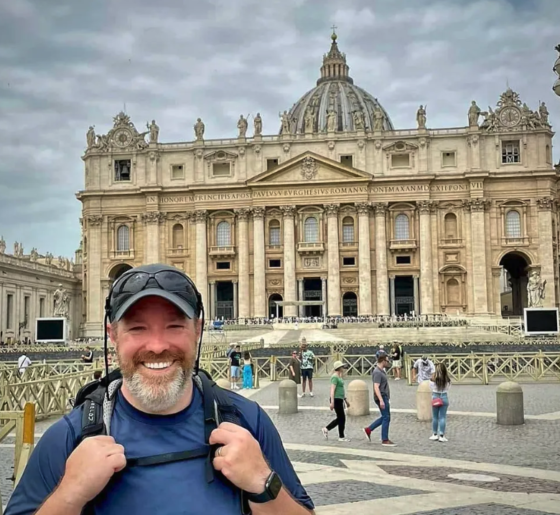 Pilgrim Kevin Donahue at St Peters Basilica Rome Photo by Kevin Donahue
Pilgrim Kevin Donahue at St Peters Basilica Rome Photo by Kevin Donahue
I think whether you’re going to these ancient sites, whether you’re journeying to…and there are a lot of places where our different faith practices hold in high regard. Their wells and their caves and their springs, but natural places that you find out in the landscape. Also, these sometimes grand shrines that man has made in practice of faith. Being in these spaces, to your point, you sometimes feel like that’s a very special space, and you’ve arrived at just the right moment.
Jo: Absolutely. Let’s talk about some of the various pilgrim routes that you’ve done, because you’ve done some bits of quite a lot of different ones. You and I almost met in person on the Cuthbert’s Way, but you were ahead of me going over to Lindisfarne.
Why did you decide to approach pilgrimage in a patchwork, as opposed to walking the whole length of one?
Kevin: Great question, Jo. It’s more a product of necessity than intent.
Let’s circle back to that definition of what makes pilgrimage unique. The importance of the journey itself, step by step. Surely, then, one of the elements of pilgrimage is that it is not defined by just a singular starting point or a singular endpoint, although most frequently, we’re all walking to one spot.
1,000 years ago, a pilgrim would have begun their journey at their door, and walked towards this particular holy place or this particular significant location. And now, we kind of leave our homes and we jump on the train or we get on the airplane and we journey off to this starting point. We’re a bit constrained, at least I know I am, by how much time we can devote to that journey.
So, it’s time away from family. I have a teenage son, and there’s an investment of time factor. And then also, how much time you can take away from work or what have you. As a career person in the United States, we get a certain amount of vacation time.
I’ve always been trying to balance, I think, the purpose of my journey. Why do I want to do this walk? Versus what can I commit fully to the pilgrimage? For me, sometimes it’s only been a week or a couple of weeks that I can be away. And some of these walks are intimidatingly long. You and I have talked about the Camino de Santiago, from St. James, a walk like that’s five or six weeks, and you say, ‘Well, wow, I can’t devote that.’
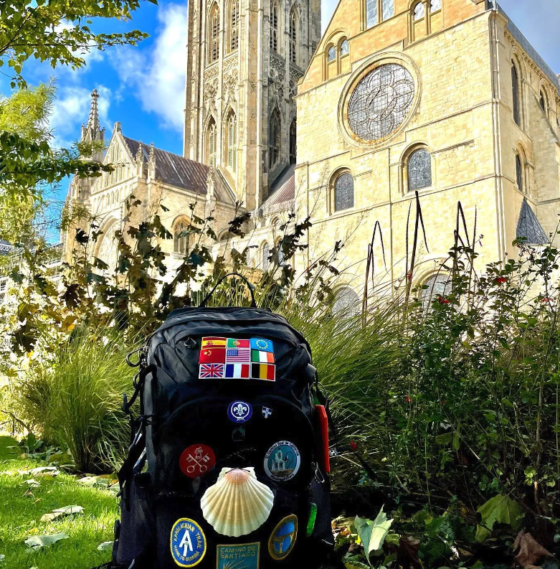 Kevin Donahue’s pilgrim backpack in Canterbury. Photo by Kevin Donahue
Kevin Donahue’s pilgrim backpack in Canterbury. Photo by Kevin Donahue
But I’ve come to learn, and a good friend of mine, English author, Andy Bull, wrote a book called Pilgrim Pathways where he looks at weekend walks, getting into these special spaces, where you’re only devoting a small amount of time because that’s what you have available.
For me, and I want to talk to you a little bit about where I’ve been, but in some instances, it’s been more of a product of what time can I devote to this pilgrimage has defined in some ways the length that I’ve been able to walk. I’ve had to start in some places that had significance for me, that maybe weren’t at the ‘starting gate.’ So, that’s been an interesting part of it.
Jo: I think this is so important, because humanity just makes up rules for things. And it’s like, there’s a measurement of everything that we do. Clearly, the pilgrimage where someone walks for six months from Canterbury to Jerusalem is far more holy than you (!), who only walked for a week or…
Kevin: I would think it would be.
Jo: As you said, it’s about the intention, it’s about the purpose. If it’s an act of religious devotion, and you walk to your local church on a Sunday.
They say on the Camino, don’t they? ‘Walk your own Camino.’
There shouldn’t be judgment or self-judgment around what we did. It’s funny, isn’t it? We always just impose these rules on things.
Kevin: My self-judgment was on full display the day after I arrived in Santiago de Compostela on the Camino de Santiago. You make these walks, and I had done not a long distance. I had done about 100 miles.
I walked the Camino Portuguese section, up through Spain. I was feeling quite proud of myself. I had done this long walk and I had walked along further than some. I was pretty proud of that.
There was some ego there. And there was this lady in the cathedral, and she must have been, I don’t know, 80 years old, 80-plus years old, and she had her walking stick. She was going from the pew straight up to the front of the church. And it was, from my perspective, it looked to be everything she could do to make that walk.
And here I was feeling so proud of myself, in my younger condition, that I had walked 100 miles or whatever. And here she was making a walk that was every bit as meaningful to her, and probably every bit as challenging as mine had been to me. I had to check my ego a little bit, because how we define a pilgrim and how we define that distance of pilgrimage, to your point, we put a lot of rules and a lot of vanity around it. It’s more about what someone gets out of it than what I judge they’ve put into it.
Jo: Absolutely. And I feel like I certainly found my ego broken down by some of the walking I’ve done.
Kevin: Oh my goodness. Jo, you’re an ultra walker. You would lap me a hundred times over.
Jo: Tell us what are some of the highlights, some of the places that are memorable to you that you visited on your various pilgrimages?
Kevin: I’ve had the opportunity over the course of the last few years, COVID willing and health willing, to make a few of these walks. I mentioned I did the Camino Portuguese. I started in Vila Nova de Cerveira, and walked to Santiago de Compostela.
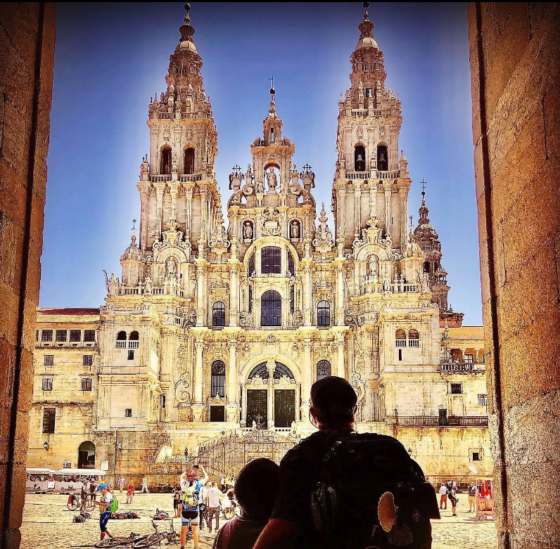 Cathedral at Santiago de Compostela Photo by Kevin Donahue
Cathedral at Santiago de Compostela Photo by Kevin Donahue
That was my first time doing a pilgrimage walk. Everything was a new experience, and it’s like you go to a museum for the first time, and everything you see is the most fascinating thing. And then you move over four feet and you’re like, ‘Oh, now this is now the most fascinating thing.’
Everything I saw and experienced was so fresh and new. I came up to the UK, and I walked a route that you did as well, from London to Canterbury, and the English Pilgrims’ Way. And I did a bit of a different route than you did, because I wanted to be in Rochester. I walked along the Thames Way and then walked over to Rochester, to be in Rochester Cathedral.
Being in the cathedral in Rochester was very important to me, because the patron saint of adopted children is celebrated there. Having an adopted son, I wanted to pay homage and pay respects in Rochester Cathedral. So that was very special to me.
Arriving in Canterbury was wonderful because, and you saw this too, Jo. You get into this grand cathedral, and you suggested to me not to miss Evensong. That was a really special experience for me, with the choir in the background. I was going on to Dover, to begin the Via Francigena. And that night, another pilgrim was arriving. She had walked the old way from Southampton. Caroline is her name.
The two of us were there and we were receiving a blessing. That night, Caroline’s walk was ending, and mine was going on. I had intended, but for those darn ferries in Dover, I had intended to go on into France and such. And so, my walk was continuing. She gave me a coin, a clay coin, that she had been given, and it had a shell sculpted into the coin and she had carried it with her.
It had been given first by a vicar and then to a pilgrim, and the pilgrim had given it to Caroline. And Caroline had given it to me, and now I was carrying it on. I ended up this year, I was in Italy, and I walked a section of the Via Francigena in Italy and I carried that same pilgrim coin with me to St. Peter’s in Rome. I was able to give it to a pilgrim who was walking on from Rome to Jerusalem. It was so special to see that this sort of connectivity between people and purposes was continuing on with his journey to Jerusalem.
As you said, you and I both had the opportunity to go to Lindisfarne, the Holy Island, and walk across the sands to Holy Island. To me, that was probably one of the most special moments. I will never forget the storm that happened the night before, because, whew, Northumbria, there’s some storms, and that was a big one. Between the wind, the gusts, and the rain, I was really nervous about getting to walk the next morning.
But walking across the receding tides, the north sea, and you see these poles that mark the high route of the sands. And since the time of St. Aidan and St. Cuthbert, people have made their way to Lindisfarne. Following in their footsteps was really incredibly powerful for me. I’ll never forget walking to Holy Island.
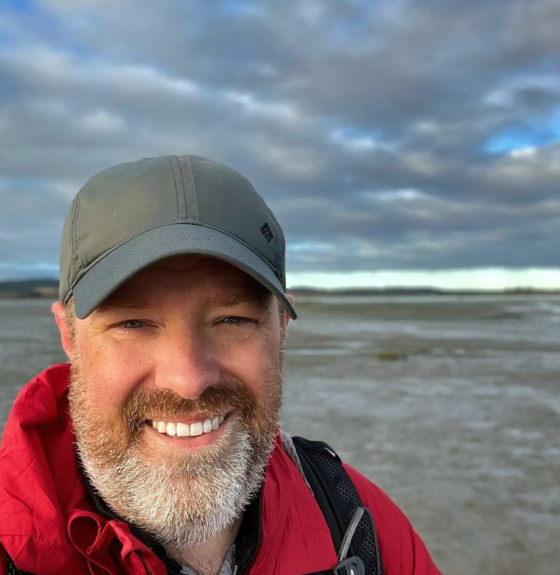 Pilgrim Kevin Donahue about to cross the sands to Lindisfarne Holy Island Photo by Kevin Donahue
Pilgrim Kevin Donahue about to cross the sands to Lindisfarne Holy Island Photo by Kevin Donahue
Jo: I’m so glad you mentioned that one. It’s funny, isn’t it, because there are these incredibly grand cathedrals, obviously you mentioned Santiago de Compostela and Canterbury, and I felt it too. And as you were speaking there, I was remembering my own crossing, and yet it is just your feet in the sand and the water.
When I was there, it was a really sunny morning, and the seals were singing, which was just the oddest sound. I couldn’t really see many people, and there’s nobody waiting there, the same as finishing any pilgrimage. There’s no one waiting, going, ‘Wow, you’re amazing. You’ve reached the pinnacle of your journey.’
It’s these, you mentioned earlier, these moments of greater awareness, where we’re so aware of our place on the Earth, physically and spiritually, and part of this great tradition, as you say, and almost just much more in touch with our physical bodies than I feel we are in normal life.
Kevin: Oh, my goodness.
Jo: You know what I mean? Especially with that crossing. Did you do it barefoot?
Kevin: I did it barefoot. It was a visceral experience. You take your shoes off and you pull up your pants legs and you make your way out. Your feet first touch the seawater. And even the receding sea was covering…it hits your toes and it stings them. The water temperature is in the high 50s, and mid-50s. And it’s just, it’s like daggers.
Then it covers your feet. And then all of a sudden, your body adapts to it a little bit, and you’re walking out through the sands, and you kind of feel the sands and you touch these wooden beams, these wooden poles, that are ragged from rising tides and sea air, and the storms that roll in off the coast. You make your way from one to the next to the next.
 Walker on the sands crossing away from Lindisfarne Photo by JFPenn
Walker on the sands crossing away from Lindisfarne Photo by JFPenn
It’s the bottom of the sea floor. So it’s not uniform. You go through these areas where all of a sudden now that stinging water is making its way up my leg and towards my knee. And then you get to a point where it’s a little higher. All of a sudden there’s grasses and such, sea grasses that may be growing there. And there’s a part that even protrudes above the tide most times. And it’s this sucking mud.
Jo: There’s a lot of mud!
Kevin: And you disappear. I disappeared past my knee, whew, right down into the mud. I’m walking and I’ve got my sticks and I’m trying to sort of maneuver my leg out of the mud, back up to make the next step. And it’s, fup, fup, fup, through the mud, and I look over and there’s this wellie that’s sitting there, stuck in the mud, where clearly somebody had just literally walked out of their boot, trying to make their way across. But it’s not a very long section of the walk. It’s maybe, what, Jo? A mile and a half maybe. It’s a short distance.
Jo: Yes. You can do it in an hour, really. An hour and a half, maybe.
Kevin: Yeah. Maybe 90 minutes at the most, and given the conditions. But, like you, I was alone out there. I like how you said the seals were singing and the birds are flying over, and you have to do it at low tide, which means, in many instances, you’re doing it in the very early morning.
For me, this was October, and it was maybe 7:00 in the morning, and the sun was just rising out over the sea to the east. I’ve been to the Vatican and St. Peters. I’ve been to the crypts and the Scavi. I’ve been to the tomb of St. James the Apostle. And as you said, standing in Canterbury and the beautiful cathedrals at Westminster and throughout England.
I don’t know what tops walking to Holy Island across the sea. That was a really special walk, and I’ll never forget the connectivity, like you said, that I felt in those moments.
Jo: I agree. We should also mention if people are going to do it, that it’s quite a shock to then walk into the little town on the island.
Kevin: Oh, absolutely.
Jo: Because you’ll come off the beach, and there’s cars coming on because the tide is down. And then you walk around the corner, and I was in shock at a coachload of literally American tourists, just arrived.
Kevin: Everyone’s on holiday, right? And here you are with your rucksack.
Jo: Suddenly, it’s mad. It’s bonkers. I stayed overnight. You have to book it, obviously. It’s a very small island. But the mass of tourists, they all leave again when the tide comes in, because it is a tidal island. By staying overnight, the atmosphere got a lot more holy again. But while all the people are there in their coaches, it can be a little bonkers. A really interesting place, right?
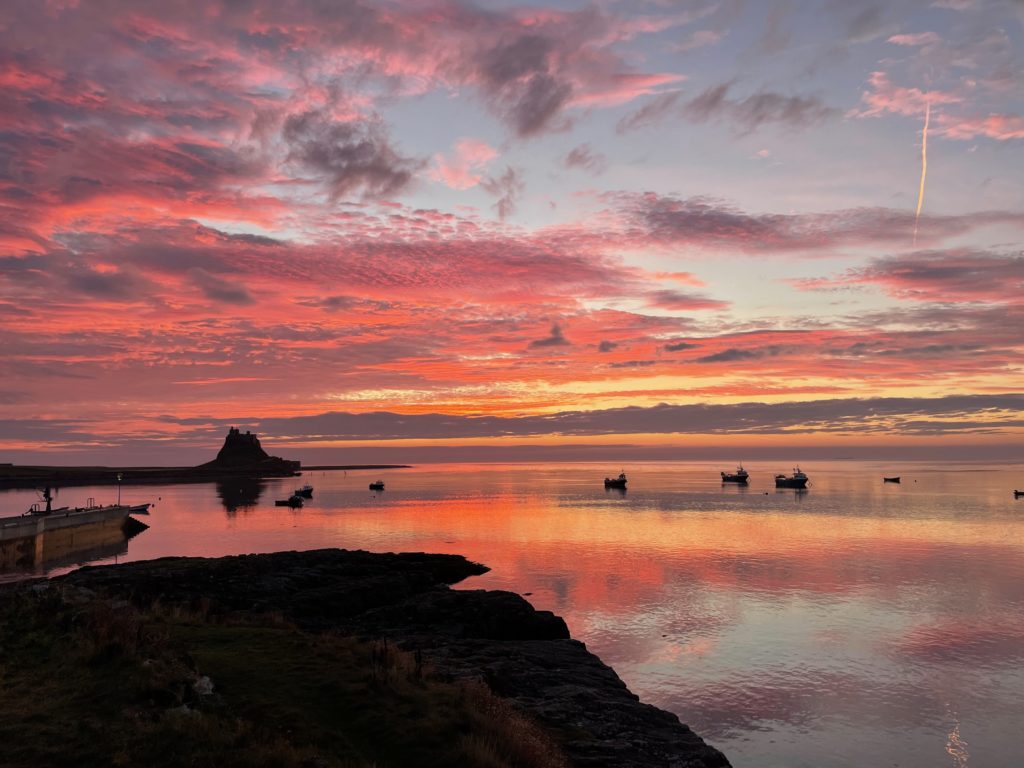 Dawn on Lindisfarne Holy Island Oct 2021 Photo by JFPenn
Dawn on Lindisfarne Holy Island Oct 2021 Photo by JFPenn
Kevin: Absolutely. From low tide to low tide, it’s a holiday market kind of atmosphere. Everyone’s there, they’re doing their tourist shops, and they’re eating and dropping in the pubs and going to the Lindisfarne Abbey, which is beautifully maintained. And there’s a bit of a fake castle there on the island, which is a bit of a tourist attraction.
There’s sort of an artist element, where people are coming to paint or take photographs, and just walk and explore. But then, once you get to that midway point of the tide, maybe 3:00 in the afternoon or 4:00 in the afternoon, the whole island vacates, and it’s just the local residents and those people who are staying overnight.
I agree with you 100%. I stayed overnight, in a wonderful inn, and the storytelling with the locals, and the opportunity to be with people. A few are on holiday, but a few who were also there to see the Abbey, and were treating it as more of a spiritual destination. You have the island to yourself.
I know there’s always this conflict with over-tourism, but to have it to yourself was really special. Definitely stay the night if you can at Lindisfarne. It was wonderful. It’s easy to catch the train up to Berwick, and then you can get a cab over if you’re just going for a bit, if you aren’t walking the way of St. Cuthbert. I definitely recommend a spot if you haven’t been before.
Jo: For sure. I think pilgrimage has to have its challenges, right? It’s not easy, and the challenges can be physical. They can be spiritual, personal.
What were some of your greatest challenges that you’ve experienced during your pilgrimages?
Kevin: Oh, my goodness. On my very first one, I had spent two years reading, and really trying to understand what the pilgrimage experience was like. Because, to your point, I was a backpacker, and I had done walks, and so I understood how to be a backpacker.
I invested a lot of my preparation into understanding the culture and the camaraderie of pilgrims on the Camino. What I didn’t know to prepare for, or maybe I overlooked, or maybe no one warned me at all, was walking the Portuguese, a lot of the roads, a lot of the paths that you walk on are cobblestones.
As I was walking through these portions of Portugal, you’d go on a cobblestone road for a long stretch, a couple of miles, and then you would go off onto a hard rock stretch and then back onto the cobblestones. It really did a number on my feet. I ended up with what’s called stone bruises on the bottom sole of your feet. Normally, if you have stone bruises, you would want to rest.
Jo: Yeah, stop!
Kevin: Because it’s a bruise on the underside, the sole of your foot. If you’re trying to walk, maybe you can wobble back on your heels, but you certainly can’t go very far very fast. So, I had these stone bruises, and I battled with the stone bruises and just trying to find enough padding, batting that I could put under my foot, between my foot and my shoe, that I could continue my Camino. Because after so many years of preparing, I didn’t want it to be cut short.
I really didn’t want to sacrifice anything that I was looking forward to. So, I had a three or four-day pretty intense battle with the bottom of my feet.
What I learned was that you have to understand exactly where you’re going to be walking, and I didn’t have the right shoes for it. I had my regular walking shoes that I would walk through dirt paths or sand paths and very light underfoot, and a very lightweight type of shoe. I didn’t have a very rugged undersole.
That was a great learning for me. And now ever since, I don’t want to promote any brands, but I’ll tell you that I wear a shoe with a little more rugged undersole, which has been great for me.
Jo: Can you tell us the brand? Because I’m walking that route.
Kevin: Yes. I now wear, pretty much everywhere I go, a max cushioning shoe from Altra, called the ‘Altra Olympus.’ They make that in a men’s and women’s model. And there are a lot of max cushioning shoes, and they’re not for everyone because it’s like having two insoles in your shoe. If you’re a runner or a distance walker, you might feel like you’ve got a little less connectivity to the terrain.
[Imogen Clark mentioned the same issue on the Camino Portuguese, and she recommended HOKA SpeedGoat which also have the thicker sole.]
But if you’re walking with a backpack, on what I came to term as ‘hobblestones,’ that was exactly what you needed and what you wanted. As far as the physicality, this past year, when I was walking through Italy, it’s so darn hot in Europe right now. I was just there, and I walked in May and in June, and the closer you get, it was just so hot, and many places in walking the Via Francigena, especially as you get closer to Rome, the path is an old one.
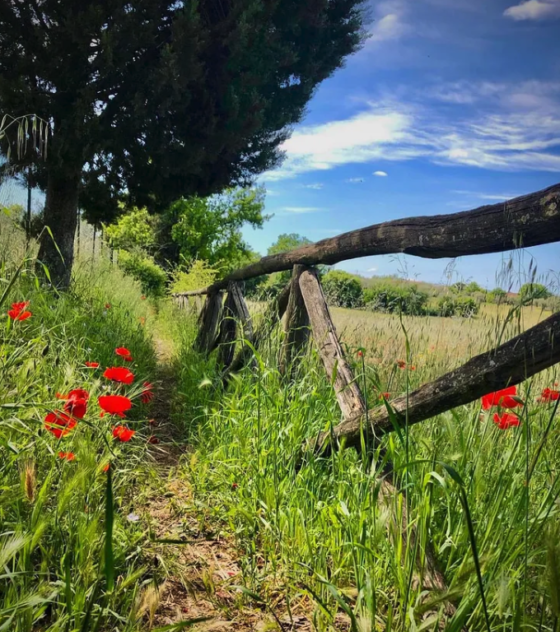 Poppies on the Via Francigena Photo by Kevin Donahue
Poppies on the Via Francigena Photo by Kevin Donahue
You follow the route of Archbishop Sigeric, who was receiving his papers, if you will, from the Pope in Rome, and then recorded his route back to Canterbury. So, that is the official route from Canterbury to Rome. But as you walk, the towns have moved. Over time, where there used to be maybe less distance from place to place, because of the wars and Punic Wars and things that have all taken place over this time, you end up with cities that used to be there that aren’t there. And so, you’ve got some longer distances just out in the heat. That was very tough.
But the one thing I had no idea of, and you probably know this, Jo, it seems like, because of these battles and the different Papal States that have taken place throughout Italy, almost every little town and city in Italy is on top of a hill. As a walker, you walk 12, 15, 18, 20 miles throughout the day in this heat.
Then at the end of the day, your reward is that you get to go up this just crazy hill to reach the top of the city where you’re going to be sleeping that night, or where you have the opportunity to get dinner.
That was very, very challenging mentally for me because you’re so tired, and it was hot, and you were exhausted from the day. And then you’ve got this big hill push at the end, which sometimes was 400, 600 big, big meters up at the end, over short runs, that really were super challenging. And if there’s one thing I could change, I would flatten that part of Italy.
Jo: It’s interesting because these physical challenges, it is hard. We do put ourselves through this. And, I mean, either it’s really hot, or I remember my last day walking into Canterbury, it rained so hard for so long. I’d put in a really big day, and everything was so, so wet. And it feels like the gifts of pilgrimage don’t show up at the time.
Kevin: No. There are no trumpets that are sounding as you’re walking.
Jo: As you’re doing it. But I find that the gifts of pilgrimage come later. When you have time to reflect on the journey and you’re not just thinking about how much pain you’re in or how hungry you are, or how hot you are.
What are some of the gifts of pilgrimage that have emerged for you later in the process?
Kevin: I do think, in some ways, the physicality of it is an important part of the process. Because pilgrimage in and of itself is such a simple life. You eat, you walk, you pray, if you’re so inclined, and then you sleep.
Walk, sleep. A very simple life.
And you just have with you what’s on your backpack, what you’re carrying. So, you have very few possessions.
But as you go, the physicality, what I found, and you and I talked about this on our podcast together, it quiets the mind, but you become in this state where your body becomes a little numb physically, and you’re no longer aware of you stepped on a rock or whatnot, or you did this or that. It’s just sort of you get into this process of walking.
It opens the mind, I think, a bit to everything else around, and what you can see in these natural places. And the engagement that you have with the things around you.
To answer your question, the things that show up beyond the journey often do come later. For me, I think, well, I’ve had the opportunity to have a deeper connection to understand a bit better what’s important to me, and what I consider to be important faith practices that don’t necessarily involve a physical church.
I’ve become, I think, a little more compassionate for other people. My own awareness of my own sufferings and my own shortcomings, especially when you’re walking, and you’re just physically, you say to yourself, ‘I don’t know if I can take one more step,’ it gives me great empathy for people who are going through something in their lives, physically, emotionally, spiritually. I can definitely put myself in their shoes, and have a greater understanding of their challenges than I ever could before.
I think it’s made me a better father in some ways, because I’m more accepting of my own shortcomings. We tend to build ourselves up a bit. At least I do. I had a very large ego, and I think pilgrimage has been a very humbling experience for me to recognize that you think to yourself, ‘Oh, well, tomorrow’s an easy day.’ And turns out that easy day that you thought was going to be so easy, it rained.
Jo: I don’t think it’s ever an easy day, is there?
Kevin: No, there’s really not, but every day is unique and every day is special. I don’t know that I’ve always had an appreciation for that.
Lastly, I think I’m more aware of the intent that people have had in their own creations. You would go to a museum and you see something that has been painted, and obviously, it’s a masterpiece, and we all recognize the talent and the dedication it would take to do that. But just walking through a small town, a small village, and seeing the very ordinary church that had been constructed, and the less ornate paintings on its walls, that, when that was finished, the whole town must have gathered.
The whole church must have gathered and celebrated this more plain, less ornate, less celebrated fresco if you will, and what it meant to them. I think it’s given me a greater sense of understanding of the intent that people have behind what they do, not judging so much the, what I’m looking at, but what must have gone into it and what it must have meant to the people who were there in those moments.
Jo: That’s fantastic. Of course, this is the ‘Books and Travel Podcast.’
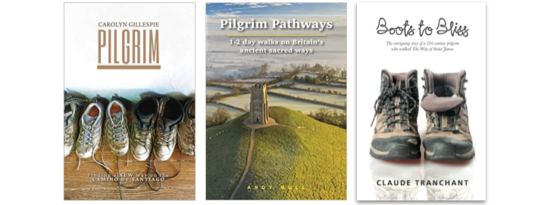
What are some of your favorite books about pilgrimage or particular walking things?
Kevin: I have a few that I’ve finished recently, finished in the last year, that I think are just great. Carolyn Gillespie. Just finished a book called Pilgrim that is a great story of the Camino Frances. Carolyn was a headmaster in a boarding school in England. Scottish lady. And as her children grew and went to university, she ended her professional career.
As an empty nester, now is finding herself without children, where children have been such a huge part of her life, both with the school and her own children. And walk the Camino Frances to give herself the headspace to kind of understand who she might be now. It’s a great book. It’s called Pilgrim by Cary Gillespie.
And another one that I just love, it’s so empowering, is a book by an Australian author Claude Tranchant and Claude…her name is a giveaway, is a French lady, and she walked, at age 64, by herself, alone, from Vezelay to Santiago de Compostela. Claude was not a walker, and had no sense of navigation, and she got lost. Literally, she got lost, and spent some nights in the middle of France, just in nowhere on the side of the road, sleeping on the road.
This little older lady made this journey, and it’s so empowering to me, because there’s a lot of backstory of the things that Claude had put first, ahead of her own self in her life. The Camino showed her what she was truly capable of and what strength she had within. I just love Claude Tranchant’s book. Boots to Bliss is the name of it.
And then for people who are thinking about walking, I mentioned it before, but especially in the UK, Andy’s book, Andy Bull’s book, Pilgrim Pathways, is a great pickup, because it’s written in a way that anybody could walk. It’s in England, Scotland and Wales.
There are 20 short walks, anywhere from a single day to two to three days. A lot of these are sections of longer walks. For example, we talked about the St. Cuthbert’s Way. Andy outlines a section of that, Northern Saints Walk, that you can make, and he shows you how to extend it. But it’s got all the routes, it’s got all the photos, and you can download the GPS routes if you want, and just put it into your OS Maps, and then all of a sudden, you’re a walker. You’re on these pilgrimages.
I just love it. I think it makes what is special to me, walking to these sacred places, so accessible for everyone. So, those are three good ones. Now, there are a lot of Camino books. And I hope to write one myself. I’m almost finished. So, hopefully, I’ll have that for you soon too, Jo.
Jo: Fantastic.
You’re writing Sacred Steps: A Pilgrimage Journal. Is that right?
Kevin: Yes. My first book, Sacred Steps: A Pilgrimage Journal really looks at this intersection of history and faith. The book takes these places that you and I know have been the footpaths of pilgrims for hundreds and now thousands of years, and looks at the historical context as I find myself in some of these places.
It’s really a look at the historical and the modern aspect of pilgrimage along five of these routes that I’ve walked. I don’t think I’ve told anybody this, but I got a little Jo Frances Penn envy when you and I were talking, and you told me, ‘Be careful, because one book could lead to two.’
Jo: Indeed.
Kevin: I’ve also started working on a fiction, a book, The Pilgrims’ Table, which is actually based loosely upon the stories that I’ve experienced and the stories that have been shared on the podcast, where people have encountered really unique and touching experiences throughout their journeys. I’m looking forward to getting that book.
It’s a lot of fun to write fiction, because I’ve never done it before. There’s a lot less fact-checking happening in fiction books, which is great. But it captures that essence of travel as well, and being in these spaces that we all love, and finding something new in discovery, and the things that, unless you go, and you’re in these places, you really just don’t have an appreciation for.
The way they smell, the way this flower dances in the morning light, and the way that the road looks when it’s wet from the rain. I think that’s one of the things we love about travel. Especially for me, slow travel, these walks, when you get to experience places and people and cultures in a way that you never would have on the train or on the plane, or even just motoring by on the highway. That’s become something I’m really so grateful for with these long walks, with these pilgrimage journeys.
Jo: Fantastic.
Where can people find you, and your podcast, and your blog online?
Kevin: Thanks, Jo. The ‘Sacred Steps Podcast’ is available on all of your podcast apps. So, join us. Jo Frances Penn’s episode is on there as well, from season two, so you can grab that one. We’re almost finished recording season three, and getting ready to look to recording season four. So, very excited about that.
The companion websites, sacredstepspodcast.com, sacredstepsbook.com, and then, slowly but surely, thepilgrimstable.com.
Jo: Brilliant. Thanks so much for your time, Kevin. That was great.
Kevin: Jo, it’s delightful to talk to you. I can’t wait to hear more about your upcoming journeys and where you’re going, because the way you have made these spaces come alive, both in your books and on these podcast, is really, truly special. So, thanks for doing it, Jo.
The post Sacred Steps. Pilgrimage With Kevin Donahue appeared first on Books And Travel.
26 August 2022, 12:10 am - 38 minutes 13 secondsLong Term Sustainable Travel. Life As A Digital Nomad With Nora Dunn
Nora Dunn sold everything in 2006 and went traveling, turning her dream of culturally immersive, long-term sustainable travel into a reality. But of course, it hasn’t been an easy ride over the years!
We talk about finding home bases in different places around the world — and why Peru was particularly memorable, how ‘slow travel’ makes long-term digital nomadism more sustainable, tips for working on the road, and the more existential questions of whether travelers can ever stay still for long.
Nora Dunn, The Professional Hobo, has been a digital nomad since 2006. She is a professional speaker, podcaster, and the author of How to Get Free Accommodation Around The World, as well as Tales of Trains, Where The Journey is The Destination. She has lived in and traveled through almost 70 countries and specializes in financially sustainable travel.
- Why Nora left her financial planning practice, sold everything, and went traveling — for the long term
- Finding home bases in different places around the world — and why Peru was particularly memorable
- How ‘slow travel’ makes long-term digital nomadism more sustainable
- Tips for working on the road — and switching away from a ‘vacation’ mindset
- The ‘work’ of travel
- Common fears and how to deal with them
- Tips for financially sustainable travel
- Recommended travel books
You can find Nora at TheProfessionalHobo.com and on Twitter @hobonora
Transcript of the interview
Joanna: Nora Dunn, The Professional Hobo, has been a digital nomad since 2006. She is a professional speaker, podcaster, and the author of ‘How to Get Free Accommodation Around The World,’ as well as ‘Tales of Trains, Where The Journey is The Destination.’ She has lived in and traveled through almost 70 countries and specializes in financially sustainable travel. So, welcome, Nora.
Nora: Thank you so much, Jo, for having me. It’s so amazing that we were able to connect. When I saw you at a conference that we were both attending and speaking at, I fan-girled you in the bathroom—
Joanna: And here we are. Oh, no, it’s exciting to talk about these topics. But let’s wind the clock back —
What initially led you to sell everything and spend your life on the road?
Because I feel like there’s a point when all of us feel like, ‘Oh my goodness, let’s burn it all down and go traveling,’ but not everyone does that. So, what happened to you initially set you off in that direction?
Nora: There definitely was an inflection point for me, as I think there are for many people, but that point itself, of course, was a culmination of smaller inflection points that just built up to this frenzy point.
So, basically, in 2006, I made the decision to sell everything I owned, which included a busy financial-planning practice in Toronto, Canada, in order to embrace a dream of mine. And this had been a lifelong dream, to travel the world in a culturally immersive way, to really crack the code of countries around the world, to break bread around dinner tables around the world, climb mountains, volunteer, really experience what it’s like to live around the world rather than merely traveling through it.
And through various attempts, I had tried to experience this level of cultural immersion through vacations, as long as one month, and I still found that, every time I left that country, I left with more questions than answers.
So, that, combined with constantly trying to quell this inner voice inside of my head that said, ‘Nora, you’re not doing what you’re supposed to be doing, there’s something else out there for you.’
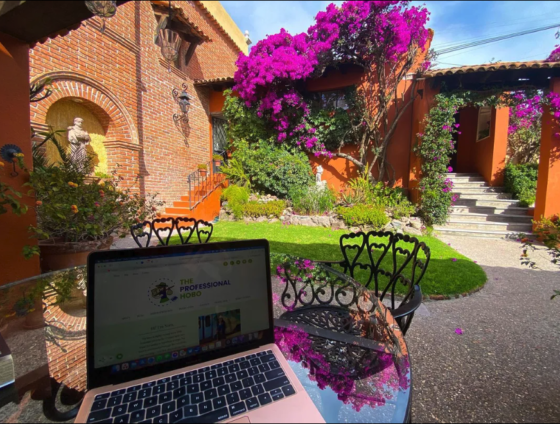 Digital nomad in San Miguel de Allende Photo by Nora Dunn on Instagram
Digital nomad in San Miguel de Allende Photo by Nora Dunn on Instagram
I had filled my life with so many activities trying to find that life satisfaction to the point where, basically, my health came into the fray, I completely burned out, and I was forced to ask myself, ‘What it is I really want to do?’ And in that moment, of course, the answer was, ‘I just want to retire.’
However, the age of 29, or 30 at the time, that was not a possibility. But I also could not imagine putting another 20 years, 30 years into the conventional work system.
I mean, I had achieved a modicum of success as a financial planner at that stage of the game, technically, all I had to do was work less and earn more money for the rest of my career, which was, obviously, a tempting thing. But I just couldn’t face the idea of just putting time in for decades while waiting for this conventional retirement where I might be able to live my dream. And the understanding, the very real possibility that, when I reached that retirement age, I might not be willing or even able to do those things that I wanted to do. And living with regret was not something I was willing to do.
So, I took the bold move, I sold all the things. In 2006, this was not something you did. Words like ‘digital nomad’ and ‘remote work’ and ‘location-independent’ did not exist and I really didn’t know what I was going to do. But I figured it out along the way, and I have been a digital nomad coming up on 17 years, and that life and lifestyle has taken many different forms in many different places. And I wouldn’t have it any other way.
Joanna: So, it’s interesting, I like that you talk there about the sort of cultural immersion and wanting to live in places and not just travel through.
I set off in the year 2000 and I was away for 11 years. But it’s so funny, right now I’m back near where I went to school, I’m in Bath, in the UK. I was born in the county of Somerset, and that’s where I’m living now.
And I feel like, in a way, I don’t know what home is, and maybe we’ll come back to that, but I feel like a lot of people go traveling but people generally then find somewhere and stop. So, I wondered, why did you continue to travel? Did you just not find anywhere where you wanted to stop or did you, as you said, you stopped for a few months and then moved on again?
Why keep moving for so long?
Nora: That’s an excellent question. And actually, Jo, I think your life and my life have paralleled one another quite nicely in that, actually, I returned to my hometown of Toronto after 12 years. So, you came back after 11 years, I came back after 12 years. And I got a home base in Toronto. So, I do have a place now that I use as a base of operations. And I travel as and when I want for as long as I want.
Now, as an example, this year…we’re at the end of July, and I’ve been in Toronto for a total of three and a half weeks. So, I really do hit the road for longer periods of time but I do have that base. And I contend that the digital-nomad lifestyle, as in the purest definition of a digital nomad, to be proverbially homeless and to perpetually wander is a lifestyle that, unto itself, has a shelf life.
Most of my compatriots who started around I did, they all came off the road, in one form or another, around the 10-year mark. This seems to be the mark where people start to feel that they want to have a little more sense of permanence. It’s not that they’re hanging up their traveling shoes but it’s that they’re shifting the way they travel and live around the world.
For myself, I think I lasted as long as I did because I traveled sometimes so slowly it was imperceptible. And, like, I set up bases around the world, and these were places that I wanted to have a base to use for further exploration of that region of the world or, in some cases, I thought that maybe that was my new home with a capital H.
So, as an example, I spent about a year and a half on and off in Australia, I spent about nine months in New Zealand, I spent two years in Peru, a year in Ecuador, two years on the Caribbean island of Grenada. Those were some of the longest periods of time that I stayed in some places. And in many other places, I would stay up to six months.
And that slow travel, of course, helps me achieve the feeling of being able to live somewhere and to dig below the surface of what we would experience as travelers. But then, also, I do believe that this is a function of sustainability in the digital-nomad lifestyle, not only financially but also emotionally and metaphysically, if you will.
Joanna: No, it’s really interesting. And I mean, I stayed away a long time in Australia and New Zealand but those are easy countries really to live in. And you mentioned there Peru and Grenada as a couple of the examples of where you stayed longer. So, pick one of those and tell us what was it about, where you found a home there for longer.
Are there any particularly memorable places where you lived?
Nora: Well, Peru certainly is one that would stand out in my memory in that I found myself going there kind of on a whim. Most of my destinations tend to choose me and they choose me in the form of an opportunity, whether it’s to stay with someone or there’s a serendipitous connection or there’s an opportunity to house it or volunteer.
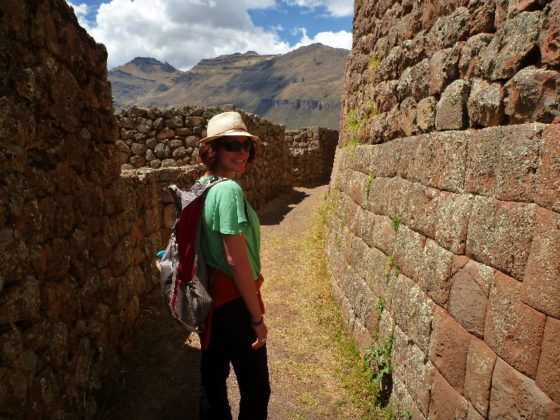 Nora Dunn in Peru, Photo by Nora Dunn
Nora Dunn in Peru, Photo by Nora Dunn
So, Peru was one of these magical places that I found myself wandering into and falling in love with almost immediately. I was staying in the Sacred Valley of Peru. And, within a few months, I actually found myself apprenticing with a shaman.
And I spent two years living and apprenticing with this shaman in the Sacred Valley of Peru. This was one of those examples where I thought my life was moving in a completely different direction. I’d actually kind of tabled my online business and done only what had to be done in order to keep that going because I had what I can now in hindsight call ‘delusions’ of this new lifestyle of working with plant medicine and living in the Sacred Valley and whatnot. And that came to a glorious halt in the most dramatic of ways you can imagine.
And that’s okay. I mean, it was an experience, certainly. I was working with Ayahuasca in San Pedro. So, that was an experience, an unbelievable experience, not only for my own healing and self-development and growth but then also to facilitate that for other people. It was incredible.
I could not have described or imagined a more idyllic place to live. I would wake up every morning and I’m literally in the middle of the Sacred Valley, like, these gigantic mountains were towering on either side of me. I had this curtain of jasmine outside my front door that just filled the house with an unbelievable scent, I called it ‘the jasmine palace.’ And I was in this wonderful rural location but then also within walking distance of everything I needed. So, I had the conveniences of life with the joy and the fulfilling nature around me.
And I was doing this amazing work with this shaman who I absolutely adored and idolized — I think that was part of the problem. Because there were definitely some challenges in that relationship. But it was an incredible experience.
And Peru was a country, I mean, whether or not you’re gonna work with plant medicine or apprentice with a shaman — which I, frankly, don’t recommend — Peru is an amazing country. I mean, I felt like, every time I left the front door, I mean, the color and depth of the culture, especially the Andean culture within the Peruvian Andes and the Q’ero nations, were just unbelievable.
So, I mean, as much as I felt like I was in familiar territory. I was getting my residency, like, I felt at home there, I also felt, every time I left the house, like I was a traveler.
So, I had that beautiful synergy of both those experiences, of feeling like traveling without having to move. And that was really key that satisfies that desire again. I think once a traveler, always a traveler. I think you and I probably can see eye to eye on that idea that, being a traveler is as much a state of mind and being as it is a function of where we physically are in the world.
Joanna: Yeah, sure. And it’s so interesting. I mean, you talked about how beautiful that Sacred Valley was but we get — overfamiliar — I think, is probably the word.
There’s a phrase ‘hedonic adaptation,’ which is you get used to stuff even when it’s amazingly beautiful and, like, everything’s brilliant. And we have that human sense of, ‘What’s next?’
And perhaps, I don’t know whether that’s part of the traveler’s soul, which is about seeing further ahead, perhaps I like walking so much because I like the sensation of moving across the world. I like staying somewhere different every night but not for too long.
I like to stop eventually and come home and for things to be normal. So, that sense of going away and coming back, I guess you talked about that at the beginning sort of now finding that Toronto is that place for you again. But is that what kept you moving, the need for change almost, the need to move?
Nora: It’s a fabulous question. And I would say there are a few different motivations that people have for traveling, especially for adopting a lifestyle like this. And it often is a push-pull thing.
We’re either moving away from something or we’re moving towards something.
And it can also be a mix of both. And I will say the reason I came back to Toronto had much less function of the fact that I’d ever been running away from anything.
Or, in Toronto, I thought I was moving towards something but I was actually a little bit misguided in what I thought I was moving towards in that, after 12 years on the road, I had lost all sense of belonging in the world, in that I was always the odd man out. I mean, again, this cultural immersion, this primary objective of living around the world in a very local way was exactly what I was doing, but it also meant that there was nobody like me in any of the places I was living in.
No one had this travel lifestyle, no one had remote careers, no one knew what a digital nomad was. So, they didn’t understand that I wasn’t a traveler, I wasn’t on vacation. They didn’t understand why I wasn’t conquering their destination and doing all the things within two weeks and that time spent on my computer was actually working, you know, like, I had a job, it just didn’t involve me having to clock in somewhere. So, I felt like it was constantly swimming up this stream of misconceptions and constantly having to define and even defend my lifestyle along the way.
So, after enough years of that, I really started to feel like I had lost all my sense of belonging. So, I returned to Canada thinking what I was looking for was a cultural sense of belonging. And fairly quickly found out that, in fact, actually, Canada is not my people. I mean, they are my people in a sense but the people that I was looking for were other people who shared this lifestyle and who shared this passion for travel and discovery and having these new experiences. Because, wherever you travel, there you go…what is it, ‘Wherever we go, there we are?’
Joanna: Yeah, ‘there we are.’ That you can’t get away from yourself, basically.
Nora: Right. So, the whole idea of running away from something is inevitably going to catch up with you at some point. But what I do find is, when I take myself out of a familiar environment, it gives me a chance to examine myself a lot more and how I react to new situations and circumstances. And it gives me a chance to, with a dose of awareness, change up my dance moves and decide how I want to react to new situations that come my way.
And that’s one of the things I connect with your desire for the pilgrimage in a similar way, I think that that’s also a great exercise in self-exploration. And especially when you’re walking alone and you have a lot of time with yourself to really assimilate all our experiences.
One difference between I think the way you like to do a pilgrimage and the way I would like to do one is I want to stay a little bit longer. So, there’s a pilgrimage shed that just opened up in the Julian Alps in Slovenia called the Juliana Trail. And I think it’s a 17-day town-to-town track.
And I love the sound of it, however I wanna take like three months to do it. And I will bring my stuff and what I will do is I will walk to a town and I will stay there for a few days, I’ll get a flavor for the place. And whenever I’m ready to move on, I will move to the next town. So, I’ll make it a pilgrimage of lifestyle versus getting through to the destination.
And one of the beautiful things about lifestyle design and working location independently and being a digital nomad is you can do what you want, when you want, where you want, and how you want for as long as you want.
And there’s definitely a double edge to that sword but, if we just look at the design aspect…you returned to the UK and got a home base, I returned to Canada and got a home base. I initially thought I was hanging up my traveler’s shoes, and I was no longer a digital nomad, and then, magically, they brought in the definition of ‘digital nomad’ to be anybody who works and travels, regardless of whether or not you have a home base. So, apparently, I’m still a digital nomad.
And this is also what I said earlier about we are all travelers at heart. I think that this is something that can exist within us. This exploratory nature is inherent, versus something to just get out of your system. At least for some people.
Joanna: You mentioned doing what you want, your lifestyle design, doing what you want for as long as you want, and also working while you’re traveling. And I did want to ask you about this because I do love traveling but I really struggle to do my work when I’m traveling because I’m almost in input mode.
I write a lot of notes when I travel and I take a lot of photos but, in terms of actually work work, like opening a laptop, I just can’t do that while I’m traveling. So, I wondered what are your tips for people who want to do that kind of digital-nomad or even just working type longer time away, not a whole year perhaps? But even a couple of months, like, people will still need to log on and do their work.
What are your tips for working on the road in strange places?
Nora: You know, it’s constantly a battle. Work-life balance is a moving target, and you’ll always feel guilty. Just get used to the idea that you’re going to feel guilty.
When you’re working, you’re going to feel guilty for not exploring whatever gorgeous vista lays outside your window. And when you’re out exploring, you’re going to feel guilty for not working. And I think the pandemic has now helped people realize that, when you can work anywhere at any time, it becomes difficult, for some people anyway, not to work everywhere all of the time. So, striking that balance, I think, is an important thing to do.
And it has to do with mentality as well. So, if you are in a vacation-style mentality, you might be less inclined to want to open up the laptop and get work done. However, if you need to, if it is a necessity to work and continue working full time, or however you wish, as you are traveling, probably my top tip is slow down.
If you’re just going to go away for three or six months, do not pack this trip the way you would if you were not working.
The act of travel itself is a job. It’s a lot of work.
I mean, even just learning the daily tasks of life, trying to figure out where to buy milk and how to do laundry in a new country, is a thing.
And I always encourage people to think about what your lives and lifestyles are like at home while you work. So, if you work full-time, how often do you go out and do things, something that might be equated with a touristy activity abroad?
You might go out once or twice on the weekends, or maybe once during the week, but the rest of the time when you’re not working you’re just tending to the daily tasks of life, shopping, cooking, exercising, Netflix and chill. Everybody needs some downtime, it doesn’t matter where in the world you are. Because if you don’t have that balance of life and lifestyle, you will burn out.
So, the only way you can experience a destination in any mystic sense is then, by extension, to stay longer. So, afford yourself, give yourself the gift of time in a place. Generally speaking, I say at least a month.
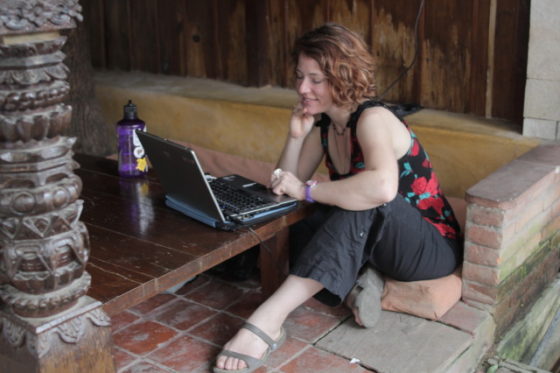 Nora Dunn working in Nepal, Photo by Nora Dunn
Nora Dunn working in Nepal, Photo by Nora Dunn
And that may seem like a lot at the outset but, if you do that…because, if you’re changing locations every month consistently, you’ll also find that that is a really fast pace of travel in terms of the overall sustainability of a digital-nomad lifestyle.
Joanna: I love that you said that the act of travel is work. I’ve done lots of podcast episodes now. No one’s ever said that, but I completely get what you mean. But can you expand on that and, I guess, how we can reframe it as an acceptable part of the experience? I feel like there’s a lot of moaning about travel but, like you said, it’s part of the work of travel. So, what else do you include in that work?
Nora: So, if we just look at the logistics of a travel lifestyle, right off the hop, you’ve got to choose a destination. So, you have got to decide where you’re going to go. Then you’ve got to figure out where in that country you want to stay. And then you have got to figure out where in that city you want to stay. And then you have got to figure out how to find a place in that city. And then you have got to make arrangements to get to that place from wherever you currently are. You haven’t even traveled yet, this is all the pre-work, right?
Then you have to get there and get the place. And then you have to figure out how to survive there. ‘Where do I get my groceries? How do I do the laundry? Where are the things and the places and how do I find the activities that I want to do? And do I need to rent a scooter or a…’ All of this. Again, just learning to survive in that destination.
And that process takes often a few weeks before you even start to feel remotely comfortable or familiar in your surroundings. At which point, if, for example, you’re moving every month, you’ve now got to start the entire process over with the next destination. So, if you’re moving once a month, I mean, again, if it takes you two weeks to figure out how to get to the place, and then you get to the place and it takes you two weeks to figure out how to be there, it never ends.
So, I often say that, in order to cut yourself a bit of a break, something closer to the two-to-three month mark is much more sustainable and rewarding when it comes to this lifestyle. Because the next thing is it’s nice to make some kind of social inroads. Now, it’s not often that locals or local communities are going to invest a lot in a friendship with you if they know that you’re going to leave in a couple of weeks. However, you might be able to have some deeper relationships with people if you’re staying for a couple of months.
And then there are also opportunities to connect with maybe expat communities or other digital nomads who are in the area.
There’s a huge…I mean, if being a digital nomad was a movement prior to the pandemic, if it was a trend or a wave before the pandemic, it’s a tsunami now.
Because, of course, millions of companies around the world were forced to go remote or become obsolete because of all the lockdowns that happened around the world, which means now there are millions, if not billions, I don’t know, of people who work remotely. A portion of whom are going to be interested in taking their jobs on the road and experiencing the long-term travel lifestyle while working remotely. So, the infrastructure that is being developed globally to enable this is incredible. And it will make travel much easier in the coming years for people who want to experience long-term travel in this way.
Joanna: On your website, you share loads of tips, and your books contain loads of tips. And there is a digital-nomad online community now where you can pick up these tips and come to this city and do this. And so, there are all of those aspects. And there’s things like traveling long-term with children and all of that. So, there’s almost the answer to any question.
So, that’s all the practicality side of it, but let’s just talk about fear. Because, I mean, for me, I mean, before the pandemic, fear of ill health and getting sick somewhere else is a big thing. And, I mean, especially, particularly with Americans listening maybe with healthcare.
Or, in fact, I get petrified of getting sick in America because I always have insurance, like, I’m obsessive about health insurance when coming to America, but it always worries me, ‘What if something happens and it fails?’ Because it’s so expensive. There’s other countries that might be cheaper but they might not have such great healthcare, for example.
What are some of the common fears that people have or that you’ve had, over the years, and that you’ve overcome?
Nora: You know, fear is often intrinsically tied with the unknown, the what ifs. ‘What if I get sick? What if something happens?’ What if, what if, what if. And it’s good to consider the what-ifs and to create those contingencies. So, kudos to you for making sure that you have travel insurance, I am a big proponent of travel insurance. I think if you cannot afford insurance, you cannot afford to travel.
And the people who say, ‘Oh, if something happens to me on the road, I’ll just crowdsource and then,’ you know, ‘the universe will take care of me,’ I react viscerally to those kinds of statements. Because, again, maybe the financial planner in me, it’s like, if you don’t take care of yourself, no one else will.
But also too I have experienced — I’ve had three tropical diseases, I was in a near fatal accident, I’ve had robberies, I’ve had a lot of life. I’ve survived three natural disasters. A lot of stuff has happened to me on the road. And it’s important to have that infrastructure in place.
So, I think that we can mitigate some of those fears of the unknown by creating this infrastructure and putting measures in place. A lot of the standard questions that I get from people, insurance is a big one, ‘How do I get my mail? How do I do my banking? How do I make sure that I have cash when I need it?’ And there’s a lot of things, there’s a lot of minutia that might stop people before they start into this lifestyle. And if we tackle each of these challenges one by one, I believe the fear factor reduces significantly.
However, you will never eliminate that fear. And I think anyone who is a traveler is the sort of person who enjoys putting themselves out of their comfort zone. If you didn’t enjoy or crave that experience, you wouldn’t travel.
So, I think a little bit of fear is a good thing because, I don’t know, it makes us feel alive. When I’m in a new place, my senses are totally heightened. And partly because, especially when I’m traveling alone, it’s a safety thing. I need to be really aware of my surroundings and what’s happening around me because I am in the unfamiliar and the unknown.
So, I’m practicing street sense and doing all the things. Again, I know how to be and how to live and how to travel but it doesn’t mean that there isn’t just that little bit of an edge to the experience, which I think is something that makes us feel alive.
Joanna: Absolutely. And that’s why we want to do it again.
It’s interesting, you mentioned ‘comfort zone’ there. And I always feel like — and it’s a hazard of being someone who likes to travel — is that our comfort zone is out there doing other things and moving and experiencing new things. And we actually feel out of our comfort zone when, I don’t know, doing something locally with people who’ve been in the community a long time.
Or the comfort zone is almost reversed and we struggle in a more domestic situation. I feel like, when I’m tired, then it’s fine, but when I’ve got some energy, I’m like, ‘Right, it’s time to go. I need to get out.’ Again, which is why I do a lot of long walks, which I can actually do in my area. And then, by the time I’ve walked myself into submission — that’s how I put it — I’m like, ‘Okay, I can just sit down now and relax in my house.’ But do you find that?
Do you find your comfort zone is different to other people’s?
Nora: I think that a lot of what I have learned on the road are things that I can apply, with a degree of consciousness, to my life in home base in Toronto as well. And actually it’s such a timely question because, in the last few weeks, like I said, I’ve spent most of this year, so far, abroad.
And I came back to Toronto to experience the best of what Toronto has to offer, which is the rest of summer and autumn, and immediately felt like, ‘Oh gosh, I don’t really wanna be here,’ and feeling, really questioning, like seriously questioning whether or not I want to keep this base here at all. Which was a pretty stark departure of how I felt, you know, a few years ago when I got this base.
And I thought, ‘Okay, well, before I throw the baby out with the bath water, let me try a few new dance moves.’ And what I decided to do was I decided to apply that traveler mentality and that experience of, perhaps, pushing myself out of my comfort zone or having and doing something new to a place that was familiar.
And so, what I did was I chose a pastime that I had been interested in digging my heels into, proverbially and literally speaking, for quite some time, and that was dancing. So, I threw myself with a vengeance into the salsa and bachata community in Toronto. And as I dove down into this rabbit hole, I discovered there’s a huge thriving community of salsa and bachata dancers.
And so, now, instead of being in that routine that I had, especially also to…I was locked down in Toronto through the pandemic, so, there’s kind of pandemic energy hanging on the walls of my place and it’s really easy to get locked back into that daily routine that I was in when I was unable to do anything else.
And, in order to shift out of that and to make the most of Toronto, I’ve now adopted a new pastime that will put me out of my comfort zone again without having to get on an airplane. So, being able to apply the lessons that we learned on the road to life at home I think is a really valuable experience.
Joanna: Absolutely. Seeing it in a new way, I think that’s really important. So, well, you talked there about, like, dancing and taking on new things, and I feel like money is such a big deal, mainly probably because most of us, when we travel, we spend more money than we would at home because we’re doing special things or whatever. And you, obviously, were a financial planner but you also do still blog about financially-sustainable travel and you’ve got this book about free accommodation.
People can find lots of tips on your website, but what are just a couple of tips about financially sustainable travel that can get people started?
Nora: So, when I hit the road, the financial planner in me, of course, never went away. So, I was tracking my expenses, because the first step to creating any kind of budget is to understand how you spend your money. And I was tracking my expenses and I discovered, in my first couple of years abroad, much to my surprise and delight, that the cost for me to travel full-time was significantly less than I ever spent to live in one place. And I was shocked by this. And I immediately wanted to show other people that this lifestyle is possible and that it doesn’t have to be expensive.
So, for my first 10 years abroad, I actually published my annual income and expenses, all in, to prove that full-time travel can be financially sustainable. In so doing, I inadvertently coined this phrase of ‘financially sustainable travel.’ Which hinges on three pillars.
The first pillar of financially sustainable travel is earning money remotely. And that could be a lot of money or a little bit of money, that spectrum is quite wide. The second pillar is making creative conscious spending choices. And the third pillar is balancing the first two, balancing the money in and the money out so you can maintain this lifestyle as long as you want.
So, this is why, when people ask me for budget templates for long-term travel, I say, ‘I can’t do that because this lifestyle looks dramatically different for everybody. Your speed of travel, your destination, the sort of activities you like to do are all going to be very different.’
But in my first couple of years of travel, I didn’t have a lot of money coming in. So, the creative conscious spending choices that I made were different and creative. For example, in my first 10 years on the road, I saved over $100,000 by getting my accommodation for free. And I didn’t know, prior to my travel lifestyle, that there was a whole world of free accommodation and, I literally wrote the book on it, there’s five different forms of accommodation that you can get. And that includes volunteering, house sitting, living on boats, hospitality exchanges, and, if you still have a home base, home exchanges.
And each of these play very interestingly into the travel lifestyle. Some are definitely better than others in terms of how well they go along with remote work as well. But all of them provide really interesting experiences that I could not possibly have had any other way by staying in hotels or hostels or even Airbnb. So, they were really culturally rewarding and immersive experiences but then also had the advantage of saving me boatloads of money along the way.
So, that’s an example of how, in fact, actually this travel lifestyle can be much more achievable than we often think it is. Because again, the concept of travel is so often intrinsically connected with the idea of vacations. It’s difficult to break out of that vacation mentality and also the budgets that we often consider that go along with that.
Joanna: Absolutely. It’s all a matter of choices. And as I said, you’ve got loads of stuff on your website about that. But we’re almost out of time, and I did want to ask you, since this is ‘The Books and Travel’ show, apart from your own books —
What are some you recommend about digital nomadism or travel in general?
Nora: I’m a sucker for a good travel memoir. So, the books that come to mind for me…there’s definitely three that I can think of and two are almost more about the author than the book, but a book that I read many years ago and just continue to adore is Anthony Bourdain’s ‘A Cook’s Tour, In Search of The Perfect Meal.’
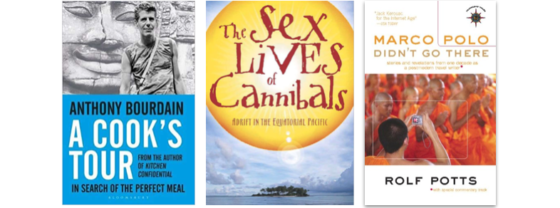
His writing is unbelievable. And it’s funny, it’s culturally-sensitive. And that particular book is also interesting because he wrote it about and while he was filming a TV show. And I have a former career in television, so, being able to kind of experience the behind the scenes of what it’s like to film a travel TV show while also experiencing food and culture was, like, the trifecta of joy for me. And he’s so engaging and funny, so, I’m actually working my way through all his books.
Another author whose books I really like to work my way through is J. Maarten Troost who is probably most well known for a book called ‘The Sex Lives of Cannibals‘ because he spent a few years living in Micronesia. So, he’s written a few books in that area. Excellent, again, engaging, funny, culturally-insightful. But one of his books that I found really interesting was also called ‘Lost on Planet China.’ And he wrote it coming up on the turn of the century because, you know, around Y2K, the word on the street, if you may recall, was that we would all be speaking Chinese within 20 years because China’s GDP was just huge around the year 2000. So, he was raising a daughter at the time and he thought, ‘Well, if everyone’s gonna be speaking Chinese, if this is gonna be the way we’re gonna go,’ he said, ‘I better go to China and figure this place out.’ And, well, the title says a lot of it but the book says even more, so, I’ll leave it at that.
And then the third book I really enjoy is by Rolf Potts, who, of course, is known for having written the book called ‘Vagabonding,’ which inspired the world, in many ways, to embrace long-term travel. And that’s a good book but the one that I really like is called ‘Marco Polo Didn’t Go There.’ And it’s…
Joanna: Great title.
Nora: Right, it is. And it’s a collection of articles, he’s a very very talented article he’s written for a lot of magazines over the years, and it’s a collection of these articles that he’s written that have been republished. But the magic of this book is he also has footnotes that fill in the backstory of, perhaps, what really happened in that experience as it contrasts to the article that got written.
Because often, as travel writers, especially if you’re writing, if you’re limited by a word count or a publications platform, you can’t always write the full story. And so, as a travel writer myself, that was a really insightful way to see how a story gets crafted from an experience without necessarily sharing the full experience in the story itself.
Joanna: Great recommendations.
Where can people find you and everything you do online?
Nora: My online home is TheProfessionalHobo.com. And you can find all of the extensions of that home, which includes YouTube and all the social things and places, from there. And I also have a free gift for anyone who’s listening who’s interested in learning more about the long-term travel lifestyle. If you go to theprofessionalhobo.com/freegift, I have made a checklist for you of 10 things that you must consider before you travel long term.
And these are some of the things that we talked about earlier that can help you cover the bases of the things, those questions, you know, ‘What do I do with my phone plan?’ and ‘how do I get money?’ and all of these things so you can take care of those logistics so that you can travel stress-free and long-term for as long as you wish.
Joanna: Brilliant. Well, thanks so much for your time, Nora. That was great.
Nora: Thank you, Jo. It’s been a pleasure.
The post Long Term Sustainable Travel. Life As A Digital Nomad With Nora Dunn appeared first on Books And Travel.
11 August 2022, 12:10 am - 40 minutes 1 secondA Yearning for Setting Off. Walking The Camino De Santiago Portuguese Route With Imogen Clark
Why does pilgrimage have such a hold on those of us who are not religious, but merely seekers on a path that so many millions have walked before us? Author Imogen Clark talks about her Camino, the highlights and challenges, the lessons learned, and why she still yearns to set off once again.

Imogen Clark is the best-selling author of eight contemporary women’s fiction novels, and has sold over a million books. She recently walked the Camino de Santiago on a variant of the Portuguese route.
- What is pilgrimage and how is it different to just a long walk?
- How “a yearning for setting off” shapes Imogen’s fiction and how it led to her Camino
- Highlights of the route — and memorable moments
- The challenges of the journey
- The gifts of pilgrimage often emerge much later than we expect
- Practicalities of the Camino Portuguese coastal route
- Recommended books
You can find Imogen at www.ImogenClark.com and on Twitter @imogenclark and Instagram @imogenclarkauthor
My book, Pilgrimage, Lessons Learned from Solo Walking Three Ancient Ways, which features this Camino route, is out now.
 My book, Pilgrimage, Lessons Learned from Solo Walking Three Ancient Ways, is out now
My book, Pilgrimage, Lessons Learned from Solo Walking Three Ancient Ways, is out now
Transcript of the interview
Jo Frances Penn: Imogen Clark is the best-selling author of eight contemporary women’s fiction novels, and has sold over a million books. She recently walked the Camino de Santiago on a variant of the Portuguese route. Welcome to the show.
Imogen Clark: It’s lovely to be here.
Jo Frances Penn: Fantastic. So, let’s start with a question of definition, really.
What is pilgrimage to you, and how is it different to just a long walk?
Imogen Clark: I think it is a very, very personal thing. I have no religious faith. I was brought up within the Church of England, and I spent a lot of time in the Church of England because I sing in a choir, but I don’t have any faith. But I am always seeking I think, and I’m always seeking spirituality, and by my nature, I’m very, very curious.
So I think the pilgrimage for me was partly because I was curious about exactly what would happen to me if I was on a pilgrimage. But also, I think the idea of walking to a specific place, with a common purpose, with lots and lots of other people, because the Camino is very busy. There are a lot of people all walking in exactly the same direction, all doing exactly the same thing as you. I found that very, very comforting that there were so many people all seeking the same thing as me.
And I also found that it’s so uncomplicated when you’re walking…when you’re traveling generally, usually trying to fit things in, and trying to see different sites, and you’ve got a list and that kind of thing, and similarly, if you’re doing a walk as well.
But when I was doing the pilgrimage that wasn’t the idea. Obviously, we passed things, and we saw beautiful things, but that wasn’t the focus of what we were doing. They were the things that we saw as we walked to Santiago. And that’s a different emphasis and I’ve never really done a walk where it was just the walk that was the important thing.
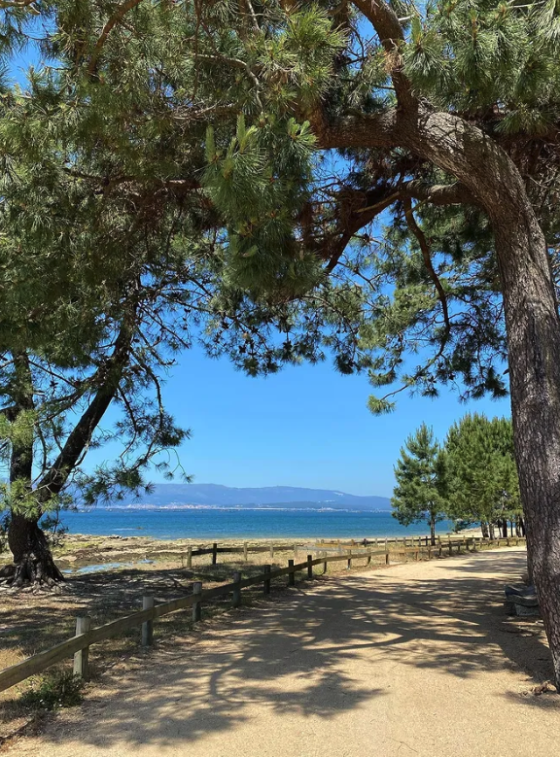 Camino de Santiago, Portuguese route. Photo by Imogen Clark
Camino de Santiago, Portuguese route. Photo by Imogen Clark
Jo Frances Penn: Oh, you brought up loads of things there. I just want to come back on why now? You mentioned that you don’t have any faith but you are a seeker and you are curious.
Did something happen in your life that made you want to walk this Camino? Because of course, there are many different pilgrimages you could have walked.
Imogen Clark: I think I’ve always been aware of the Camino, so it was always something that I was interested in doing. But the thing that happened that made me really want to do it was that my children all left home. So they all went off to work and college, and what have you, and suddenly, I had the time really to focus and devote on things that I wanted to do as opposed to constantly doing the things that other people wanted me to do.
And so when I started to think about what I would like to do in that time when I wasn’t rushing and trying to sort everything out for everybody else, this was an obvious thing. So even though it’d been in the back of my mind for probably 15, 20 years, it’s only now when I was able to go away without worrying about what everyone else was doing.
And I think part of it being a pilgrimage is that you do have to focus on it. And so if I’d gone and the children were still at home, I’d be constantly feeling like I had to ring in to make sure everyone had got what they needed for school and all those kinds of things. Whereas this time, because they were all busy doing their own thing, I could entirely focus selfishly almost, on me, and the pilgrimage, and what it was that I was trying to achieve.
Jo Frances Penn: I think that’s great. And it’s interesting though because I don’t have children, I am happily child-free, but I have also thought about doing this for, like, 20 years, probably even more than 20 years, and I then vowed when I was lying ill with COVID that if I died, it would be the one thing that really annoyed me that I hadn’t actually achieved. It was on the list of, ‘I wish I had done this in my lifetime.’
Do you remember how you first heard of it? Because I feel, like, Church of England, for example, doesn’t have such a pilgrimage tradition as the Catholic faith. Do you remember where it came from?
Imogen Clark: I can’t remember specifically where it came from, I think I just…it feels like I just always knew it was a thing and it was there.
And I think because the part of the Church of England I was involved in was very high church. As a girl I did a lot of singing in cathedrals, and so I was very used to the very high Anglican faith. And it’s less odd within that part of the Church of England in the sort of pilgrimages, and retreats and those kinds of things fit more neatly I think, into that part of the church, so I was just always aware.
I suspect possibly, I saw something about it…I used to sing in Canterbury Cathedral every summer when I was a girl when the boy choristers were on holiday, and they used to invite choirs in to come and sing Evensong and the other services. And I suspect there was something, some display or something within the cathedral that I saw back then when I was, however old in my teens that made me think, ‘Oh, that’s interesting.’ Fancy walking all the way across Spain, can you imagine that kind of thing? I mean, it just stuck with me really.
And I think I have a real yearning for just setting off.
I think it’s very interesting that some of the books I write, and a lot of the books I read are people just setting off and doing something. And I think when you just…obviously, there needs to be a plan, but when you just want to just start, and you just want to go from A to B, without it being a huge holiday kind of thing, those things have always really, really interested me. So I suspect just the mere word pilgrimage made me think, ‘Oh yes, let’s see what that’s about, and let’s just set off.’
Jo Frances Penn: It’s interesting also you used the word ‘selfish’ about yourself kind of doing something for yourself, but I almost feel like pilgrimage, it’s not a holiday. Like, it is obviously travel, you’re seeing things, you’re probably eating some decent food at some point, although it’s never about the food, and you’re physically tired and there are lots of challenges.
Did you get over this feeling of it being maybe selfish time. Did you embrace it for what it was?
Imogen Clark: Yes. I really did because I think, what’s the point of going if you feel guilty all the time?
And I did think, ‘This is the whole point of doing this walk,’ apart from curiosity, which is the motivation for loads of the things that I do. But was really, to get some time where I could just breathe really, and think.
And normally, I’m very busy, and I’ve got a butterfly kind of brain, and I’m always doing at least three things at once, and I listen to loads of books, so I’m very rarely actually just in my own headspace.
And before I set off I said, ‘Goodness me, you’re going to do all that walking. You’re not going to listen to a single thing. How on earth is that going to work?’ But actually, it was really, really lovely to just take that time and be in my head.
I mean, I was with my husband as well, I wasn’t on my own. But be in my head and not be frightened of being in my head because sometimes I think it’s best if we don’t go there, spend too much time contemplating things, and just crack on with the next thing that needs to be done.
But being able to have that almost selfish step, and just take that step back, and literally just think about the things that were important to me in the moment, that was quite a luxury really and not something that I generally do.
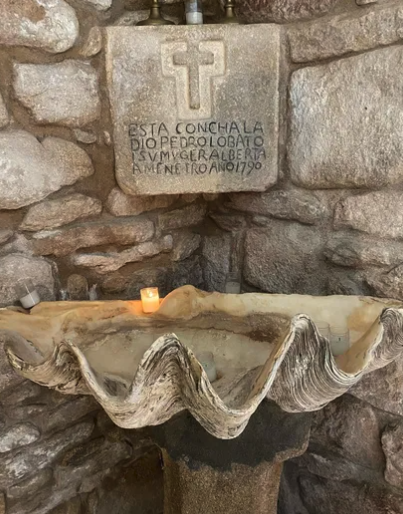 Shell font in church on Portuguese Camino route. Photo by Imogen Clark
Shell font in church on Portuguese Camino route. Photo by Imogen Clark
Jo Frances Penn: You mentioned that you went with your husband. Were you with a bigger group as well?
Imogen Clark: We weren’t but you kind of are because there are so many people.
John and I went together as a couple, but immediately we got off the plane and there was a group of ladies who were catching our bus, and John said, ‘I bet they’re doing it as well,’ and I went and spoke to them, and lo and behold. And then we kept seeing them at various places, and we bumped in…there were lots of people who you see in their custom that they’ll have a day off, and then they’ll restart, and you’ll meet up with them further down the track.
And it’s because everybody is going as I said, in the same direction, at the same time. It is like walking in a group and you bump into people who you maybe only see at lunchtime, but then you then see them in the evening, not to speak to particularly, but they’re sitting outside a bar or whatever. So there’s lots and lots of opportunity to speak to strangers as well as being with the person that you’re actually with, so it was…even though that we were only two…and everybody felt like we were only two because there were just so many people.
Jo Frances Penn: Well, that’s really interesting because when I did the…in fact, both the Pilgrims’ Way and the Cuthbert’s Way, I had whole days on my own, walking on the path.
And I have heard this about the Camino and I’m doing a slightly different Portuguese route. And for the listeners, as we record this, I have not yet walked my Camino, and I will also be doing the Portuguese route.
But this is something that in a way slightly worries me because I like walking alone, and yet I feel that that is respected, but do you have to be rude to people? You know, I’m English at the end of the day, so we have subtext. And often people of different cultures don’t appreciate body language or subtext that says I want to be on my own.
Were there ways of having solitude or being alone, even with so many people on the way?
Imogen Clark: Yes. I think so. And I think you sort of get into the habit of saying, ‘Buen Camino,’ as you walk past everybody. I walk quite fast, I’d say we walked past a lot of people that we overtook everybody.
But you always speak to them as you’re going past, but there’s no necessity for it to be more than that. And so many people were walking on their own. It was really…I think more people were walking on their own than were walking in groups. So it’s definitely something that is respected.
And there were parts we took a different route, a variant in Portugal. And that bit was really, really quiet because it was off the main Camino. And the Portuguese route is more quiet than the Spanish route, so there were places where there were not other people.
And where we were up on the hills, John and I, we didn’t see anybody for hours, and hours, and hours. But in other places, it did feel a bit like a motorway. And there were just…took me by surprise…I hadn’t realized it was quite such an industry.
You have to collect your stamps in your passport as you’re going along to prove that you walked the requisite distance. And there’re so many cafes with the shell, which is the sign of the Camino outside, and bars, and churches, and places where you can go to get your passport stamped. And I hadn’t really realized that there was a whole industry around the Camino in that part of Spain, but everything is set up around this pilgrimage, and all these people constantly coming through. I think it’s between 500 and 1000 people finish every day.
It’s so many walkers, so many pilgrims. That surprised me. I wasn’t quite prepared for that quantity of people.
Jo Frances Penn: And so what time of year did you walk? Because that might give people a bit of a clue as well.
Imogen Clark: We did it in May, and the reason why that part of the world is so green is because it’s a bit damp. So we had I think more wet days than dry days, but it wasn’t cold and it was fine. I was expecting it to be wet. And apparently, it is busy most of the time, it gets very busy in the summer when it’s not wet, but then it would be extremely hot.
And the route that we did, it was quite hilly some of it, and some of the days are quite long. So I think if you were doing it in the height of summer unless you are used to walking in those kind of temperatures, I think it would be quite challenging.
Jo Frances Penn: I’m doing it in September, which I guess will be similar to May.
Imogen Clark: It should be drier, I think.
Jo Frances Penn: Yeah. Hopefully a little bit.
Tell us about some of the highlights of the route for you. What were the places that you were like, ‘Yes, that was brilliant,’ or just lovely, or beautiful, or whatever you remember as a highlight?
Imogen Clark: There’s so many beautiful places and so many tiny, tiny little churches and chapels that you kind of would not have noticed if you hadn’t been going slowly, and thinking about, and looking out for shells, and all those kinds of things.
And inside some of these tiny little chapels, they got the most beautiful artwork, and fabulous frescos, and things and you just think, ‘Well, where on earth did the money come to provide for this tiny little chapel, but there it is.
And crosses everywhere all the way along, very, very ancient stone crosses that were just gorgeous.
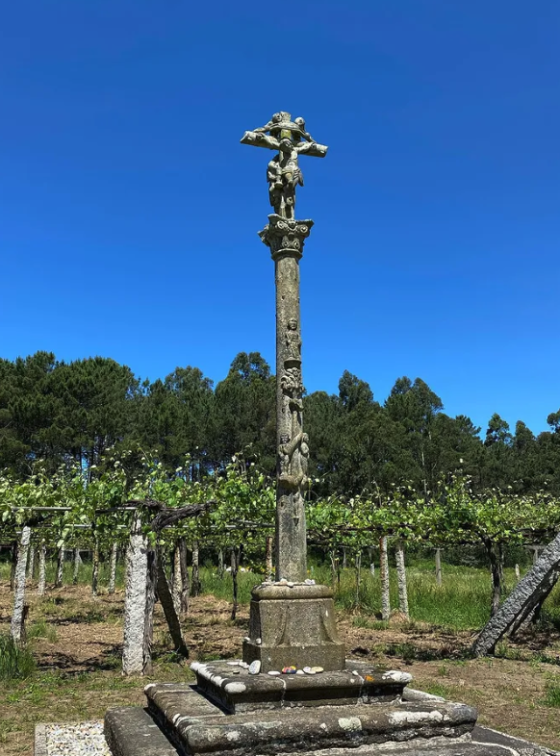 Stone cross on the Camino. Photo by Imogen Clark
Stone cross on the Camino. Photo by Imogen Clark
But places-wise…so we passed through this fishing village called Combarro, which was absolutely beautiful, and picturesque, and very much like sort of a Cornish fishing village.
And one of the things that they have in that part of the world are these huge stone grain stores that they built, I think really to keep the grain away from rodents, and bats, and what have you. But they’re everywhere, and they’re absolutely huge, and beautiful, and all the way along the coastal path were all these stone grain stores. And I’ve never seen them before, and so they were so interesting and so lovely.
And I think we saw various churches within the towns that we passed. Obviously, the cathedral in Santiago itself is breathtakingly beautiful. I’ve been in a lot of cathedrals but I have never seen anything like the shrine to St. James. It makes you want to cry, it’s so beautiful. And so that was so lovely when we reached that point.
We passed through a little church where a local fisherman had pulled up a huge seashell, and he’d given it to the church, and the church was using it for the holy water by the door. And those little things, those tiny, tiny little churches with these little stories attached to them, those were the kinds of things that really stayed with me as I was walking.
We went to one chapel where there were some people inside who were evangelists, and they wanted to sing and celebrate our walk. And then when they’d done that, they said, ‘Oh, that chap on the bench outside,’ he said, ‘He’s 97, and he rebuilt this chapel. Him and his son rebuilt it because it had fallen down.’ And so they rebuilt it, and now he just sits on the bench outside and watches all the pilgrims come past. And it was just such a lovely, lovely story, such a human side to the walk. And it’s those kinds of things that stayed with me really, the human bits.
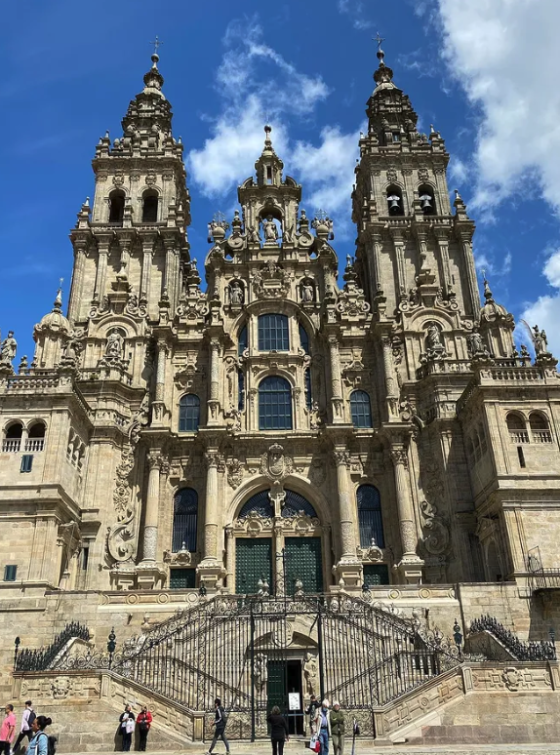 The Santiago de Compostela cathedral Basilica. Photo by Imogen Clark
The Santiago de Compostela cathedral Basilica. Photo by Imogen Clark
Jo Frances Penn: And you’ve mentioned hills and I guess, some of the landscape.
This was the coastal route, right? Were you by the sea at any point?
Imogen Clark: Yes. There were bits by the sea. I think it is very varied. There were lots and lots of bits by water, but rivers, there was one particular part that the path of stone and water, which was a path that ran beside this…more of a stream than a river really, but all the way along there were mills where they milled all the grain and everything for the bread.
And just on this tiny little path, there was so much stone because they needed the drops of the water to make the mills work. And then these beautiful, tiny, tiny little mills, every 300 or 400 yards. That was just so pretty. The dappled light, absolutely lovely.
And then one day we were walking up a hill, it was quite, quite steep…and I’m from Yorkshire I can do hills, but it was quite steep, but it was a eucalyptus plantation so you can imagine, the smell was fabulous. And the path had been made from…I think there must have been crushed oyster shells in it because it had the tiny little mother of pearly bits that you get inside oyster shells on the floor. And those were all reflecting light and making the floor shimmer beneath you, and this smell, and the heat, and walking up the hill.
And then we get to the top and just, the trees cut away, and we got opened up this beautiful vista, and then we were looking down over this bay of the coast obviously. And that was a breathtaking moment as well because it’d been a trudge to get up this hill and it was hot. And then we got to the top and suddenly, we were rewarded with this spectacular view. And it was full of moments like that, where it was hard and then suddenly something beautiful would happen and you think, ‘Okay,’ so yeah, it was worth working 10 miles up that hill to get to this view, things like that really I think, all the way along.
Jo Frances Penn: I have a really practical question, and I do think this is important. So, some people wear heavy walking boots. So for example, walking in Yorkshire in October, November, you’re going to wear some chunky walking boots, right? But I’ve seen people walking these Camino paths in just more like walking shoes, like, light walking shoes or even sandals.
What kind of footwear do you think you needed for that route?
Imogen Clark: Well, I wear track shoes that they run in. So when you see these people who do…well, the Ultras, I know you’ve done Ultras as well. And the people who run the Ultras, who wear these very, very light with very thick soles, running shoes. And so that’s what I wear because they’re so light and they’re so comfortable.
And I think you don’t need big boots because obviously, it’s Spain and it’s hot. But also at no point was the path particularly muddy, or any of the things that I would need boots for. And people were walking in all kinds of things. I saw one girl, she inspired me to write a character actually because she was so lovely. She’d got pink hair, and she just had a tote bag, and she’d a scarf hanging around her hips, and she was walking in flip-flops.
And I thought, ‘Look at her,’ she’s one of those devil-may-care kind of, ‘I’ll just turn up and it’ll be fine,’ kind of people. And you could see everything about her just from the way that she was dressed. And she stood out a mile because she was so…she looked so different to everybody else who…there were a lot of people with khaki and creases from the packets still in them. There were a lot of people who clearly didn’t do a lot of walking, but just had bought new things specifically to do the Camino, so she was like a breath of fresh air with the flip-flops. I wouldn’t recommend doing the flip-flops —
Jo Frances Penn: I was going to say!
Imogen Clark: You need some decent boots, yeah. I mean, a couple of the days were sort of between 15 and 20 miles, 3 or 4 of the days were between 15 and 20 miles. And at the end of the day, it’s not to be taken lightly because even if you do a lot of walking, walking consecutive days with those kinds of mileage, it can be hard on the hips, and the shoulders, and everything. So yes, you do need to make sure you’ve got a kit that suits what it is that you’re trying to do.
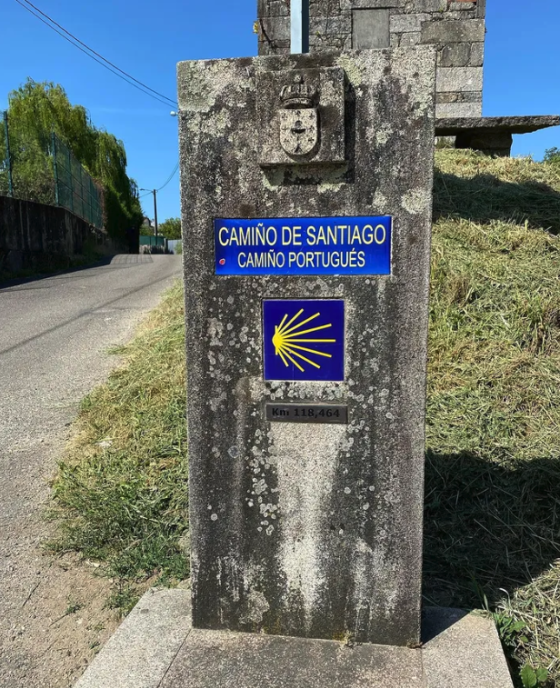 Camino waymarker, Photo by Imogen Clark
Camino waymarker, Photo by Imogen Clark
Jo Frances Penn: That is good. And then I guess another practical question as well, in terms of finding water, and food, and toilets, like you said, it’s an industry.
Was it always easy to find places for those water and food?
Imogen Clark: Not always. It’s the great outdoors so there aren’t always toilets, but there are little bars all the way along the route. But sometimes the bars were quite spaced out and often you didn’t get to the places where the bars were at a time that was a meal time.
And also I get up very early in the morning, and I go to bed quite early, and I’m very morning-focused. And my body clock was completely at odds with the Spanish body clock. So, the Spanish time, they start much later, and we couldn’t even get breakfast before half past eight, which is like, ‘Oh my goodness me.’
Now, I’m normally up with a lark, and then things close in the afternoon. So we learned to be quite creative making sure that we had got enough to drink, and eat, and everything for that gap between sort of 2 and 7 when everything was shut. So you do have to be quite well organized I think, and not just assume that you’ll stumble across the most perfect tapas bar at exactly the right moment because it doesn’t always happen.
Jo Frances Penn: Yeah. I actually thought about moving to Spain in the ’90s and it was the same reason. I was like, ‘I cannot live in this country where they eat dinner so late,’ and I’m like you, I get up early and I go to bed early and it just didn’t suit me.
Imogen Clark: Yes. And my husband said, ‘Imogen, you can’t expect them to change their entire way of life because you are here.’ But obviously yeah, but we were there 10 days, we got used to it, I got used to it by the end. But yes, it’s quite a big switch of your body clock, I think, to be able to eat very late and yeah, get to bed late.
Jo Frances Penn: As we mentioned, pilgrimages are not meant to be easy. And you mentioned there some of the long days, some pain in your hips, and your shoulders.
What were some of your greatest challenges along the way?
Imogen Clark: As I mentioned before, I walk very quickly and my husband does not. And so that was quite a challenge because even though that sounds a bit trite, actually I really had to focus on slowing down so that I wasn’t just doing this for myself.
We were there as a pair and it was important that we were together and my temptation is to go much faster than him. And he would say, ‘It’s not a race,’ and I would say, ‘Well, I’m not racing. I’m just walking at my normal speed.’ We had this ongoing debate that my normal speed was not normal and his normal speed was closer to normal and I needed to slow down, so that was quite a challenge for me.
Also, I think you have to put aside your wish to stop and look at absolutely everything because the focus is on the actual pilgrimage. And I’m like you, if there’s a little path that goes off somewhere else, I’m likely to be on it just to see where it goes and all those kinds of things.
And I had to pull back from doing those kinds of things because I had to remember that I was supposed to be on the pilgrimage, and I was following this path for a reason, and there was a reason why I had to go this way and not any other way, so that was something else that I had to do.
As far as it being a physical challenge, I think if we’d gone further…we only did the last 120 kilometers, if we’d gone further obviously, that would’ve been more difficult and because we’re middle-aged people, we were staying in nice hotels and not backpacking.
And so, we didn’t make it that difficult for ourselves because there was always a hotel at the end, and we weren’t carrying our kit. So I think there were ways in which it would be much harder, I think, than the way that I actually did it.
But it is getting up and doing the same thing every day. That requires a degree of mental fortitude I think. And sometimes when it is very hot, or it is very wet, or all those kind of things, you’re gonna say, ‘This is supposed to be fun,’ well, yes, it is fun, you’re enjoying it, but, you know, it’s hard and you have to just keep pressing on, you’ve got to get to a particular point because that’s where you’re resting that night. And so yes, it’s not easy. It’s not for the faint-hearted.
Jo Frances Penn: I think that it’s Type 2 fun. It’s not fun at the time, but it might be fun if you look back at it later.
But also, like you mentioned there, you stayed in hotels and you didn’t carry your bags, but to me, the whole point, or one of the points of the Camino is that it’s your Camino.
And so there is absolutely no problem staying in hotels or having your bags ported from one place to the next. It’s your Camino, whatever you want it to be, and you choose your challenge, and I think that’s the important thing.
And I don’t think there should be any judgment for how people do it, I mean, like you were celebrating that girl who was in flip-flops, you know, my immediate thought was, ‘There’s no way she made it to Santiago,’ you know what I mean? But it’s, like, her Camino, who knows her Camino might’ve only been a couple of days. And so I think that’s really important too.
So you must’ve met people who had just completely different attitudes, I mean, she was obviously one of them but, I mean, you do pick characters for your books as you said.
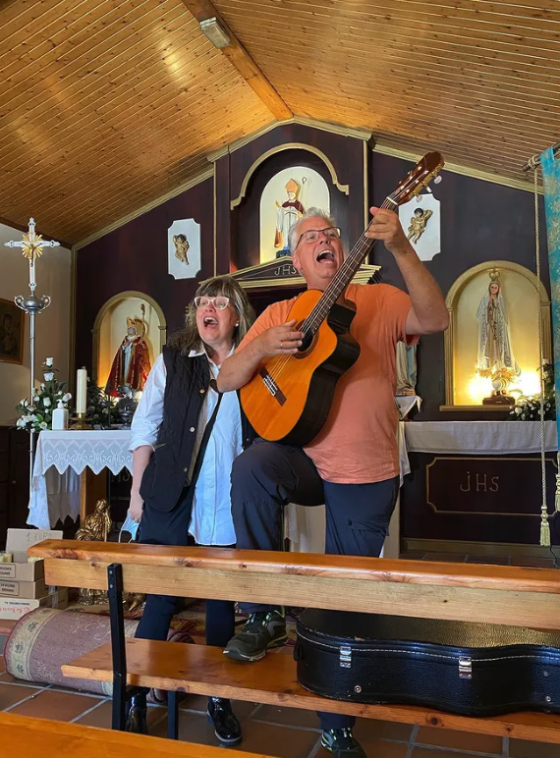 Singing for the pilgrims on the Camino. Photo by Imogen Clark
Singing for the pilgrims on the Camino. Photo by Imogen Clark
Were there any other interesting characters?
Imogen Clark: Yes. We met one chap, and he had this conversation as you’re going along with people that you meet, ‘What’s your motivation? Why are you here?’ And he said that he was there because he had triplet boys and he was the main carer. His wife went out to work and he had worked a lot from home.
And he said, ‘I’m here because I need them to know that they can live, they can do it without me.’ And I thought that was really interesting. The thing that was motivating him to be able to do this walk was just to show that he wasn’t as indispensable as his family thought.
So, in a kind of a roundabout kind of way, what he was getting from his Camino was all about showing them that he was able to have the freedom and their lives wouldn’t collapse if he wasn’t there. And I thought that was interesting that that was the way that he was approaching it.
Jo Frances Penn: Well, that actually means a lot, you saying that, because weirdly, that is one of the reasons I do this because, we’re both authors, and I run my own business and have done for nearly 15 years, and I rarely ever take a day off, like, a whole day off in terms of not making sure things are ticking over on the business, like emails or whatever I’m doing.
And when I do these pilgrimages, I remember that I am not indispensable. And this is such an amazing lesson that I have to keep learning.
And what I’m hoping to learn again on the Camino is that life carries on. Like, you don’t need to check social media; you don’t need to do email. No one’s going to die if an author doesn’t email a reader back, right?
Imogen Clark: Absolutely. But I think we lose sight of that, don’t we?
Because we’re so busy, and everything is also very important, and it’s very easy to lose sight of what the important things are. And it’s like I said in the very beginning that, it’s a simple thing, so simple is walking. It’s putting one foot in front of another until you get to the place you need to be.
And it’s that simplicity I think, that is the magic of doing something like this because you just…there’s no point getting caught up in all that other stuff because like you said, it doesn’t really matter. There’s very little that won’t wait until you get back. And once you get your head around that that’s what you’re doing, it’s liberating, it really is to just not look at your phone every five seconds. It’s fab, I loved it. I really enjoyed that aspect of it.
Jo Frances Penn: Exactly.
So, I found that the gifts of pilgrimage didn’t really emerge at the time, as in I was almost frustrated that I wasn’t having this moment of spiritual awakening in somehow, but later on things emerged.
It’s been a few months now for you. What are some of the things that have emerged since you’ve been back?
Imogen Clark: I think that’s absolutely true.
I also had this idea that there would be lightning bolts and all amazing thoughts, I’d have all these moments as I was walking along, none of which happened. I did have a couple of moments where I got quite emotional when we saw things that were so beautiful, but really…and I also had this idea that we would walk into Santiago, and it would be glorious, and shining…there would be a big gang, and it would all, you know, just there’d be..not necessarily with these people, but just in all moving together.
And as it turned out, it was a wet, cold, gray day. And the Portuguese route comes in through the city, it’s not a very nice part of the city, and all those visions I had of my beautiful arriving at the end of my pilgrimage were all completely rubbish and none of that happened.
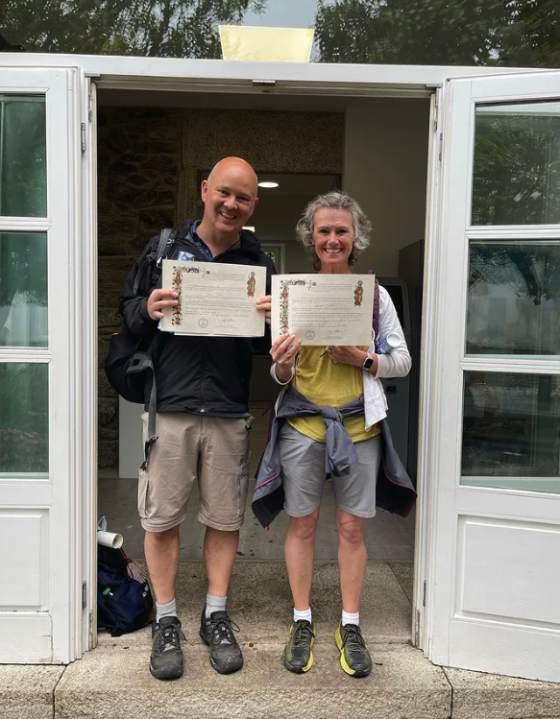 Imogen Clark and her husband finish the Camino de Santiago. Photo by Imogen Clark
Imogen Clark and her husband finish the Camino de Santiago. Photo by Imogen Clark
So it did feel like a little…not an anti-climax because we had walked all that long way, but it wasn’t as I had envisaged it. So I completely agree that it isn’t quite what you think when you’re there.
But coming away, I’ve had a meditation practice for a number of years now, and I find that that helps me to focus and what have you, but since I’ve done the pilgrimage, I feel calmer, it does sound a bit silly, but I do feel like my busy life…the busy life that we have as authors, and just people, everybody’s busy, aren’t they? I’ve been able to focus more on the things that are actually important instead of getting caught up in the, ‘Oh, that email came in five seconds ago, and I need to respond to it otherwise they’ll think I’m not interested or whatever.’
I’ve let all those things go I think, and I’m sure they will build up again because of course, these things always do, don’t they? But certainly, since I got back, those are the things that I found easier to just sort of go, ‘Do you know what? That actually doesn’t matter, let’s reevaluate our priorities here.’
The important thing about this is to breathe, or to take time out and go and look at that view, or to not necessarily sit at your desk answering all these emails so you can tick them all off, and get to the end of the day with that smug, satisfied, ‘I’ve done all my tick list,’ because those things whilst they are of course important, they’re not always important, and they’re not always the priority.
And being able to take time out, and think about wider issues as I did when I was walking along, that’s the kind of thing that I think I’ve taken away. And also, I think I’ve also… I have a hunger for it now. I’ve very much enjoyed that sense of common purpose and the simplicity of it all.
And so I imagine that I will do another, I haven’t chosen which yet but I imagine that that will be something else that I do.
It’s very difficult to put into words exactly what it gives you but it most definitely does give you something that you didn’t have before. And as a seeker and as a curious person, I will be seeking that again, I think.
Jo Frances Penn: Indeed.
Well, you mentioned though that you had some emotional moments rather than lightning bolts, and sometimes these sort of quiet realizations or glimpses of…I always say something beyond the veil, or the veil is thin in this place, where even if you don’t believe in a Christian God or any kind of religious God, there is still something there.
Did you find those quiet moments of spirituality along the way?
Imogen Clark: Yes. I think so. And I wasn’t really expecting that, it took me by surprise because I was expecting for it to be a spiritual experience, but I wasn’t expecting it to reduce me to tears, and so I was quite surprised.
And there were two or three places, the little chapel I mentioned where the lovely American couple were playing the guitars and singing to all the pilgrims, they were so lovely and so welcoming. And there’s something…I think something very evocative about singing, I think it hits all kinds of emotional notes for me.
I felt like they were there, and they were making time for me because I was a pilgrim, and they didn’t know me from Adam, and they never met me, and I would be gone, and they would be gone to the next pilgrim who came through the door. But in that very moment, I felt like they were wanting to impart something specifically to me. And that was quite moving really I think.
Then obviously, there’re lots of very beautiful, natural moments, you know, as I’ve described and those are awe-inspiring often. And particularly, when you’re focused on taking the time to actually look, because a lot of the time…you know, I live in Yorkshire Dales, it’s absolutely beautiful, but some days I don’t even look because I’m busy.
So you need to be able to be somewhere and notice the smell of eucalyptus trees or notice that the floor is made up of little bits of oyster shell or whatever. Those can be very special moments.
And I think when we got to Santiago, we were very fortunate because it happened to be one of the days when they were swinging the Botafumeiro, which is the giant incense thing that they have there.
And it takes eight people to swing it, it’s so huge. It’s like a wrecking ball, it’s amazing to see. And the cathedral was packed, partly because they have a service for the pilgrims every day. But that was even more packed because the Botafumeiro was going to be swung that day as well. And that common purpose again used to be in a building with all these people who had all just done exactly the same thing as I had done.
That was a moving moment as well because that’s what it is to be human, and I think we sometimes forget. And particularly, post-COVID, and all that kind of stuff, we’re all very cautious of each other. And we’re all dancing around, and not standing too close, and being concerned if somebody looks as if they might cough, and all those kinds of things. And suddenly, there were all these people, all in one place, and that wasn’t what they were interested in at all, and they were really interested in this beautiful building that we were in. So that was very moving as well, possibly as I said because it’s been so long since we’ve had moments like that, but it was beautiful.
Jo Frances Penn: It’s funny that Botafumeiro, I used that in Stone of Fire as a plot device.
Imogen Clark: Oh, it’s fantastic. Have you seen it?
Jo Frances Penn: I haven’t. No, I haven’t. I’ve only on YouTube videos, but I haven’t seen it. So I’m going to put it out there to the universe that it’s being swung when I get there because I’d love to see it.
Imogen Clark: Absolutely. That’s exactly what I did. And lo and behold, it worked. So yeah, if you get to see it, it’s spectacular, it’s astounding. I’ve never seen anything quite like it, so when you are there, go see it.
Jo Frances Penn: Brilliant. Well, we’re almost out of time, but this is the ‘Books and Travel’ podcast.

What are some of your favorite books about pilgrimage, or routes, or travel in general?
Imogen Clark: Well, as I mentioned, I quite like books where people just set off. There’s something very interesting about just setting off my own first book. It was inspired by me wanting to run away because having four children is sometimes quite challenging, and I just wanted to just, ‘I’ll just go and get on a plane and fly somewhere else,’ so it’s that kind of thing with the books that I’ve chosen.
The first one is ‘Wild’ by Cheryl Strayed. She walked 1100 miles along the Pacific Crest Trail, and they made a film about it.
But the thing that I really enjoyed about that book is she was so woefully ill-prepared when she set off, her boots didn’t even fit. She had absolutely no idea. She had a bag that she could barely lift. She had just no idea where she was going. She hadn’t got the appropriate kit or anything, and yet she just set off, and more astoundingly, she finished.
I think the strength of the determination and the strength of personality that that must’ve taken her just not to give up. And she was on her own for days, and days, and days, and various points in quite a lot of jeopardy, no water, and a lot of snow, and all kinds of interesting things. So I find that book really inspiring, not just for long-distance walking, but also for anything that’s a challenge really, and just that whole resilience, don’t give up thing, and because I find that she was amazing, it’s an amazing book.
My second one is, ‘As I Walked Out One Midsummer Morning’ by Laurie Lee, which I first read at school. And I’m sure that’s why I have this thing about just setting off because that’s what he does. He sets off with his fiddle, and his backpack, and he decides to go to London, and then he ends up in Spain. He ends up in a bit of the, you know, where there are Camino-goers at one point as well.
I think by nature, I’m a planner, and I always…there’s always a plan. And I think I’m inspired and awestruck by people who don’t have a plan because it’s so alien to my personality. So for him to just decide that that’s what he was going to do, and make his own money by playing the fiddle, and staying where he could stay, and just meeting interesting people, he gets caught up in the Spanish Civil War towards the end, so it gets a bit hairy. But the beginning bit is so…and it’s because it’s Laurie Lee is so beautifully written. So that’s the second one.
And then for some fiction, The Unlikely Pilgrimage of Harold Fry Rachel Joyce, because he decides…he sets off to post a letter and then decides actually he’d rather take it in person. And so he walks the length…England to take this letter. And obviously, he’s just set off, and he has the wrong shoes, and the wrong…no money and anything with him. And his wife doesn’t understand, but he’s just drawn by, ‘Actually, I want to see this person rather than just send the letter, I want to actually see her.’ And she’s not very well, the lady that he’s writing to, and so there’s the ticking-tock element, he has to get there before she dies. But again, Rachel Joyce writes beautiful fiction, and it’s a beautiful story. So those are my three choices.
Jo Frances Penn: Brilliant. And you mentioned that your first book had these kind of elements, but you didn’t tell us the name of the book, so tell us that.
Imogen Clark: Yeah. ‘Postcards from a Stranger’ was my first book that was published…not the first book I’ve written, but it was the first book that was published. And it was inspired by me wondering what kind of mum would leave her children, and what would be so awful, that would mean that she had to do that. And yeah, having that thought then led into the book, which then led into my career. So yeah, it’s an important book to me is that one ‘Postcards from a Stranger.’
Jo Frances Penn: Fantastic. Right, so where can people find you and your books online?
Imogen Clark: imogenclark.com is my website, which has links into everything else. Then I’m on Facebook and Instagram as Imogen Clark Author, so I’m quite easy to find really. And obviously, all over Amazon and everywhere.
Jo Frances Penn: Brilliant. Thanks so much for your time, Imogen. That was great.
Imogen Clark: Thank you for having me. It’s been lovely.
The post A Yearning for Setting Off. Walking The Camino De Santiago Portuguese Route With Imogen Clark appeared first on Books And Travel.
21 July 2022, 12:10 am - 38 minutes 3 secondsMomentary Encounters That Bring A Journey To Life With Nick Jubber
Hello travellers, I’m Jo Frances Penn, and in this episode, I’m talking to Nick Jubber about the momentary encounters that bring a journey to life.
We talk about how religion weaves its way into travel, especially in the middle east and north Africa, and how sometimes we can sense the intensity of faith, even when we are not religious ourselves. Nick talks about the nomadic life and the attraction of desert places, finding the roots of fairy tales across Europe, and how travel is changing, even while our desire to explore remains.

Nicholas Jubber is the award-winning author of five travel books, including Epic Continent and The Timbuktu School of Nomads. His latest book is The Fairy Tellers: A Journey Into the Secret History of Fairy Tales.
Show notes
- How religion winds its way into Nick’s travel writing
- Discovering spiritual moments and meaning even if not religious
- The romance vs. the reality of the desert
- Lessons learned from nomadic life in the desert
- Assessing risk and safety while traveling
- Finding the roots of fairy tale in Europe
- How travel might change in the future
- Recommended travel books
You can find Nick at NickJubber.com
Transcript of the interview
Jo: Nicholas Jubber is the award-winning author of five travel books, including Epic Continent and The Timbuktu School of Nomads. His latest book is The Fairy Tellers: A Journey Into the Secret History of Fairy Tales. Welcome, Nick.
Nicholas: Oh, thanks, Joanna. Thanks very much for having me on the show.
Jo: I’m excited to talk to you about lots of things. Let’s start with the latest book. So, a quote from The Fairy Tellers:
“Grow up in suburbia, and either you tend to stick it out, or you spend your life looking for ways to flee those privet hedges and cul-de-sacs.”
I read that line, and I was like, ‘Oh, yeah.’ Tell us a bit more about you, and how you became a travel writer from that background.
Nicholas: I grew up in a very typical middle-class kind of lifestyle. I think that there was this part of me that wanted to break out of there. I think that, for me, travel is often driven by a combination of a sort of escapism and curiosity.
I think that from growing up in the cul-de-sac, and then I went to a boarding school run by monks. And then I worked after university in a job where I was working with a lot of filing cabinets and doing Excel spreadsheets. I was utterly bored out of my mind, and constantly reading about faraway places.
Then an opportunity came to teach in Jerusalem, at a school in the Old City of Jerusalem. And I thought ‘That would just be fantastic.’ So, I went along there and sort of carried on traveling really ever since.
It was a fascinating time to be in Jerusalem. The intifada had broken out. It was a terrible time. There was fighting on the streets. But there was a real sense of history in the making, and debate about what was going on and the world, as we were moving into the 21st century. So, a sense of a really exciting time to be traveling in that particular region in the Middle East.
That led me to traveling to different places around there, Jordan, Syria, Egypt, all the way down to Ethiopia, which ended up in my first book, The Prester Quest. And then from there, more journeys.
As soon as you start traveling, you see different places that you want to go to. And I think, ‘Oh, I want to go to Iran now. I want to go to Afghanistan. I want to go to Central Asia. I want to go to India.’ And so it just snowballed on and on from there.
Jo: Yeah. Absolutely. And it’s so interesting, because we have had some overlap. We were both at Oxford… Similar, like, one year overlap, I think we came up with. I think we also may have been in Jerusalem at a similar time.
Nicholas: Oh, wow. Really? Yeah.
Jo: Because I also worked out in Jerusalem and, well, the West Bank as well, during the intifada times. Of course, there’s been multiple intifadas.
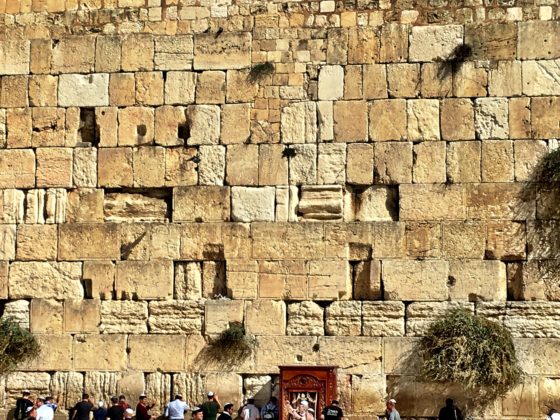 Western Wall, Jerusalem, Israel. Photo by J.F. Penn
Western Wall, Jerusalem, Israel. Photo by J.F. Penn
Let’s get into The Prester Quest and then come back to The Fairy Tellers, because I’m fascinated by this myth of Prester John, and it, as you say, it goes into Africa and around the Middle East. And also you said you went to boarding school run by monks.
How has religion underpinned your travels, and wound its way into your writing?
Nicholas: I suppose I grew up in quite a religious household, Irish Catholic background. And going to church was something that was very much part of my life. At the same time, because I went to a school run by monks, and there were as with many of those schools, that led to various issues and scandals.
So, I’m very aware of the flaws of religion, as well as its power. I have quite an ambiguous relationship with that. And I think, actually, going to Jerusalem really exacerbated that, because you see the incredible power that religion has on people, and its ability to join people together, but also obviously to split people apart.
When you’d see the violence and the vindictiveness with which people treated each other because of their religion, and continue to do so, that can be really, really horrifying.
The number of times in the West Bank, or in Jerusalem, or in Bethlehem, wherever that I suddenly have my eyes stung by tear gas, or even be hit by stones, and see these battles going on, with very young people. I was working in a school, and we’d have kids coming into school suddenly on crutches or with wounds.
They’d come out with all sorts of excuses. They’d say, ‘I fell down the stairs, sir,’ and all that kind of rubbish, but we all knew that they’d been out fighting in the intifada, because they wanted to take part in that. And that was not just religious. It’s to do with nationalism and to do with all sorts of issues. But obviously, religion in that part of the world plays a very key role.
Jo: I’d love to travel in Iran. One of my impressions is that we might think there’s religious fundamentalism, which, of course, there is, but there’s also this sort of openness, and there’s loads of other religions in a country like Iran.
I watched a documentary on the Christian community, but also, you’ve got all kinds of really interesting things going on. And so often, it’s stereotypes of these countries that come up when we talk about religion.
How have you explored beyond those religious stereotypes in your books?
Nicholas: Iran was a fascinating one because obviously there’s this very monolithic impression that is often given to the outside world of Iran. And then you get in there and you find this incredible hospitality, and that comes out partly of Islam and partly of other beliefs as well, and other traditions.
There’s the Zoroastrian faith there in Yazd, and I found it fascinating to meet some of the Zoroastrians and to hear about how that religion continues, and how a lot of younger people in Iran, even if they’ve been brought up as Muslims, feel a connection to that old, the old Iranian faith.
But also you mentioned the Christians. I remember having a lovely time when I was in Isfahan. I’d been in Iran for quite a while, and I guess I hadn’t had an alcoholic drink for a while. And then suddenly, an Armenian Christian invited me to come into his compound, where they were brewing their own arak, and invited me to sit down, and I have a very hazy memory of the rest of that day, but I remember it being tremendously warmhearted and feeling very welcomed.
Really, throughout Iran, I felt this tremendous sense of welcome. And people say, there’s a phrase where they say that the guest is second to God. So, it does come out of that religious belief. At the same time, you’d also see the sort of the oppression with which religion was used against people, and how people’s lives and opportunities were being stifled by it.
I met a lot of people, especially a lot of poets, and painters, and actors, who would be fighting against the mullahs’ regime, and fighting against that very blanketing, oppressive form of Islam, and try to celebrate life, which in itself was a form, in Iran, can be a form of rebellion. And that was really, really uplifting, actually.
Then that traveled into going to Afghanistan as well, and meeting people with various backgrounds, and I remember spending time amongst the Sufis of Herat when they were performing the zikr, where they’re reciting the name of God very quickly and repetitively, to connect themselves with God. I was really enchanted by the humility, and the power of faith that some people had there, especially people who are living in really fraught and tense and difficult circumstances.
Sometimes faith could be the thing that I guess helps people through. I found that myself traveling in Afghanistan, that my faith suddenly started increasing enormously, as I found myself going into places like Helmand and those more dangerous places. I’d suddenly start praying again, as I hadn’t really for many years, which, admittedly, was probably quite superficial, but it’s to do with that sense of danger around you, and wanting some kind of branch that you can hold onto.
Jo: I’m always fascinated by religion versus faith, what you’re saying there, but also spiritual moments. I’m not a Christian. I don’t believe in any particular religion myself. But I have had these spiritual moments, where I’m just suddenly aware that there is more than just our physical world, there is something else, and places where I feel like spiritual intensity is strong.
That might be in a man-made environment, like amazing architecture, but also in nature. So, I wondered, given that you said there you were praying in that moment, but it doesn’t sound so much a spiritual moment.
Are there places that you’ve been on your travels where you’ve thought, ‘Yes. This means something, in some way?’
Nicholas: Absolutely. It’s often actually when you get away from the crowd. I think sometimes there can be these sort of wonderful moments where you take part in a religious ceremony.
In places like Jerusalem or Rome. When you’re in Rome and the pope’s giving his blessing, it does feel wonderful to be part of this big crowd. But actually, I’m not sure if that’s necessarily spiritual. I think it’s often when you’re in, I’ve found, when I’ve been on my own somewhere.
I remember being in the Ruins of Ani, which is in southeast Turkey, on the Armenian border, and it’s an old sort of medieval Armenian town. There are these beautiful churches, with rocket-shaped steeples. And you’d walk into them, and there are these medieval frescos that have survived. They’re quite pale and peeling away.
Lots of holes in the roofs, and the wildlife has half reclaimed the architecture. And standing there, seeing the light coming through these holes in the roof, and feeling yourself just alone with the vision of the medieval painters, and seeing the biblical stories told through these medieval painters, that sense of transcendence, that you’re almost traveling through some kind of wormhole back in time.
I think those are the kind of moments where I felt really a kind of a sense of connection, a sense of something spiritual.
Or another example I think would be in Iceland. There’s a place called the Arctic Henge, which has been built actually just in the last few years in Raufarhöfn in the Arctic Circle, very north of Iceland. It’s a giant sundial surrounded by columns and pillars. They’ve got the names of various figures from the Edda, from the old Nordic mythology, inscribed on some of these stones.
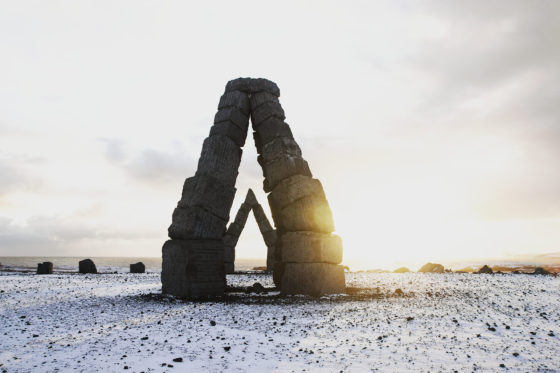 Arctic Henge, Raufarhofn, North Iceland. Photo licensed from BigStockPhoto
Arctic Henge, Raufarhofn, North Iceland. Photo licensed from BigStockPhoto
That sense of being in this very isolated place, it’s a very cold place, and having that place, not so much having that place to yourself, but being alone with that place. I think also that sometimes in these places, even if you’re on your own, there’s a sense of emotional connection with anybody else who has been there and has felt something there, that these places are often, they’re sort of repositories of people’s feelings.
We connect, I think, with other people’s emotions who have come there before us, or maybe are even going to come there after us. And that sense that these are places where we’re coming for a common purpose.
Jo: I agree with you. I feel like there are places that just so many people have felt something that it’s just become imprinted into the environment somehow.
You mentioned there the isolation, but I also like insignificance. I feel like travel makes us feel insignificant in a good way. Like, everything’s not so important, because I’m just this tiny speck on the world.
And you write about the desert, which I love.
I enjoyed The Timbuktu School for Nomads. I still remember first seeing the Sahara from the cockpit of a 747 as we flew to live in Malawi when I was a child. And that’s one of my first memories is the desert. Of course, they don’t let children in the cockpit of planes anymore.
Nicholas: You got to go into the cockpit? That must have been great.
Jo: It was. It was 1982 or something. And back then, you could smoke on a plane, let alone just wander around. But you’ve traveled in the Sahara, and it feels like there’s this romantic view, which I definitely have. I don’t want to live in the desert, for sure.
What’s the romance of the desert for you? And what’s the reality?
Nicholas: I had this wonderful romantic vision of the desert. And I knew that it was an illusion. So I wanted to find out the truth of it, really.
I’d grown up with all those wonderful films like ‘Lawrence of Arabia.’ I had the images of the desert from Star Wars movies. So, I was very aware that that was an idealized and romanticized image. I was really curious to know what is it like for the people who actually live in the desert?
That was really the spur for The Timbuktu School for Nomads. When I went out there, inevitably, I found that it is just so much more complicated. I loved the wildness, the danger, the sense that you are very much at one with nature. There are no safety nets.
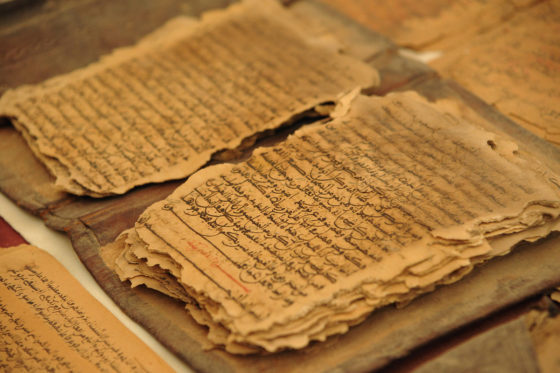 Old Koranic manuscripts deposited in the mosque of Timbuktu, Photo licensed from BigStockPhoto
Old Koranic manuscripts deposited in the mosque of Timbuktu, Photo licensed from BigStockPhoto
At the same time, the discipline of survival, being amongst nomadic people, and just seeing the amount of craft, and skill, and technique that they have, and the absolute necessity of following those techniques all the time, really, is quite regimental. It’s almost like a military life.
But at the same time, there’s wonderful camaraderie, when you sit around the campfire, when you’ve walked for hours across this very hard desert, the heat baking your back, and then finally you get to sit down and you will slump and build this fire. And there’d often be these wonderful traditions around, rituals around the tea-making, which I think, as a Brit, I really connected with. So, you have this sort of very complicated process of tea-making.
I remember the pride I felt when I learned to make the tea myself. And they said, ‘Yes, you’ve done it right this time, at last.’ I grew to really admire and respect some of the nomads who I traveled with. It’s a very austere life. And it’s not for everybody.
I think that was one of the things I learned as well, was that there are people who thrive in that life, but there are people who don’t. You see the people who want to get away from that life, and sometimes aren’t able to, and sometimes they do, and then sometimes they come back. Life’s complicated.
So, it was really interesting to see all that complexity, and to see the many different ways in which people live in the desert as well. I traveled amongst camel herders, but also amongst people who keep goats or cattle, and then also in different parts of that area of North Africa, amongst people who go fishing on the Niger River as well. So, there was a range of lifestyles. I found all that really fascinating.
Jo: And, of course, it says ‘School for Nomads,’ and you include lessons in it.
Jo: When you came away, what sticks in your mind as the main thing you learned for yourself and your own personal development out of the desert and the nomad life?
Nicholas: I learned a lot about that sort of focus, really, of when you’re traveling, you have to keep your eye on the prize, know exactly what you want to do. I think that a lot of the nomads who make their lifestyle work, they’re not distracted. They’re very disciplined, and they’re very focused on exactly whatever their task is, whatever they need to do.
I really learned to admire them for the way they strip out the complex, too much of the distractions and annoyances, and make sure that they’re very targeted. I learned a lot about being with people, actually.
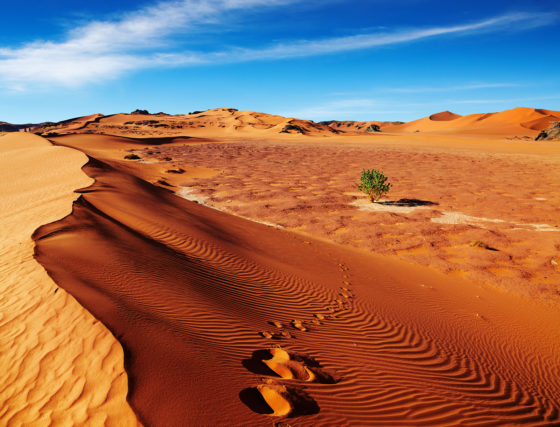 Single tree in Sahara Desert. Photo licensed from BigStockPhoto
Single tree in Sahara Desert. Photo licensed from BigStockPhoto
One of the things I love with traveling, really, is meeting people who have all sorts of different ways of life. I’ve often not found it easy to necessarily sit down and just do the sort of chitter-chatter that actually is really very much a part of nomadic life. You get to the end of your day or your night, sometimes you’ll be walking at night, and then it will be around dawn and you eventually rest. And you sit around and relish each other’s company. I think that was probably my most abiding memory of that experience.
Jo: And then, the city of Timbuktu, because I feel like the name is so evocative of myth and legend.
But what is Timbuktu really like?
Nicholas: Oh, it’s an amazing place, and then an incredibly downtrodden place, in so many ways. It’s very much a city on the edge. Its fame really is because it’s between the Sahara and Sub-Sahara, and the world of the river and the desert come together there. And so it was this great sort of trading melting pot.
But it had moments in history where it was quite wealthy. Mansa Musa, the wealthiest man in history, ruled over there at one point. I visited there several times, actually, both before and after it had been invaded by the Islamic Jihad group. It was really heartbreaking to see what happened to the city and what the people of the city went through.
When I came back the last time and I met people who had horrific stories. So, the city had been through a real trauma, and it was a little bit broken, I think. But I was also really amazed by the resilience of the people.
One of the people I met was a man called Abdel Kader Haidara, who was a librarian, who had been involved in very much a pivotal role in organizing the movement of manuscripts out of Timbuktu. They have these amazing medieval manuscripts, which go into all kinds of subjects, not just religious subjects, but also pharmacology, and astronomy, and all kinds of the wonderful range of subjects that medieval scholarship produced.
A lot of these books they knew would be targeted by the jihadist, so they moved them all, and got them onto the river, and moved them out, 370,000 manuscripts, which they managed to transport to Bamako. So, it was amazing to hear some of these stories of how people had survived and how they had managed to endure, and their defiance.
One of my most wonderful memories in Timbuktu was going to a wedding party, going on the back of a friend’s motorbike. We just sped through the alleys to this little house on a back alley. And the light suddenly flaring around us, everybody out dancing, wonderful headdresses and coiffures, and the joy of music and dance, and that sense of a city that was coming out of a terrible time, and was determined to celebrate life and to enjoy it as much as they could.
I think that’s always going to be my most sort of poignant and abiding memory of that amazing city.
Jo: I’ve read that book, The Book Smugglers of Timbuktu. That’s a great book about exactly what you’re talking about, about getting the manuscripts out of the city. And, again, I think we have these stereotypes of places.
I had no idea before reading that book that there were these manuscripts there. And I think often people don’t know, for example, that Ethiopia had this incredibly powerful civilization, and rich civilization.
It’s interesting, isn’t it, how we come up against these modern stereotypes of things because of media, and then we have to break those down when we travel.
Nicholas: Absolutely. Africa has particularly been very badly served by Western historians, scholarship, and media. I think that we have this blindness really to the richness of the continent.
You mentioned Ethiopia. The richness of Ethiopian culture is one of the reasons why the myth of Prester John connected with Ethiopia. When I was traveling in the wake of the Prester John legend, that Ethiopia was my ultimate destination, going to this amazing town called Lalibela, where they have these rock-cut churches. It’s absolutely architectural gem.
And, as you say, they have these amazing manuscripts and incredible texts and versions of biblical stories. And there’s a huge, a huge richness of culture, which is really fascinating to delve into.
Jo: You mentioned Lalibela there. I wanted to go to Ethiopia. I’ve written about the Ark of the Covenant in one of my novels, Ark of Blood, and they have something that could be the Ark, in Ethiopia.
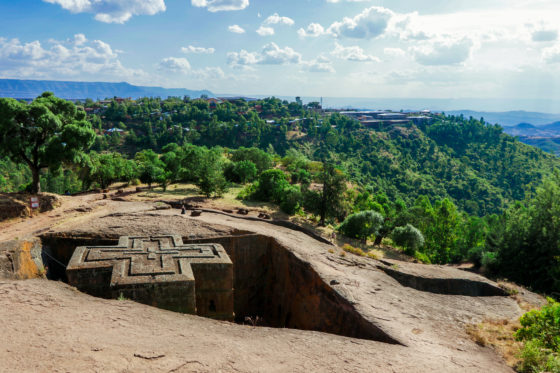 Church of Saint George, Lalibela, Ethiopia. Photo licensed from BigStockPhoto
Church of Saint George, Lalibela, Ethiopia. Photo licensed from BigStockPhoto
Nicholas: Yeah. They say they have it.
Jo: But it’s interesting because when I looked at going, there was quite a lot of violence going on. You’ve mentioned some of the dangers of travel. I mainly travel as a solo woman. And so I’m pretty careful about the things I do.
So, I couldn’t see myself traveling with necessarily a nomadic tribe in the Sahara. I necessarily wouldn’t feel safe that way. I wonder how you assess your risk, your personal risk, both how you used to, when you were a single young man, but now you have a family.
How has your assessment of risk changed now you have a family? And do we overestimate risk with travel?
Nicholas: It’s tricky. I think everybody has to to do your research, really. I think you have to do your due diligence, and look into it as much as possible.
I think probably the two scariest places I’ve traveled to are Afghanistan and Mali, and particularly when Mali was going through a war. So, I obviously did a lot of research, and made contact with a lot of people.
But there is always that leap of faith where you’ve just gotta go, and hope that everything works out, and trust in the kindness of strangers, that people will be hopefully, hospitable to you.
I think it’s partly about trying to learn as much of the local languages, as much about the local culture, and really just trying to show people that you’re there in good faith, that you’re not there to prospect for oil or to find diamonds, but you’re there because you love their culture, and want to learn more about it. I found that that could be really helpful.
But at the same time, there are bad people everywhere. And fortunately, there are very good people as well. And I guess that in traveling, I’ve been lucky enough to mostly come across the good people.
I’ve definitely had my moments where it has felt very dangerous. Obviously, we’re traveling with children. Those are not places that I would take my children. And so, the journeys that we do as a family are very different. They’re very chaotic in their own way, I guess. They don’t have the same spontaneity that those solo travels can have.
Jo: And I think that’s, what, I got the impression that The Fairy Tellers was also partly because of your family. You went on a family trip and got an idea that way, is that right?
Nicholas: Yes. We’ve done quite a bit of traveling as a family, so it’s really good to shake ideas up and see different places. And obviously, fairy tales are something that’s come out for me of telling fairy tales to my children. So, just seeing their reactions to different fairy tales has been really instructive, and seeing how different characters in fairy tales really connect with them.
And it’s amazing, I think, when you look at some of these fairy tales that go back for hundreds of years, and the fact that children still respond to them in very, often very, very interactive and often very surprising ways.
Jo: I’m super fascinated in the darkness of real fairy tales. I feel like we clean a lot of them up now. But if you actually read some of them, they are pretty dark, aren’t they?
Tell us about some of the darker fairy tales that were fascinating.
Nicholas: They’re so grisly. The further back you go, if you go back to the original, some of the original versions, then they seem to get darker and darker. The Grimms’ Fairy Tales, obviously, are very famous, and they’ve been really watered down and cleaned up, as you say, by Disney, especially. But you go back to the original versions it all gets much more violent.
An example would be the ‘Snow White and The Seven Dwarfs,’ a classic tale. In the original version, the queen isn’t Snow White’s stepmother, she’s her own mother. And she wants Snow White to be killed so that she could eat her heart and her organs, and therefore absorb her beauty. So, it’s pretty sickening, really. Pretty horrific.
And you find that in so many of these stories. It’s part of what makes them so exciting to read in these earlier versions. That’s the startling horror of them.
Jo: I totally agree. I think that we try and shield children from darkness. But equally, those stories are important for the darkness, because the world is dark in many ways. But the sort of good tends to overcome evil in the end, which is why I particularly am attracted to reading horror and darker stories, because I like good to triumph over the bad stuff, I guess.
Nicholas: Well, don’t read too much of Hans Christian Andersen then, he has sad endings.
Jo: In The Fairy Tellers, again, I’ve got another quote here. You say,
“Stories are cooked in specific places. However universal the ingredients, the recipe carries a local flavor.”
Which, again, there are some stories that repeat themselves over places. What were some of the places and stories you thought particularly stood out in the travels for this book?
Nicholas: One of my favorite journeys I did for this one was going to Lapland, and I traveled in the world of Hans Christian Andersen. I went to Denmark and I visited his home in Odense. It was amazing to see the poverty that he grew up in, and then how he became this wonderfully popular and beloved author.
All my life, really loved his story of the Snow Queen. I’ve loved that idea of the story of the girl who sets out to rescue her friend, to bring her friend back home. And so, I traveled to Lapland in the wake of that story, and I stayed in a snow castle, actually, that gets built annually on the Bothnian Gulf, in Kemi.
I met reindeer herders as well, and went out on the snowmobile to the glades where the reindeer are herded, and saw the challenges of the life of reindeer herding. I was really, really enjoyed that aspect of connecting that story and that particular storyteller with those places, and that very sort of Scandinavian, very Nordic world, very cold, obviously, in the very, very particular climate and seeing how that story grew out of that climate, which was really, really fun and really exciting to witness.
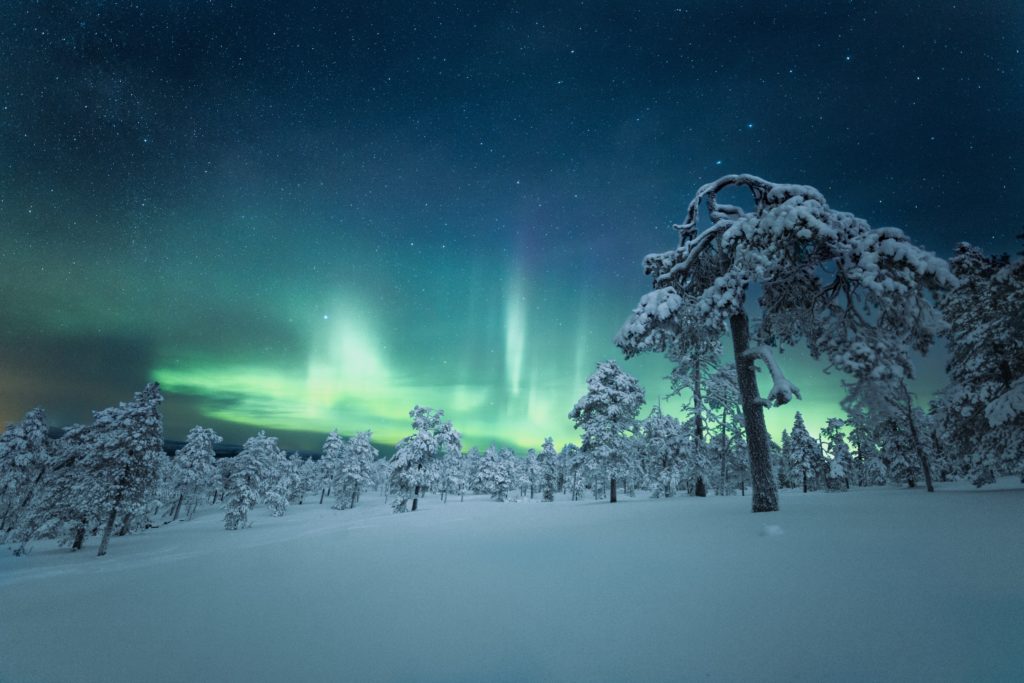 Lapland, Photo by Maria Vojtovicova on Unsplash
Lapland, Photo by Maria Vojtovicova on Unsplash
Jo: What about European cities? Because you talk a lot about the places that are not so busy. But I feel like Europe, in particular, our history and our present is so dense in some great cities that have been around for so long.
Were there any stories that you found in particular cities?
Nicholas: Naples is really connected with our earliest fairy tale collection, actually the ‘Tale of Tales,’ which was set down in the 17th century by a brilliant storyteller called Giambattista Basile. And he was an adventuring courtier poet, who traveled from one court to another. His sister was the greatest diva in opera of the time, and she sang for Monteverdi, the great composer, composed music for her.
She sang for the Dukes of Mantua, and he followed her coattails and he found himself in different courts in Avellino, in Mantua, and ended up in Giugliano, then Mount Vesuvius erupted and he caught a lung infection and died. So, he had a very rambunctious life. He was a soldier in Crete at one point, fighting against the Ottoman Turks.
But he also collected stories, and he collected the earliest version of Cinderella in Europe, or the earliest full version, where she’s Cenerentola, the earliest full version that we have of Rapunzel, versions of ‘Sleeping Beauty,’ and many other very famous stories. And he lives a lot of his life in Naples.
He brings out his love of Naples, but also his sort of complex relationship with Naples as a very loud and noisy, chaotic city. It was the most popular city in Europe of the time. So, he brings out the wonderful lines where he talks about, ‘Beloved Naples. I love the city.’ But then there’s also a lot of bitterness about the corruption of the courts, lines about people’s hopes all being sent to the winds.
Often, you have to go out from the courts, out from the cities, into the forest, where the ogres live. In a lot of the Italian tales, the forests are populated by ogres, especially. And the ogres often are the wisest people around. They’re the ones who are often pointing at the cities and the courts and saying, ‘Oh, they’re all hypocrites there. It’s out here that everybody’s honest.’ It really brings out that wonderful sense of that contrast between courtly life and rural life.
Jo: That’s so interesting. I agree with that. We talked about risk earlier. I had one of those experiences in Naples where I felt very unsafe. It’s so funny, because you travel in all kinds of places and you feel fine, like you say, you meet nice people. It was in Naples where I was like, ‘Hmm, I am not happy right now.’
It doesn’t matter, does it, where we go. It depends on a situation. It depends on how we’re feeling. But, as you say, then I went out of the city and went into that countryside around there, and the volcano, and all of that. And it’s like, ‘Oh, I feel quite happy out here.’ So, tapping into that instinct, I think, is so important.
Nicholas: And that’s basically what the ogres would’ve warned you.
Jo: Yes. That’s what’s so funny. And that was written however long ago.
Nicholas: They would have told you that. ‘Don’t go into that city. Yeah, just stay out here in the forest with us.’
The landscape around Naples, the Campanian landscape, then going down into Basilicata, it’s really beautiful. And you have those sort of fumaroles of smoke coming out through the ground, wonderful forests, and obviously, orchards, and so much, very sort of fruitful area. I love Naples, but it’s a tricky city, isn’t it? It’s a complex city.
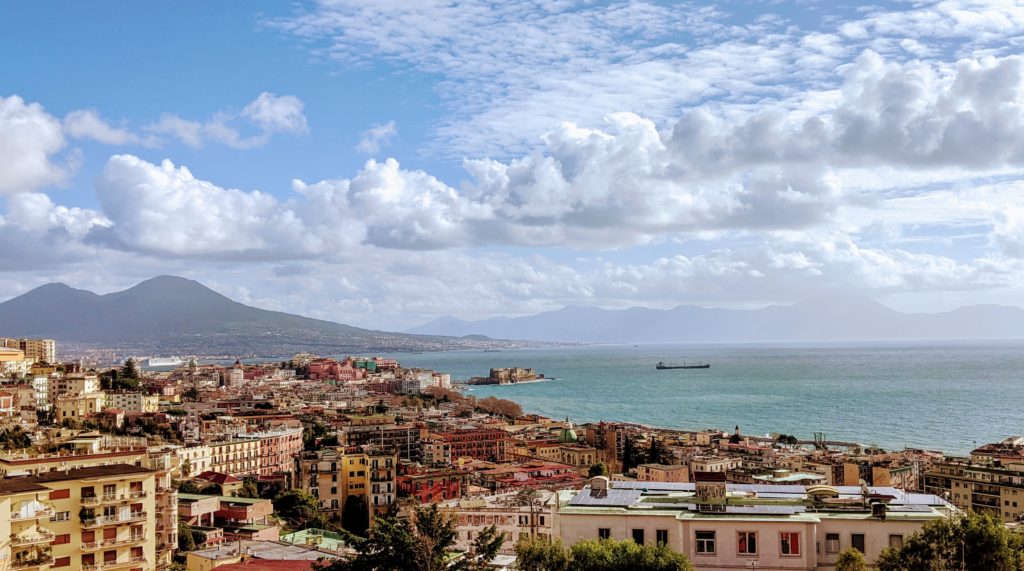 Naples, Italy. Photo by Danilo D’Agostino on Unsplash
Naples, Italy. Photo by Danilo D’Agostino on Unsplash
Jo: For sure. Coming back to children and thinking about the future, we live an interesting time, obviously, as we record this in the spring of 2022. We’ve come out of a pandemic when we haven’t been able to travel, and people like us want to get going again, but also we’ve got environmental pressures, we’ve got geopolitical things going on.
How do you think your children might travel in a different way to you? Or are you thinking about changing the way you travel as well?
Nicholas: I think for many years, I’ve been trying to, thinking a lot about sustainable travel, and it can often feel like a contradiction in terms. The most sustainable thing to do really is just to stay at home. But if you’ve got that travel itch, it’s really hard to break.
I think the main thing is that I’ve been practicing for many years, really, is trying to not fly as much as possible. But obviously, I think everybody has to work out their own version of what they consider to be an ethical way of traveling. And I think it’s mainly about an awareness of the opportunities that we have when we’re traveling, compared with what opportunities might be available to the people that we’re traveling amongst, issues of money, and what power that might give us over people who have less.
There are all those kinds of issues. I’m obviously not a prophet, so I just cannot really predict what travel will be like in the future. I hope my children will get to travel. That’s the main thing. I think the world is always changing.
I hope also that whatever they experience, it will be a different world, because the world is always different. Obviously, there’s a lot of things that if we look towards the future that can make us feel very worried, and think, ‘Oh, god, it’s going to be awful.’ And it does feel sometimes like it’s harder and harder to have a sort of authentically spontaneous journey in the way that you could in the past.
When I think of some of the journeys that I did in my 20s and early 30s, and it feels, even now like it’s getting harder and harder to do those. But on the other hand, there are places always opening up just as other places are closing down. So, even though you might not maybe consider a journey to Russia right now, on the other hand, there are places in the Far East that feel more open now than they have for a very long time, places in Latin America that feel like they’re more accessible now than they’ve been for quite a while.
There’s always opportunities in different areas, and it’s finding those places where you can travel and can have a really interesting experience, and connect with people.
And there are a lot of things that we can worry about about the world, but I think that possibility of connecting, which, for me, is probably the most important thing in travel.
That moment when you have an encounter with somebody along the way, and you really make a connection with them, and you may stay in touch afterwards, you may become friends on Facebook or Twitter or whatever. You may not. Anyway, it doesn’t matter. You have those sort of momentary encounters that can really make a journey come to life. I hope people will always be able to have that.
Jo: I think those of us who, as you say, have the itch to travel, have wanderlust in our soul, we’re never going to stop. We just can’t. And also, I feel like the world is more blessed because of that, and we getting to know each other. My family is all intermarried with different cultures and different religions, even. So, we’re a sort of United Nations family. And I feel that intermarriage is the way to bring world peace. That’s one of my missions.

What are a few travel books that you love and recommend?
Nicholas: If I was to go back to one of the ones that had the most formative influence on me, I guess it’s probably Wilfred Thesiger’s Arabian Sands, which I remember reading at the age of, oh god, what was it? Sort of 19, 20, and just thinking, ‘Wow. The idea that this was a true story, and that somebody had gone out and had such a deep connection with people in another place.’
Thesiger has been stereotyped over the years as a very austere and serious, sort of humorless man. But actually, the figure that comes out to me from that book is somebody who just really wanted to understand another place, and made friends with people there to the point where they all trusted each other in very dangerous circumstances. So, it’s a book that I admire hugely, and I really admire the depths to which he went to really, really understand the places that he traveled in.
A different note, I guess, would be something like Isabella Bird’s, A Lady’s Life in the Rocky Mountains, which is a classic of the 19th-century travel writing genre, and it’s very much, just like Thesiger, Isabella Bird is very much somebody of her time, but she’s also somebody outside of time.
The fact that she, as a lone woman, went off with a gun hidden in her dress and just rode across the Rocky Mountains and made friends with cowboys and all kinds of ne’er-do-wells, and had this confidence about her that she felt that she could do anything, and did. And it’s sort of a wonderful read. She’s a wonderful writer.
Another book that I found recently when I was researching about fairy tales was The Book of Travels by Hannā Diyāb. This is the account of an 18th-century Syrian traveler. It was actually only discovered quite recently by a French scholar, and only published a few years ago.
It’s the story of this young man from Syria, from Aleppo, who left Aleppo with a French archeologist called Paul Lucas, and traveled with him as his translator and his dragger man, across the Levant, and then into Africa. Eventually, they made their way up into Europe, into the court of the Sun King in Versailles, where Hannā presented a pair of desert jerboas at the court. He was this sort of exotic curiosity for a lot of the princes and princesses of the court.
He spent a long time in Paris. He lived through a period of famine, and had all sorts of adventures there, and eventually came back, rather unhappily, back home to Aleppo. And it’s the story of his journey. He calls it The Book of Travels and it’s just a fascinating insight into traveling from a non-Western perspective, from long ago, something that we don’t really have enough accounts like that.
He’s such a mercurial, such an honest, candid storyteller. He tells us about the things that he disagrees with. There’s one moment where he sees people begging outside of church, a soldier begging. And he’s very angry to see that until he’s warned off by one of the police, told, ‘I wonder, these people, are they given a military pension?’ But he feels a lot of sympathy for them.
Or there’s another moment where he’s upset to see slave galleys, having to row the galleys, and tries to complain about that as well. And he’s constantly coming up against injustices, and trying to speak out against them. So, it’s a very interesting multilayered account, I think.
Jo: Fantastic.
Where can people find you and your books online?
Nicholas: I have a website, which is www.nickjubber.com. And I’m also on Twitter, @jubberstravels, and on Instagram, @NickJubber.
Jo: Brilliant. Well, thanks so much for your time, Nick. That was great.
Nicholas: Oh, thank you. Thanks so much for having me on the show.
The post Momentary Encounters That Bring A Journey To Life With Nick Jubber appeared first on Books And Travel.
23 June 2022, 12:10 am - 31 minutes 15 secondsThoughts On Traveling To The USA Again Post Pandemic And Differences Between The US And UK Cultures
I’ve been traveling to the USA regularly since the mid-90s, for family trips and then business conferences and book research. The pandemic years meant a long hiatus (for us all!) but recently I went back to the US for my first trip in a long time and it felt quite foreign in many ways. I’d forgotten so much about how our cultures differ, and I thought it might be interesting to record my thoughts before I get used to it all again.
- Context and my history with the USA
- Flying again post-pandemic
- Arriving in Phoenix, Arizona, and some immediate differences
- Visiting the Desert Botanical Gardens, Phoenix, and a day trip to Sedona
- Other things I’d forgotten about the USA
I’d love to know what you think about our cultural differences, so please leave a comment, or tweet me @thecreativepenn or contact me here.
I traveled to Phoenix, Arizona, USA, from the UK for a week in early May 2022 for a business conference on the Creator Economy.
It was my first trip to the USA since restrictions have eased post-pandemic.
Covid hasn’t gone away, of course, but it’s certainly more manageable, at least as I record this a month later in early June 2022.
I have been on one other trip since restrictions eased, to New Zealand to visit family in November 2021. That was a far more significant journey in terms of travel time and we spent 10 days in quarantine and then couldn’t do much because of Covid, and it was for family reasons to a country I lived in for years and am a citizen of, so I’m not counting that trip as travel.
The USA is very different from the UK, perhaps even more so than I remembered since I’ve been away so long, and Arizona has a very different climate, so I wanted to record this episode while it’s all still fresh in my mind.
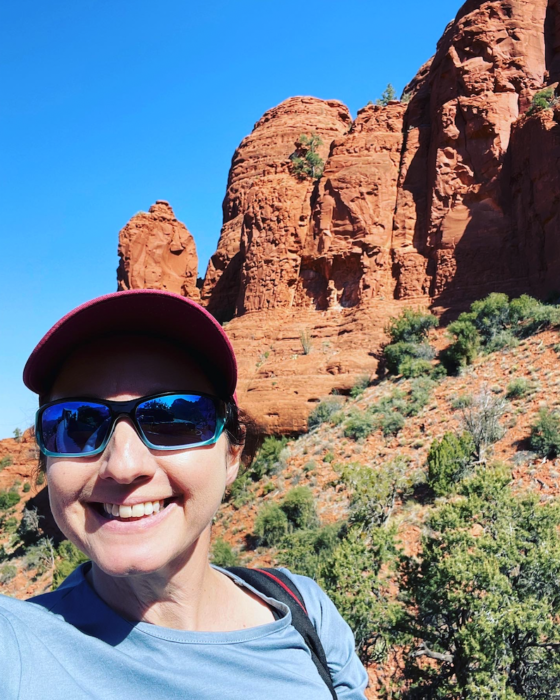 Author JF Penn in Sedona, Arizona, USA. May 2022
Author JF Penn in Sedona, Arizona, USA. May 2022
Context and my history with the USA
I’ve been traveling to the USA since the early 90s when my mum moved to Oregon and then San Diego, although she later moved to New Zealand to be closer to me in mid-2000s. Outside of those personal trips, I’ve mainly visited for work and conferences and blended those with other aspects of travel. I’ve been to New York City, Philadelphia, Chicago, Charleston and Savannah, St Petersburg, Florida, New Orleans, Austin, Denver, Tucson, Phoenix, Las Vegas, San Diego, San Francisco, Boise, and Portland, and some of those multiple times.
I am very at home in the USA, and think a lot of the country and its people. Many of my friends are American, many of my readers and audience and community are American, many of my financial investments are in USA companies, and I’m a user and a shareholder in some of the biggest American companies. I’m certainly a fan, in general, although every country has their problems and darker side, for sure.
The USA is also a huge country and places and people are so different between the states, so my comments are just a snapshot in time based on one particular place. I thought it might be interesting to consider our cultural differences as well as how it felt to travel again.
Flying again
While all pandemic restrictions are over here in the UK, I had to do a Covid test within 24 hours of flying to the USA. It’s the most expensive test to get as it’s rushed and you can’t check in until it’s done, so it certainly added stress to the pre-flight process.
I also had to complete extensive documentation on the Verifly app, which included documentation of my vaccinations, test result, and other forms along my with ESTA, which allows me entry after the US government check up on things. I’d forgotten how much paperwork traveling can take, and it has certainly increased since the pandemic, especially if you are not a citizen of the country you’re traveling to. Check what you need before you travel, even if you have traveled to that country before as it might have changed.
It’s a 10-hour direct flight from London to Phoenix on British Airways. After almost 28 hours to get to New Zealand, 10 hours was a breeze! The flight was fine, I watched some movies and read.
There is also now an American Express Centurion Lounge at Heathrow Terminal 3 so I spent time there after check-in. Frequent travelers in the USA will know the variability of these lounges, but this is a good one, especially in these quiet times before transatlantic travel picks up again. I kept my Amex business credit card specifically so I could use these lounges, and it’s always been worthwhile in the years I traveled more regularly to the USA. We also use the airpoints for Emirates flights to New Zealand. Gotta get those airpoints, somehow!
A few people wore masks at the airport, but not many. I wore mine in crowded areas, but it’s not a requirement in the airport or on the plane to and from the UK.
I’m triple-vaxxed and I’ve had Covid and I want to get on with life, so the prospect of catching it doesn’t worry me now, but certainly if you are concerned, then I would still avoid airports, for sure.
Arriving in Phoenix, Arizona, and some immediate differences
Phoenix is an amazing airport to fly into. The luggage trolleys have ‘America’s Friendliest Airport’ on them and it did feel like that. There were no queues and the customs officer smiled and welcomed me back to the USA. Having flown into JFK, O’Hare, and other big airports many times where you’re treated like a problem, it was a dream to arrive at such a lovely, small, welcoming airport.
 Phoenix Airport Trolley Photo by JFPenn
Phoenix Airport Trolley Photo by JFPenn
I got an Uber to the resort hotel and used Uber throughout the trip. I love being able to use the same app as I use back here in the UK and also in New Zealand. It has all my payment details, business and personal credit cards, my ratings, and saved places. I always ask Uber drivers whether they like the service and pretty much all of them are positive and say it’s their job on the side and they like the flexibility of being able to work when they want.
Cars are one of the biggest cultural differences I noticed this time, as it is essentially impossible to walk anywhere. Not just because of the heat, but mainly the lack of a safe way to walk. One morning, I needed to get about 15 mins walk away and had to get an Uber because of the highway. It wasn’t safe enough to walk.
The cars in the hotel resort carpark were also enormous. The height of some of the radiators were as tall as me. I have never even seen cars and trucks as big as these. Maybe that’s an Arizona thing. We have mostly small cars in the UK and Europe, because we live in smaller spaces, and we have to park on the roadside a lot of the time.
We also have walkable cities and use public transport a lot. We don’t have a car and I walk 8-10 kilometers most days, and longer when I actually ‘go for a walk,’ which is 20 kilometers along the canal on a Sunday morning.
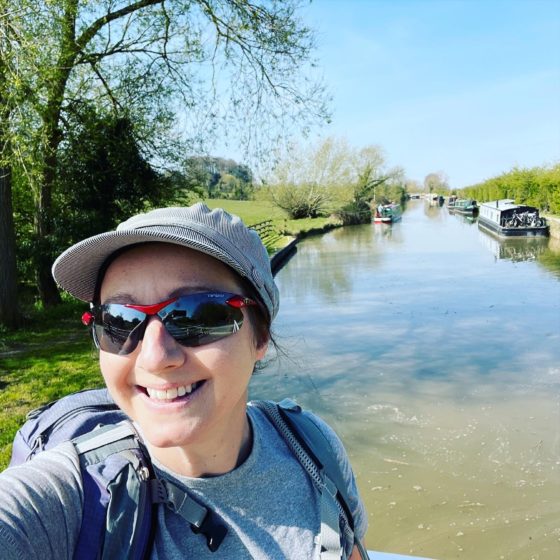 JF Penn walking on Kennet and Avon canal
JF Penn walking on Kennet and Avon canal
We also have a cafe culture so you can sit on the streets and a lot of the older city centers have pedestrianized spaces, so you can walk into town, sit and have a coffee and watch the world go by. One of my favorite simple pleasures is walking from my house to the cafe in front of the medieval Abbey and the Roman Baths and sitting there for a coffee and then walking home again. There are also three wonderful bookstores minutes from each other, which of course, I have to pop into, for research purposes of course!
The American coffee culture is a lot more functional. Grab caffeine and go, or just drive through. I sat in a Starbucks one day and wrote in my journal, and 99% of the people were in and out, no stopping.
I did visit the older part of Phoenix, but even the area with a few more shops was dominated by roads and cars. I was able to walk around in New Orleans, which is so European, but even in NYC and San Francisco in some areas, but the sense of just casually walking places seems to be missing in the USA, as it’s designed for cars. It was similar in Australia, which is modeled more on the US, whereas New Zealand is more like the UK.
The resort hotel for the conference was on the outskirts of Phoenix, and it was pretty much as you’d expect. There were acceptable options for food but most people had a car and went offsite. There was a golf course, a spa, and a water park, and the rooms were American-sized resort-style. It was lovely to see hummingbirds in the bushes around the golf course and the birdsong was beautiful when I walked around in the dawn.
Hotel rooms are almost always much bigger in the US, and the beds as well. Americans — and Australians — are often appalled at the size of hotel rooms in the UK and Europe, and our beds are never as big as yours. I also find the American toilets weird, as they have such a huge area of water. Ours are, once again, much smaller.
There was a Keurig coffee machine in the room which I appreciated — but this is another difference from the UK. We always have a kettle in the room and some tea bags, but rarely a coffee machine. You’ll get some sachets of instant, and in the more upmarket places, maybe a Nespresso pod machine. In the US, you get a coffee machine, and never a kettle, so I have to make peppermint tea with water heated up through the coffee machine, which makes it taste odd, but I do it anyway.
The time difference from the UK to Phoenix was 8 hours, so the jet lag was a pain. 6 pm in Phoenix was 2 am UK, so my evenings were written off as I was asleep early most nights. I get terrible jet lag and we can’t buy melatonin tablets here, so I didn’t have any with me, and didn’t get any for a few days. But I like being up early, so I woke up around 3 am most mornings and got some writing done before going for a walk in the dawn light. I managed to almost finish How to Write a Novel, my next non-fiction book, in the hours before the conference even started every morning.
When I did finally get some melatonin, I also bought one of your enormous packs of 200 Advil. This is another difference. Here in the UK, if you want painkillers, you can only buy the basic ones in packs of 16 or max 24, and if you want something stronger, you need to see the pharmacist. For us, ‘something stronger’ is what some Americans pop before breakfast!
When I visit, I always make a trip to a Walgreens or one of the big drugstores. They are a cornucopia of medical delights that we mostly can’t access here without a prescription. There are pros and cons to both approaches, of course!
I took my melatonin when I got back to the UK and it helped a lot with the reverse jetlag, so I was happy to get some at last.
Visiting the Desert Botanical Gardens, Phoenix, and a day trip to Sedona
I love the desert landscape of Arizona and visited back in the mid-90s when my mum lived in San Diego and I came over for a visit. We went to the Grand Canyon and Sedona back then and also visited the Biosphere between Phoenix and Tucson. The memory of that visit sticks with me to this day and I brought it to life in the climax of my thriller, Stone of Fire. You couldn’t really get an area more different from Bath in terms of climate, landscape, and culture.
I arrived a few days before the conference so I could have some desert time. I visited the Desert Botanical Garden in Phoenix, which is highly recommended if you love desert plants and cacti, in particular. Many were in flower and there were hummingbirds sipping at the nectar. We don’t have hummingbirds in the UK, so it felt very exotic as I walked through the gardens in the heat of the day.
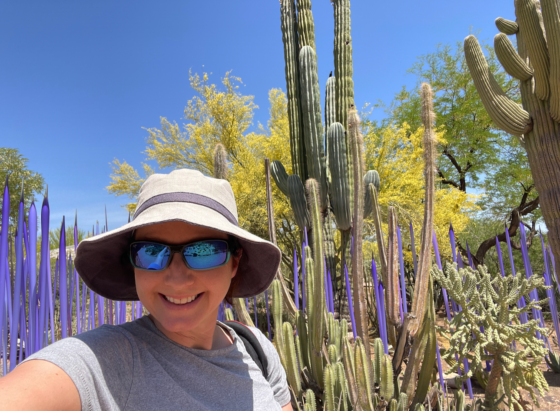 Author JF Penn at the Desert Botanical Gardens Phoenix, Arizona, USA, with Chihuly glass exhibit amongst the cacti
Author JF Penn at the Desert Botanical Gardens Phoenix, Arizona, USA, with Chihuly glass exhibit amongst the cacti
It was definitely too hot for me, like the hottest days in a UK summer heat wave. Not that hot for people who live there, but I should have gone earlier in the day. I had to take a break halfway through and sip an icy cold drink in the shade to cool down.
I wanted to see the saguaro cacti in particular, and many of them stand on a hillside in one part of the park. There was also an exhibition of Chihuly glass sculptures which echoed the lines of the cacti in different places.
Definitely recommended if you visit Phoenix.
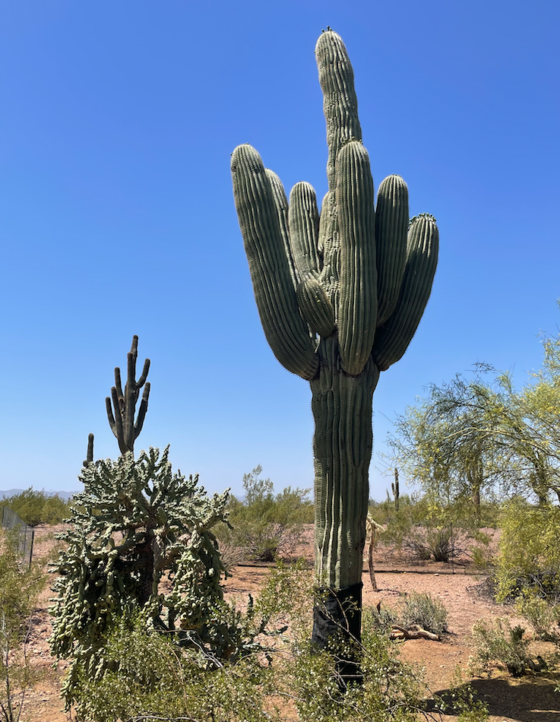 Saguaro cactus, Phoenix Arizona, USA. Photo by JF Penn
Saguaro cactus, Phoenix Arizona, USA. Photo by JF Penn
The next day I did a day trip to Sedona with Detours American West, which picked up and returned to a nearby resort. It was a well-organized trip and the driver/guide was friendly and helpful, stopped regularly enough for comfort breaks, and made the day out a good one. I would definitely travel with them again.
We started out at the Chapel of the Holy Cross, then visited Bell Rock, then a viewpoint with dramatic scenes of the red rock valleys and formations. I love the red rock landscape. Something about it resonates deep in my soul. I felt the same way in the red interior of Australia in the Northern Territory. That terracotta red is my favorite color.
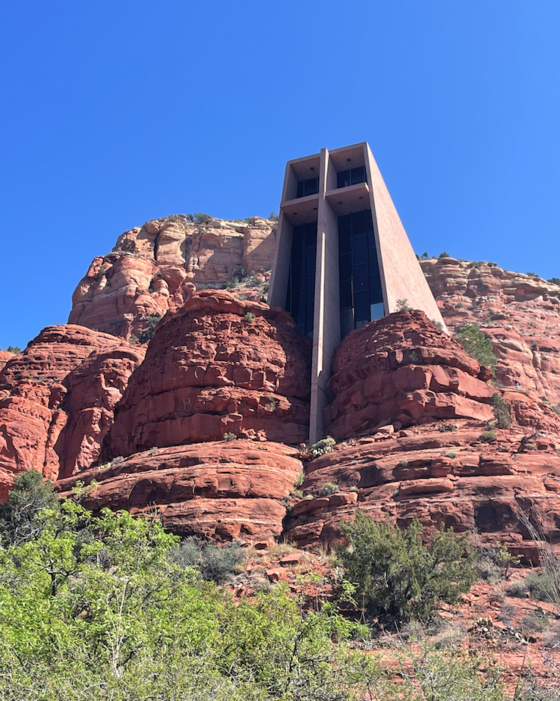 Chapel of Holy Cross, Sedona, Arizona, Photo by JF Penn
Chapel of Holy Cross, Sedona, Arizona, Photo by JF Penn
We had a few hours free in Sedona village, which is both super-touristy and full of tacky gifts, but also laid-back with good eating options and great views, if you find the right place to sit. I had a glass of chilled rosé (with a lot of water) and tacos overlooking the red rocks. If you go, definitely make sure you have a view with your lunch.
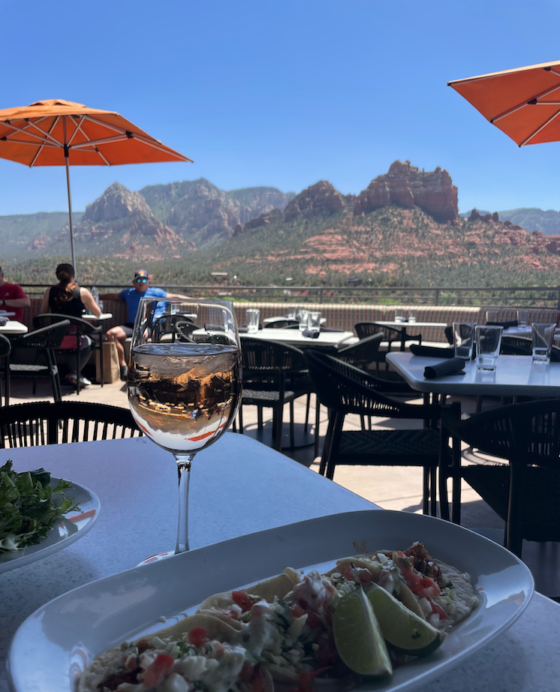 Lunch with a view in Sedona, Arizona, USA. Photo by JF Penn
Lunch with a view in Sedona, Arizona, USA. Photo by JF Penn
On the way back, we stopped at Montezuma’s Castle, which is nothing to do with Montezuma and is not a castle! It’s a simple Native American cliff dwelling from the Sinagua people, built between the 12th and 15th centuries.
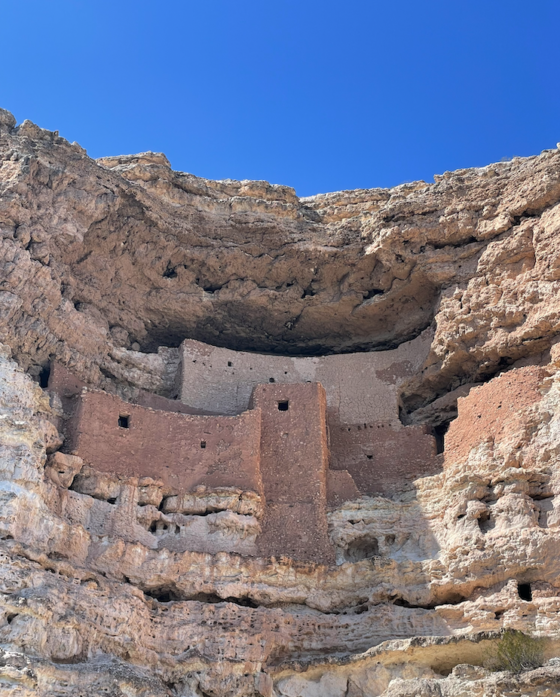 Montezumas Castle, Arizona, USA. Photo by JFPenn
Montezumas Castle, Arizona, USA. Photo by JFPenn
Visiting there with a bus full of Americans made me realize another big difference between our cultures. The UK and Europe are full of historical sites on a much grander scale. Perhaps we take them for granted, as they are everywhere. The Roman baths near where I live were built 60 years before Christ, 12 centuries before that cliff dwelling in Arizona, and the Abbey was established in the 7th century, and then the city developed from there. We consider ancient sites to be more like Stonehenge, which was built 5000 years ago, rather than 500.
This is one reason we moved back to England from Australia in 2011. I missed the rich historical, religious and cultural places that we almost trip over here in the UK, and I felt the same in Arizona. I love to visit the desert, but I need the human element of creativity, which results in architectural wonder, culture, and religion. For all our faults, we humans can create great beauty.
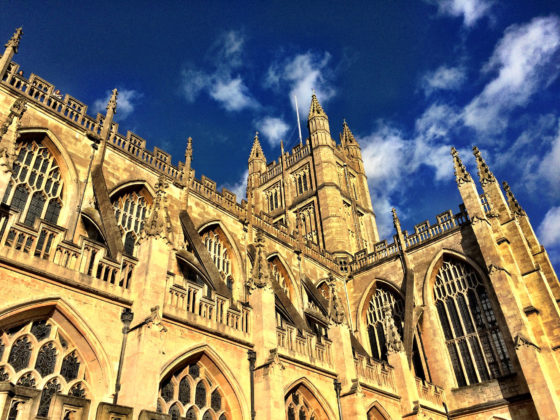 Bath Abbey, UK, Photo by JF Penn
Bath Abbey, UK, Photo by JF Penn
In terms of climate, Arizona is incredibly dry, and it’s easy to dehydrate. I drank lots of water but I found my skin dried out a lot, and even my eyeballs and my nasal passages got really dry. I used moisturizer and eye drops and nasal spray and also Vaseline in my nostrils, but even so, it’s a super dry climate. Drink a lot of water, even when sitting still.
Other things I’d forgotten about the USA
Prices of items in a store are always confusing. In the UK, the price quoted is the price including taxes, and tipping is for great service, not a necessity.
In the US, the price is quoted without taxes. So if it’s $5.99, you need more than $6 to pay for it. Plus, you need to tip everywhere, which also adds to the price. So it feels a lot more expensive and you never know how much you need if you’re paying cash, which is confusing.
Also, if you’re paying by card, the server walks away with it and processes it somewhere else. That does not happen in the UK, and if it does, we run after it as they might be skimming! We keep hold of the card and it’s processed at the table with handheld devices. I use my Apple Watch most of the time now, even in a restaurant, as they bring the device to the table. I hate seeing the server walk away with my card in the USA. It makes me so nervous!
The food is different here, too. Part of that is the sheer amount of it — both the portion sizes, but also the amount of choice in the USA. I went to an eggs place for breakfast and the menu was several pages of variations, although they didn’t have scrambled eggs and smoked salmon, which is my favorite brunch and common here. I’m sure it’s common in other places in the USA.
On portion size, we generally drink European size coffee in what Americans consider tiny cups.
The food is also a lot sweeter, there is sugar in everything, even unexpected things like bacon. Seriously, you don’t need maple syrup in your bacon! It’s good on its own.
It’s really hard to find food with no sugar in general, especially as a tourist with no car. My stomach is pretty much always upset when I come to the US. I was so sick in Savannah one time, based on eating some of that rich Southern cuisine, I had to go home. I was so miserable. It’s funny really, because some people worry about getting a stomach upset in places like India, but I cycled through south-west India for several weeks and put on five kilos because I ate so much delicious food and never had any problems. It’s about what you’re used to, I guess.
Of course, I know there’s also a lot of great food in the USA and if you have a car and you can shop at WholeFoods or local markets, there is a lot of great produce, but since I never have a car and am a tourist, I always find it difficult to eat simple food with no sugar.
Also, if you’re in the UK, you won’t need to ask for a box to go at the end of your meal. Firstly, because our portion sizes mean you will finish your plate, and secondly, it’s considered rude by most places. Perhaps that’s changing now with more Americans expecting it, but certainly I’ve been brought up to consider it the height of rudeness to ask for a ‘doggy bag.’
Other differences. The water was soft in Arizona, and my hair was lovely and soft too, after washing. Here in Bath, in the south-west of England, we have to use fabric softener for our clothes, lots of conditioner for our hair, and there’s limescale in the kettle which you have to clean out now and then.
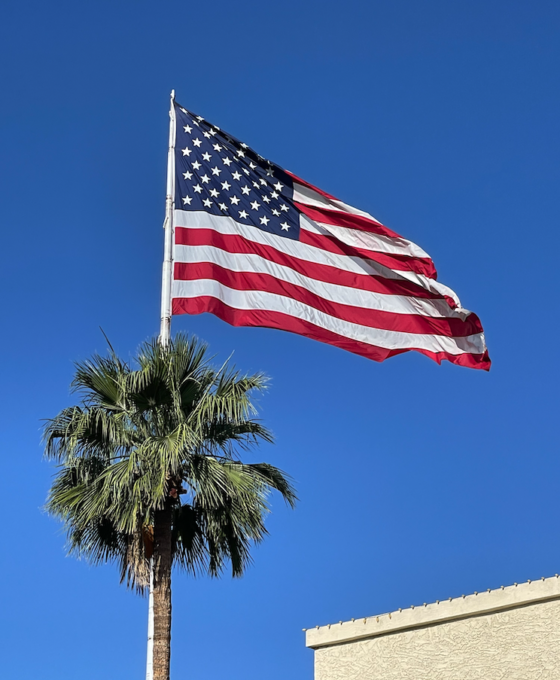 Huge USA flag, Phoenix Arizona. Photo by JF Penn
Huge USA flag, Phoenix Arizona. Photo by JF Penn
While I was there, the Roe vs Wade discussion started once more after a leak from the Supreme Court, and it brought up another distinction between our cultures. While we have plenty of people of faith in the UK, we don’t have overt religious discussions in the media or in government. In England, at least, abortion is about health. Religion is a completely separate thing.
Huge American flags also puzzle me. There was a massive one on the hill above the resort, the biggest one I have ever seen.
Very few British people would ever fly a Union Jack, even if they considered themselves patriotic. However, I’m recording this over the Queen’s Platinum Jubilee weekend in the UK, so there are union jacks everywhere. But they’ll all be gone on Monday after the event, for sure.
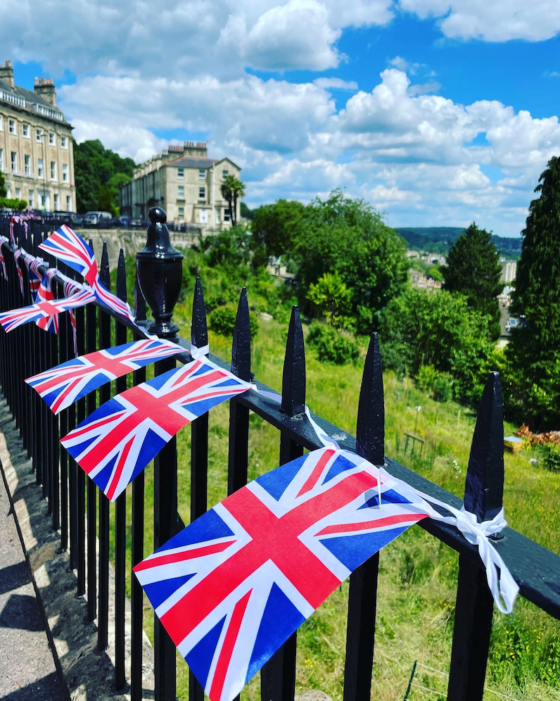 Jubilee Bunting, Bath, UK. Photo by JF Penn
Jubilee Bunting, Bath, UK. Photo by JF Penn
Although I’m comfortable in the USA, people comment on my accent, which is lovely and I’m happy that people like it, but it’s also a reminder that I am the ‘Other.’ I like that feeling when I’m traveling, although it’s usually much more intense when the language spoken is not English and I can’t understand signs or conversation around me.
Here in the UK, we have a class system and a hierarchy of accents, and we have a lot of accents in such a small place. In fact, we have hierarchies of everything, and that’s definitely less of an issue in the USA, or at least it seems that way. There is inequality, of course, but less hierarchy.
Communication styles are different too.
We rely on a lot of sub-text here in the UK. We might say something and mean something completely different, like “I’d love to catch up sometime,” might actually mean, “I never want to see you again.” It depends on the context, the body language, and other things which we can’t explain. Americans are much more direct and overtly cheerful. I have to amp my smile wattage up in the USA. We tend to avoid random conversations in England so we might seem unfriendly, but we’re nice if you get past the initial reserve, I promise!
It’s also funny to hang out with American friends and find we have very different frames of reference, for example, people I have never heard of who are famous in the USA, or TV shows, or scandals, or news items. The pandemic narrowed our vision so much and our own situation looms so large, we forget the perspective that we are just tiny specks living insignificant lives on the face of the earth for a blink of an eye.
I love that shift of perspective. It’s one of the reasons I travel. I want to feel insignificant. It helps me live more fully knowing that ‘memento mori,’ remember you will die, so get on with living!
In conclusion, it was good to be back out into what was more of a normal business travel experience, with a great extra few days of exploring aspects of the desert areas. I’ll be back in the USA soon, Las Vegas in November, and Colorado Springs in February, and by the end of those trips, the USA will no doubt feel normal again!
I’m interested in your thoughts. What do you think are some of the differences between the cultures? Please leave a comment or tweet me @thecreativepenn, or contact me here. I’d love to hear from you.
Happy travels until next time!
The post Thoughts On Traveling To The USA Again Post Pandemic And Differences Between The US And UK Cultures appeared first on Books And Travel.
4 June 2022, 12:25 am - More Episodes? Get the App
Your feedback is valuable to us. Should you encounter any bugs, glitches, lack of functionality or other problems, please email us on [email protected] or join Moon.FM Telegram Group where you can talk directly to the dev team who are happy to answer any queries.
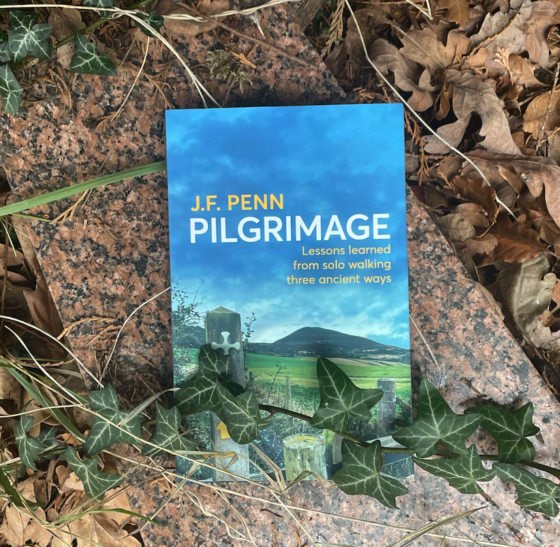
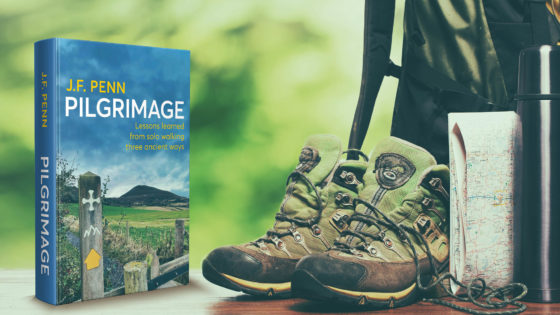
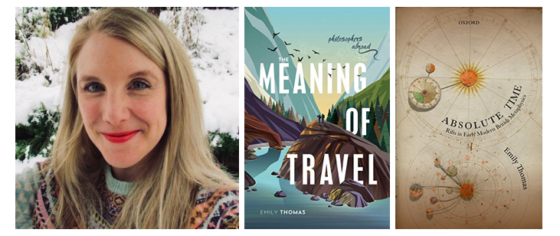
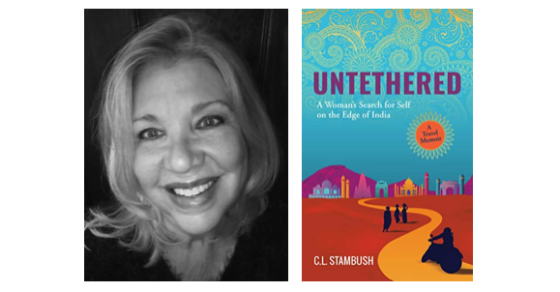
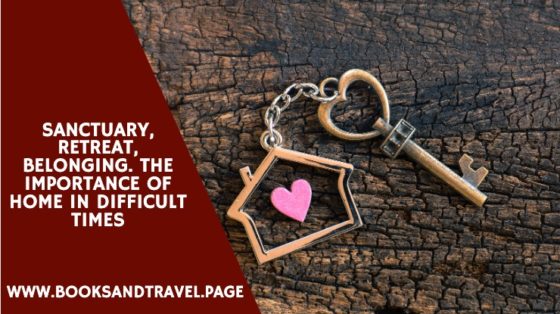
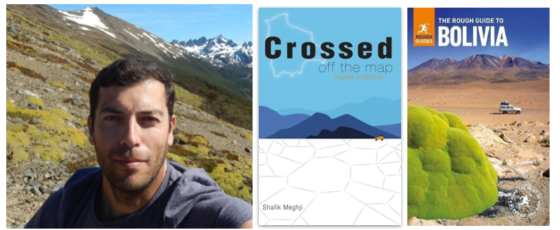
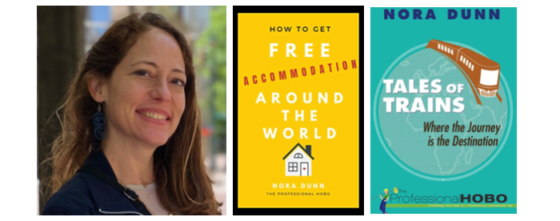
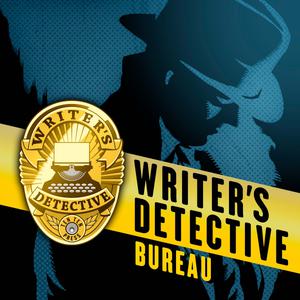 Writer's Detective Bureau
Writer's Detective Bureau
 Six Figure Authors
Six Figure Authors